Ray's Ramblings - Volume 9
Ray Kessler is a lifelong Mt. Vernon resident who has played a lot of ball, written about others playing a lot of ball and loves to wax eloquently about Mt. Vernon. We are fortunate to have access to many of his short stories and observations to show here.
We have organized the articles by the period of time Ray is referencing. This volume started in November, 2014.
Come back often, because Ray just keeps finding items to add. This is Volume 9.
2010's
World's Fair 1893
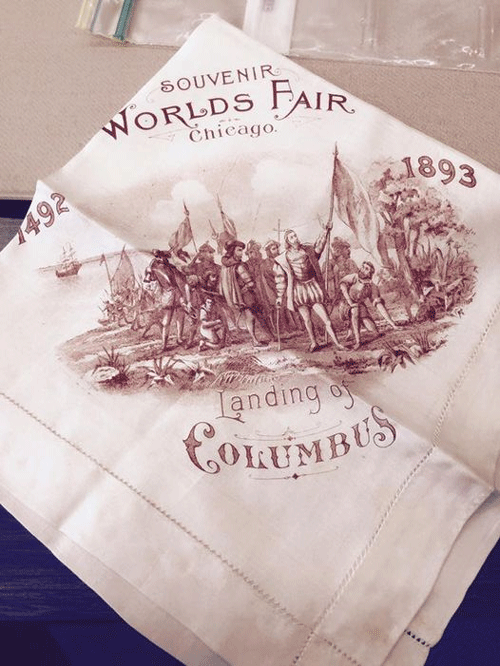
Cecil Waters shares this handkerchief from Chicago World's Fair of 1893. Many local residents went to this by railroad who held special rates. One of these was Matilda Greathouse Alexander who wrote reports of her visit to newspapers here and in Indianapolis.
Janet Orr.....February 2016
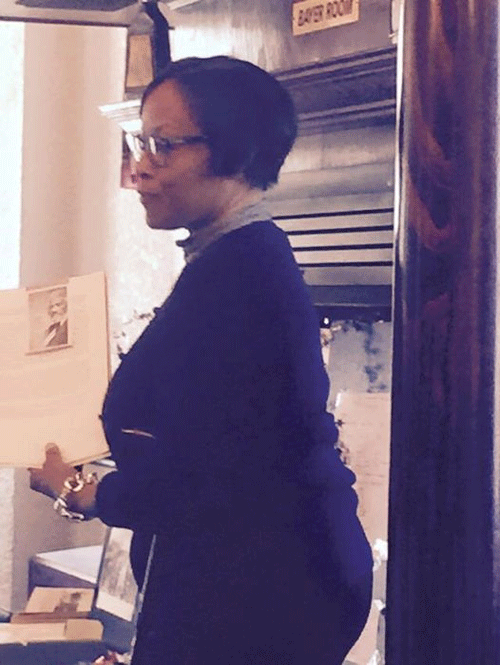
Janet Orr Spoke on African-American Serviceman at Posey County Historical Society.
2016 Bicentennial
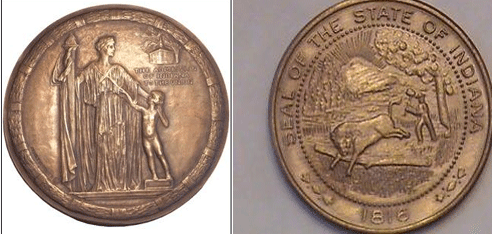
In 2016 Indiana and Mt. Vernon will celebrate their Bi-Centennial. Here are state coins from 1916 and 1966. The Centennial coin has a child representing Indiana joining the union with the Constitution elm tree and the then state capital of Corydon in background. The 1966 coin has the state shield on one side and the other is skyscrapers, silos and factories. The 1966 medallions sold for $5 back then.
Old Sullivan House
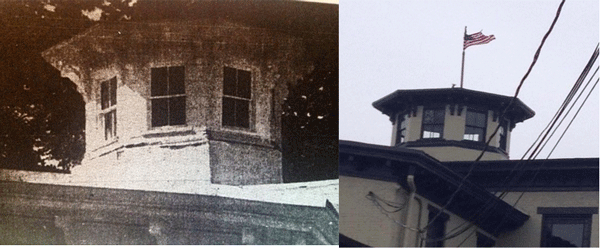
Would Love to look out these windows of what was known as the Sullivan home on East Fourth Street. They say a child accidentally was hanged up there and a bent rail on the stairs still remains. This house at 228 East Fourth is early Italianate. Built in 1860 by Edward Sullivan Others who lived here contain: Charles Parke, Benjamin Lowenhaupt, Dr. W.E. Hastings, William Gonnerman, Jr., Charles Hutson, and Robert Bayer. Bayer Real Estate took over in 1992. Butch Proctor once said there were seven or eight coats of wall paper on the 16-foot walls at one time. It was removed, and repaired with a new coat of paint. It has huge doorways and massive wood trimmings. Caroline Dale Owen Parke left writings about the house in her childhood. Mrs. Parke wrote that the inside front door of the home was a hallway, from which a long stairway went up to the second story. On the right was a parlor, a long room huge enough to have two fireplaces. Only one of the fireplaces remain. The one that was taken out had crumbled beyond repair and was made of black marble. Parke recalled there were paintings over the fireplace. At the top is a "widow's watch." Parke called it a cupola. It was used by women whose husbands worked on the river. The river they say can still be seen when the trees are free of leaves. I was told that it may have been part of the underground railroad in conjunction with Robin Hill. A signal from the boat to the cupola with a lantern was relayed to Robin Hill of incoming runaway slaves. It is just a story, but I like to believe it.
The Blackburn-Leffel Home.....2015
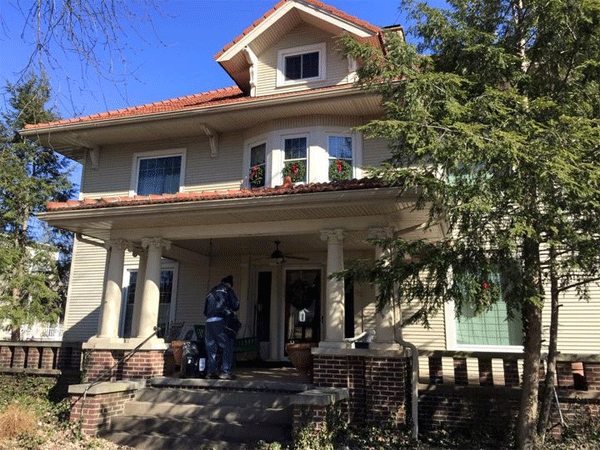
The beautiful home on the corner of Seventh and Mulberry, I believe is now the home of Bob Royer. It was built c. 1920 by James H. Blackburn, an attorney and a judge of the Posey Circuit Court. James was an early graduate of Mt. Vernon High School and graduate from the University of Michigan in 1897 as a lawyer. He was community minded and played a large part of a state highway linking Mt. Vernon and Evansville as well as getting a bridge across the Wabash River in New Harmony. The home is noted for its red terra cotta tile of not only the home, but also the garage. Around 1960 John Herbert Leffel moved into the home and stayed until it was sold in 1996. John Herbert was the county surveyor and was the son of Herb Leffel a newspaperman for the Western Star. Herb's father was John C. Leffel who founded the Western Star back in 1876 and stayed with the paper as editor for over 50 years! He also wrote the History of Posey County in 1913. Holly Leffel told me that the home had two fire places, and a full basement. There were four bedrooms, with two baths. The ceilings were 12 feet high and had a built-in bookcase in the living room. A parquet floor was in the kitchen. Holly remembers a canvas wall painting on the wall that must have gone back to Blackburn of landscape of bare trees and a road or a path leading between them. In 1968 the Historical Landmarks Foundation of Indiana rated this home "outstanding."
Offices in Hovey House.....2015
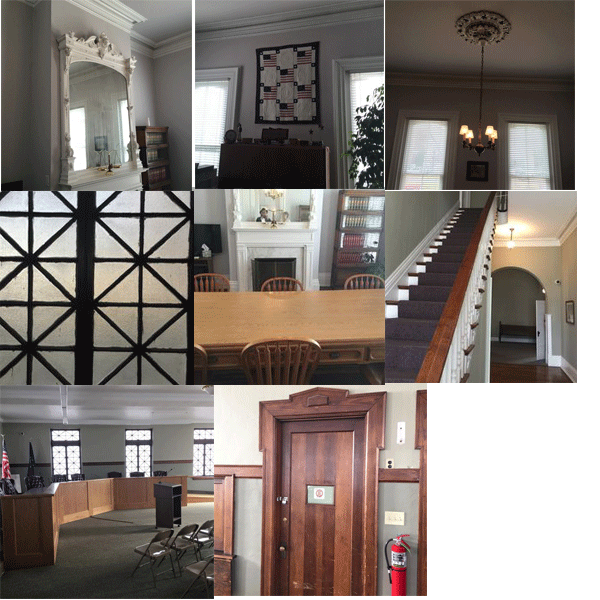
~Wavy Goes Looking for Artifacts....Finds One...I think

Today I drove up to the Water Works looking for a old lamp post that once probably was on Main Street. Becky Higgins had referred to it in a picture I put up recently. I think I found it. Next, I went down to the corner of Second and Canal looking for a hardwood Maple that was planted in 1860 by the late Everson Rosenkrans, a cashier of the First National Bank of Mt. Vernon. Reports said in the late 1920's that it had never been trimmed and although the tree was only 18 inches in diameter it provided more shade than any tree in town. On a hard rain, the leaves in the summer were so thick that the pavement barely got wet. Was so filled with hope that the 170 year plus majestic example of nature's handiwork was still there.....but noooooooo!
Ribeyre Gym in New Harmony....1924 and 2015
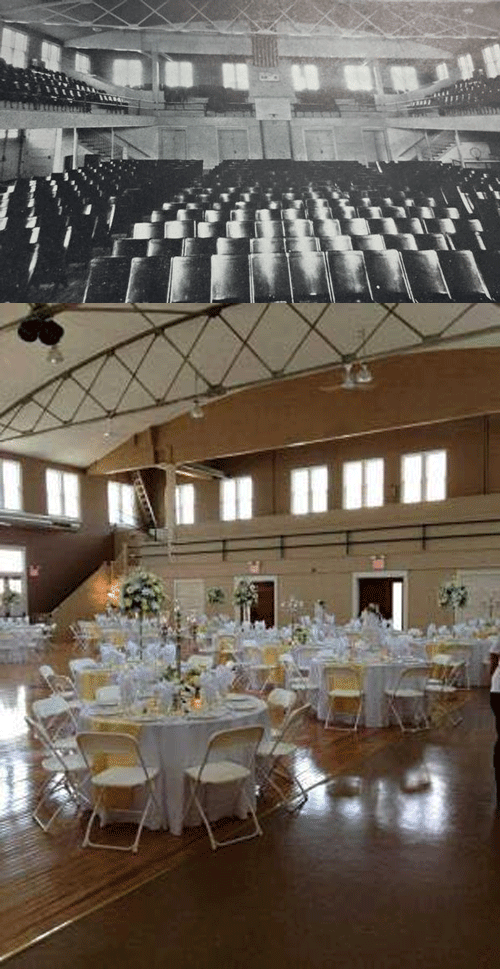
Built in 1924 it has had a wonderful history and it stands today after a million-dollar renovation for weddings and gatherings of the New Harmony community. In 1925 it served as a temporary morgue for the victims of the Griffin tornado. It was in the movie, "League of Our Own" in 1992. The last basketball game was held there in 1987. The court was 16 feet shorter than regulation and was the scene of many high scoring games. Capacity was only about 300 and fans feet on the first row of bleachers touched the out of bounds line. On one end, the out of bounds line was less than an inch from the wall!
Former Doane Property Behind St. Matthews School.....2014
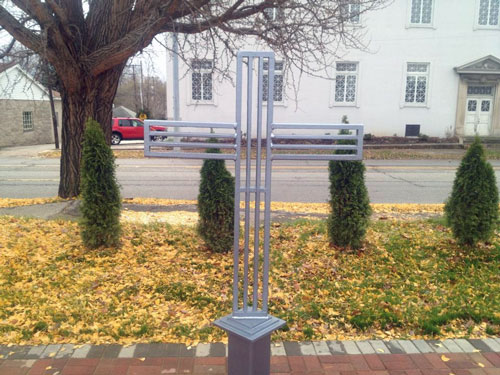
Historical Context
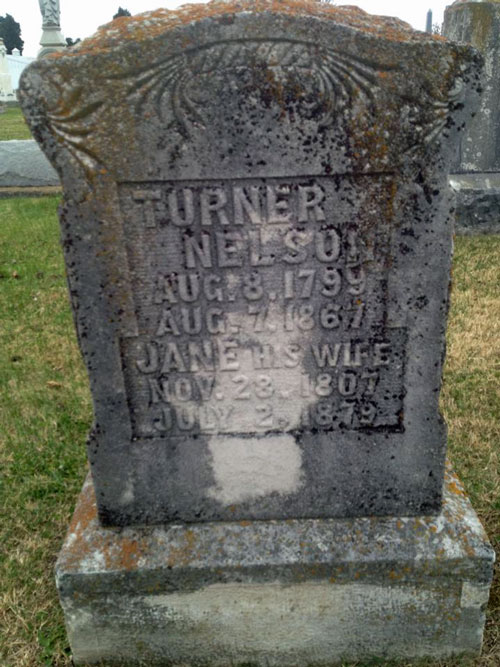
Hotel owner of the Nelson House,a Georgian structure on corner of Water and Store Streets. It was the place to stay for steamboat passengers. A long history that even includes the cholera epidemic of 1873. Turner was county clerk from 1835-1867. His son, James Matt Nelson was a commander of a Union gunboat and he lived at that corner home of Mulberry and East Fourth street.
Former MV Columnist and Posey Judge and Attorney Levco Funny In Courier Sunday.....Oct, 2014
Still reading last week's Evansville Courier and Press and in the Life section was attorney Stan Levco. I am familiar with his book, "The Best of Stan Levco" and I would read him back in the 1970's in the Mt. Vernon Democrat. He would tell about his love of the Beatles and his humor was always up front. This time I was reading of him getting an invitation to see President Obama when he spoke in Princeton honoring the manufacturing plant there. So he goes to the event and he has to be seated at least one hour before the President arrives for security purposes. Everything was normal and quiet until the last few moments before the President entered. Levco out of nowhere started to hear music which was not supposed to happen. It wasn't loud but it was loud enough for Stan and others around him to hear. He looked around for the offending party expecting the Secret Service to at any minute swoop down on them. Realizing suddenly that it was his own I phone, he reached into his pocket and pulled out the phone. It was playing..."Play That Funky Music White Boy!" He fumbles around with it having trouble turning it off, seemingly like an eternity, but he got it off just moments before the President of the United States of America entered the room. Facing 250 people, Obama praised the workers of the plant and extolled the virtues of capitalism and small business. Then he took questions. People had to be coaxed at first to stand. Levco debated with himself whether to ask a question himself. First he had to think of one in case he was called upon. A once in a lifetime chance to interact with the most powerful man in the world. Levco's mind raced and finally came up with a generic question. Not a great question, but a fair question. He would not be embarrassed to ask it. As his hand was up, several others were called upon. After about fifteen minutes he began to question if he should really ask a question. He felt he would regret his decision either way. For you see Levco said he had always looked upon people who ask questions in similar circumstances as people looking for attention on themselves more than information. Stan pondered whether he wanted to be "that guy." Here was a historic memorable time in his life and he was indecisive. If he didn't ask the question would he regret that? It went back and forth , but finally he put his hand down and decided not to ask a question at all. If the President would have continued much longer, Levco was sure he would have changed his mind again. Two weeks have gone by now or so and he thinks if he had to do it all over again he would ask the question. "I suppose that means I'm condemned to regret it the rest of my life....or at least until the next time." I thought it was a delightful funny story of human nature.
A Robin Hill Story.....2012
I was told that long ago one of the relatives of Fred Waller, the TV/Radio repairman worked as a handyman at Robin Hill. Fred told my source that there was no tunnel in the building or beside the building. About three years ago during an open tour this again was emphasized to the public. Theory is that the creek south of Black's Grove ran all the way back up to Tenth Street at one time. Long ago it was much more grown up and it "looked like a tunnel." Being called as much, the legend grew of a tunnel for the underground railroad. Even without a tunnel legend has it that the home at one time helped fugitive slaves escape the shackles of bondage. I like very much to believe the stories of them moving up Mill Creek being ferried across by abolitionist boat captains. Note from Teresa Schlarb Waller: Fred used to work there as a young boy shoveling / hauling coal every morning for their stoves. I recall he said he got paid a nickel a day or maybe a nickel a week.
Plans Announced for "The Landing" on Riverfront.....October 2011
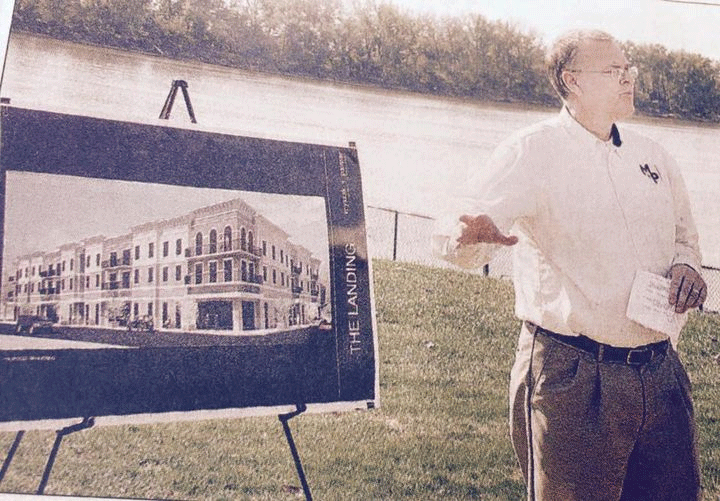
Plans announced to build a 8 million dollar residential and commercial complex in Mt. Vernon.
Belle of Cincinnati.....2011
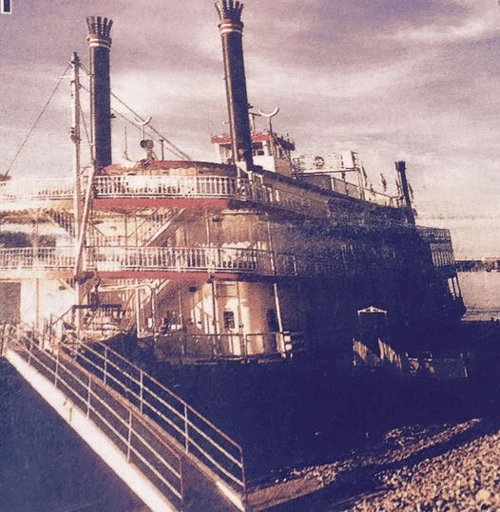
Belle of Cincinnati docks in Mt. Vernon overnight as guests are bused to Evansville to the riverboat for gambling and entertainment
Tennessee Activist Passes Mt. Vernon in Length of Ohio River Swim.....2010

Mimi Hughes, a 54-year-old environmentalist, global peace advocate, reading teacher and American marathon swimmer passed by Mt. Vernon. This lady had swum the Danube River, the Bering Strait, Draya and Mura Rivers, the Tennessee River and from Alcatraz Island to the San Francisco for various causes. She carried the Olympic Torch in 1996 relay. Her philosophy is "encourage individuality and envision change and take action, one stroke at a time." She accepts no gifts of money along the way, swimming 20 miles a day, but she gives interviews, increases awareness and asks folks to give what they can to causes she represents if they feel so moved. She started her swim at Pittsburgh and ended at Cairo, Illinois on July 17 where the Ohio meets the Mississippi River.
Confirmation of Man Thrown in Train Fire Box in 1878 Comes.....2010
In 1878 four black men were hung on the courthouse square by a white mob, one man was shot and stuffed into a hollow tree, one was cut into pieces and thrown into a privy and one got away briefly, but when caught he was burned to death in a steam engine. On August 15, 2010, Judge James Redwine and his wife Peg were at the post office in New Harmony when a man named Basil Stratton introduced himself. Basil had read some of the judge's accounts of that long ago day and wanted to pass on some information that his grandfather had told him on two separate occasions. Basil, a member of the New Harmony American Legion told the judge that he was born in Posey County in 1937 and then after high school joined the Marines. Basil's maternal grandfather, Walker M. Bennett, was born in 1868 and was ten years old when he was with four other white men at the Mt. Vernon depot in October of 1878. Basil said he did not know the names of the four white men. His grandfather told him that many whites were angry over what they believed a black man had murdered his pregnant white girlfriend. That women according to records was a white prostitute named Annie McCool who had been murdered in September, allegedly by her boyfriend because she was pregnant. Mr. Bennett told Basil that the men captured the black man near the train depot around where the Mt. Vernon Thrift Shop is located today. They threw him in the train fire box, but "because his body did not conduct sufficient heat, the train engine would not run. What was left of his body had to be removed and replaced with coal." Basil said he did not agree of what had happened, but his grandfather did. Basil "thought it was important that the truth be let out." The courtyard in those days was surrounded by a board fence. After the hangings it was reported that the next day a small boy asked if he could have his father's boots from his father hanging in the locust tree.
2000's
Posey Native American History
From 1795 to 1840 the United States made treaties with the Native Americans of our region buying chiefly (stealing) the lands for white settlers. It's complicated. Thomas Jefferson wanted to teach the Indians to farm thinking that if they learned to live off the farms, they would eventually give up their hunting grounds peacefully. Andy Jackson would have none of that as he wanted their land quickly and by 1830 our Congress passed the Indian Removal Act. Basically, treaties were to be made (no excuses) and remove the Indians from the land. By 1833 the Kickapoos were removed from Indiana. The Yellow River Potawatomi near Logansport were forced to leave resulting in the Trail of Death. By 1846 the Miami were gone. They lost their tribal status in 1897 and a hundred years later the Miami of Indiana have protested in front of courthouses trying to regain their tribal status. This was important to them because such a legal designation would bring benefits from the federal government. In 1992 the Bureau of Indian Affairs denied their request. Written records by white settlers long ago still shed light on the plight of the removal of the Indians. In 1821 during treaty negotiations in Chicago a white man wrote that Metea, an Indiana Potawatomi said "that whites were taking Indian lands so fast that the plowshare is driven through our tents before we have time to carry out our goods and seek another habitation." Governor James Ray was a negotiator of the treaties in 1826 with the Miami and Potawatomi at Paradise Spring and he said to the Indians "you ask us if we wish you to live or perish....if we did not wish you to live, had no respect for you, we should come and kill you. The numbers of our white men are like the trees in the forest, and our power is equal to our numbers. We could take possession of your country by force and hold it. " Andy Jackson said in 1835 to Congress, "as fast as their consent can be obtained, all Indians will be removed. It seems now to be an established fact that they cannot live in contact with a civilized community and prosper." During the Trail of Death, journals have recorded some details like "the horses are jaded, the Indians sickly and many of the persons engaged in the emigration more or less sick." Another wrote: "forty baggage wagons filled with luggage and sick Indians, rudely jolted under a canvas, far from protecting them from the dust and heat, deprived of air, several die." One more said, "Indians marching in a line, under a burning noon day sun, amidst clouds of dust, surrounded by soldiers who were hurrying their steps." A census taken in 1990 showed 38 Native Americans in Posey County today and 12,452 in the state. It wasn't until the 1980 census that for the first time a person was counted by the preference of race, selected by the individual. Because of that fact the population of Native Americans was counted double that of 1970. In 1940 only 223 Indians were counted in the entire state. In 1825 it was estimated that 4973 Indians lived in Indiana. That came from a book of the Commissioner of Indian Affairs of 1853. which in that year had the Indian level down to less than 766.
Before Town Benches - Stones.....1890's
Around 219 Main in the 1890's and probably before idle men would park themselves and comment about the world going by in front of them. In front of the river they would sit, in front of Fogas Drug Store they would sit chairs and in the 200 block of Main Street. In front of what was long ago the Niederest building at 219 Main and later the Arrow Caf� was such a place. A stone sat on each side of the door. Long ago they were used to sit on. I guess the management got tired of the practice and put a board on each one facing away from the door at a 45-degree angle trying to dissuade the public from sitting there. It worked for decades until the 1930's when some young genius conceived the idea that the board might be loose on one end, so up came the loose end and the other stone was inserted under the board and viola he had a seat. So now again, as the warm air heralded another coming of spring, the idle rich or poor were enabled to indulge in their favorite pastime of just sitting. Worked fine for a while until the owners chased them away with brooms and later took the stones out to the alley.
Sunken Steamboats.....2005
Near our waterworks lies the remains of two steamers...The Cotton Blossom and the Jewel that were crushed by ice at 7pm on January 5, 1918. The Jewel doesn't get much press so here is what I know about her. She was constructed in 1892 and back in the early 1900's she ran the Ohio River Line seven days a week to Henderson from Evansville. Strange thing about her was that she was sunk by ice in 1908 in Marietta, Ohio but was raised from the depths only to meet her death a decade later in Mt. Vernon.
"Wildcats Remembered" is such a Worthy Cause!
Yesterday I got the newsletter from former MVHS principal Don Goerlitz and I rapidly sent in my membership renewal of $15. I enjoy following what former graduates are doing. Did you know that through this organization $231,000 has been donated to our school? This past fall $10,108.06 was forwarded. That's amazing. According to the newsletter the use of funds has been varied. The first check came in 1995 and was used to purchase computer software. Some other expenditures have been for materials for display cases in the main foyer, plaques to honor top 10 students, a National Honor Society Banner, Books for school wide reading program, plaques for Outstanding Alumnus Program, Flags, graduation medallions, Challenge leadership programs training 80 students each year, Academic Honors Banquet, Renaissance Program for students, T shirts for "Wildcat of the Month" and Gifts for Perfect Attendance. This is only my second year as a member. I was shown the letter from a former student of Class of 1965. If you would like more information, write Wildcats Remembered 1776 Tulare Avenue, Richmond, CA. 94805. Send a check for $15 membership or more. We can all give back something. Thank you.
Hedges Cornerstone Opened.....2001
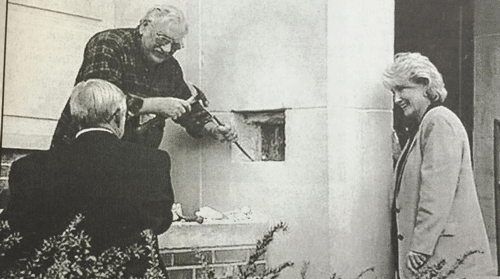
Principal Barbara Lanman-Givens looks on as old cornerstone was removed that contained items going back to the 1867 Central School. The most significant find was a picture of Abraham Lincoln. Three Mt. Vernon schools have existed on this site.
1990's
"On Second Thought," Dorothy Challman Reflects On Modern Libraries.....1999
Mrs. Challman ran several columns in the Democrat over the years. Here is an example: "Libraries are changing so fast, it's hard to recognize them from old timey ones with which a lot of us grew up. As a child and later on as a high school student, I remember especially how the librarian's sturdy desk stood guard over the small rectangular building that Andrew Carnegie, wealthy U.S. industrialist of Scottish birth, had thankfully bestowed upon our little town and others in America. Shelves full of books were everywhere and big heavy reading tables, placed in orderly fashion, filled the remaining space. And there was a certain austerity, a special silence, almost a sacredness to the place as readers walked softly down aisles of books. If you spoke to a friend, you whispered. But now, a new virtual library is at hand, a no walls library accessible by individual computers scattered throughout a community. This has also begun to happen in workplaces and a few schools with entertainment thrown in.....an alarming intrusion! Now, suddenly, the library seems more and more something to be used at a distance, a place you don't have to go to. And even those libraries you still can go to don't have a single quiet reading room. Does this wholesale shift to electronics with chirping screens give us the best form of gaining information and ideas? Are books becoming an archaic concept in mainstream American culture? Oh, the future is coming at us so fast!"
Remember Country Fried Steak at Main Street Diner?.....1991-1999
That was the diner in the old Rosenbaum building owned by Paula and Bill Sparling. It was a place where the clubs would meet....Kiwanis, Lions, Sons and Daughters of the American Revolution, and others. They would fill up on chicken and dumplings, dressing, and homemade biscuits.
Remember Clinton's Dog "Buddy?" Mt. Vernon Woman Named Him.....1997
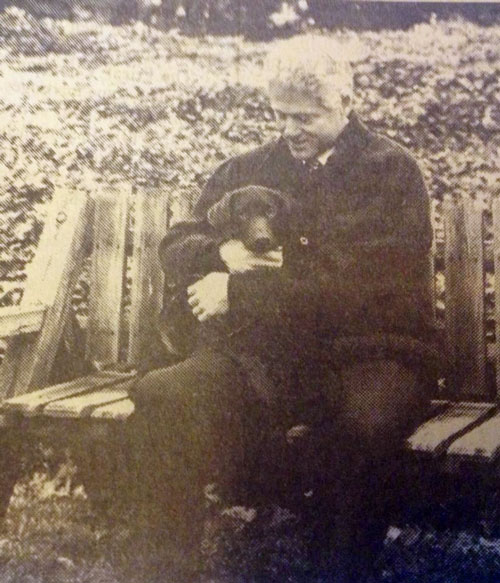
Martha Byrd was watching CNN in late 1997 when she saw Bill Clinton and his new pet, yet to be named. She sent in her name choice and in February 1998 she received a letter from the White House. "My dog, Buddy, has been a lively addition to our household, and I want to thank you for your recent suggestion regarding his name. Like so many families with a new pet, we considered a number of possibilities and then settled on a name that had a special meaning for us, and would also be easy for the dog to learn. Buddy is named after a beloved uncle of mine who died last year. He trained dogs for over 50 years and, as a child, I talked with him often about raising dogs. Because my uncle was so important in my life, his name was a perfect choice. Buddy is adjusting well to his new surroundings and we are having a wonderful time adjusting to Buddy. I thank you for your interest and for sharing your thoughts with me. Sincerely, Bill Clinton." Martha graduated from MVHS in 1955.
Son of New Harmony Bridge Engineer Comes Back For A Look 60 years Later....1990
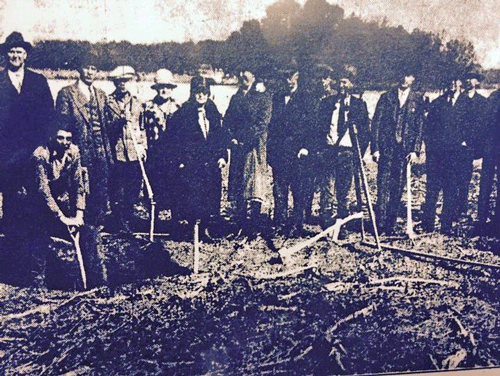
Deborah Burdick, whose work, I have admired interviewed for the Mt. Vernon Democrat, Norman Robinson who came from California to relive old memories. Norman was just a little tot when his father, Onslow was the engineering supervisor for the construction of the New Harmony-White County Bridge. Norman's memories were of eating Eskimo Pies and sitting near the bank of the Wabash River with his mother to follow the progress of the bridge. He saw his dad, "scampering about the steel beams like a monkey installing rivets." He said he remember a conversation were excavations encountered Indian burial grounds. He couldn't recall on which side of the river. The job was completed and his father and young Norman moved on to other projects, but memory and old Kodak photographs from a leaky bellows remained.
1980's
Houston Post Tribute to oil heiress Jane Blaffer Owen who invested much of her fortune in New Harmony....1987
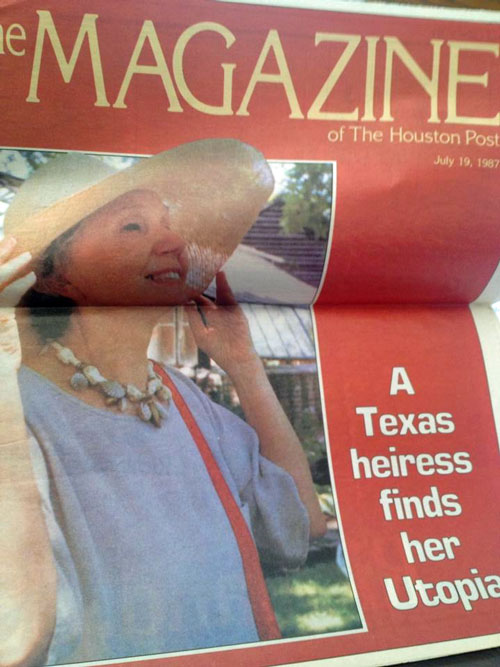
Her father was the founder of Humble Oil and her grandfather Texas Oil which became Texaco. Her husband was Kenneth Dale Owen a geologist turned oil man, rancher, and cattle breeder.
Breaking Ground for New $2.5 Million Library.....June 14, 1985
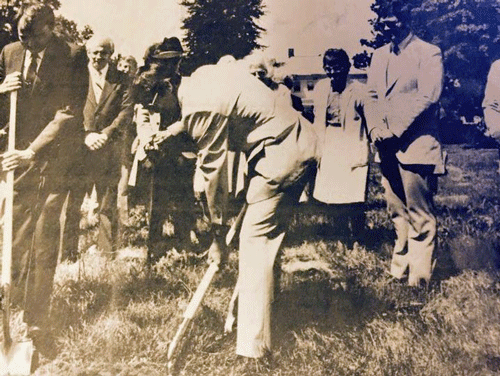
Don Barlow and Dennis Herrmann Break Ground. The new library then would be around five times larger than the old one - around 20,000 square feet and across the street on Main. Construction was financed through a bond issue and paid for by a property tax rate increase of 15.7 cents in Mt. Vernon, Black, Robinson and Marrs townships.
Computerized Warehouse at Mead Johnson, North of I 62 East.....February 1985

All the suits of the local Chamber of Commerce took a tour of the operations at Mead Johnson Park where robotic trains are dispatched to appropriate areas for unloading by man-operated forklift operators.
"This Ain't 'Gonna Look Good Back at the Office!'.....1985
Mt. Vernon got them a brand new street sweeper....cost $61,000; nice one. First day out let's go give it a spin. Whoops!....swept away by a train, yep, right down there at Second Street when it crossed the tracks at Nettleton. The driver you know he must have been concentrating on the job at hand when he heard the whistle. Too late....the train spun the sweeper around and dragged it fifteen feet. No body hurt...maybe in the pocketbook. Probably put a sticker in the cab....stop at all railroad crossings.
Ron Jones - High Jumper.....1985
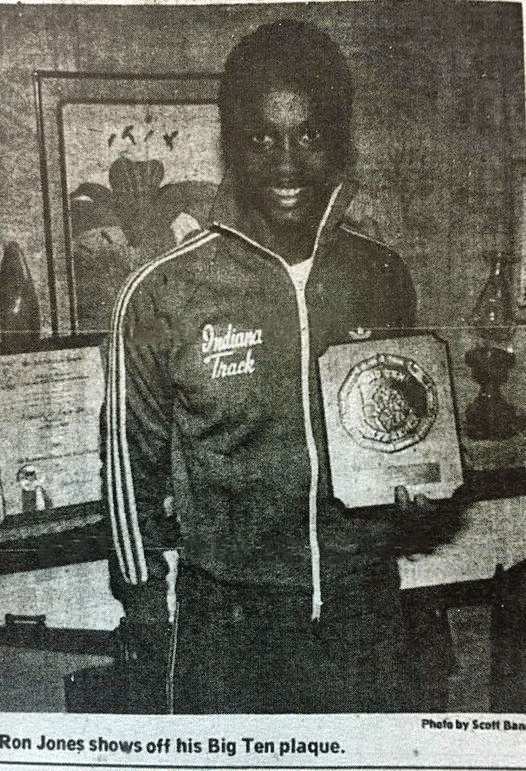
Going on 35 years later, Mt. Vernon's Ron Jones still has not been surpassed in the state record of 7'1 1/4" in the high jump. The honors piled up....State champion record holder, scholarship to Indiana University, best prep jumper in nation, All-Big 10, All-American, Second in NCAA national championship, two Olympic trials and a participant at Madison Square Garden to name a few. His best jump in college was 7' 5 1/4" in practice.
Republican National Convention.....August, 1984
During the Republican National Convention at Dallas in August of 1984, Bedford Republican Rick McIntyre, congressional candidate was introduced as the cameras panned the Indiana delegation and there was Mt. Vernon's Helen Uebelhack cheering her man. Must have been a sight - a cattle drive, welding manhole covers for security, a 5K run of Women against Reagan, people asking directions to the Grassy Knoll, a heightened police presence everywhere and of course delegates in crazy hats. Goldwater gave a speech and Lee Greenwood sang his song...you know which one. Reagan was nominated unanimously on a roll call vote. G.W. Bush almost was unanimous for vice president losing only two votes, one to Jack Kemp. Radical Yippies made their last headline as a group running through town calling against corporate war chests.
Penguin Point.....1984
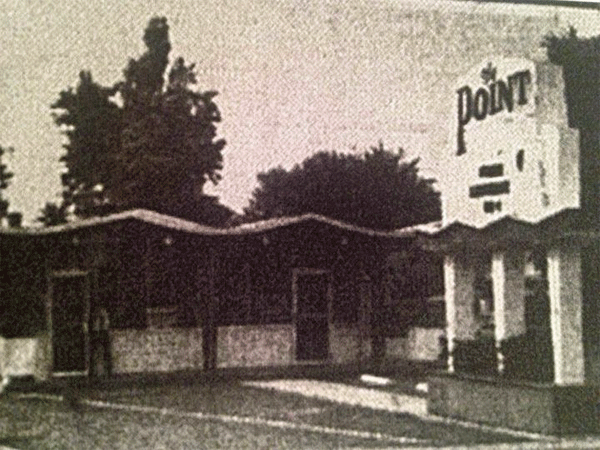
I don't recall them changing the name just to Point.....they should have sold a " hippie hippie shake"....marketing you know
College Park.....1984
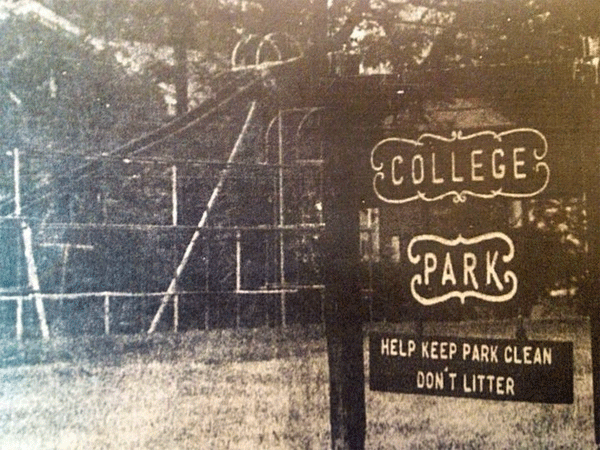
Town Turns Against Elk River Coking Plant.....1984
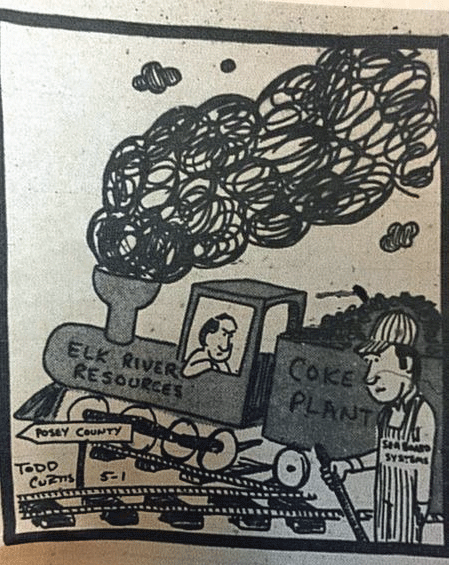
I remember when the Retired Teachers Association, I believe that was their name, came to my door and wanted me to sign a petition against it. There stood Miss Redman. I laughed and told her I never pictured her as an environmental activist...."gimme that pen!" During the time of the Elk River controversy the editor of the Democrat, Bill Brooks wrote an editorial about objectivity and the free press. He announced that his newspaper no longer held objectivity as its primary goal in reporting the news of the day because it was impossible and not even desirable. It started when reporter Don Johnson, was publicly scolded for interpreting the events at a public forum. He went on to say that if Councilman A says 27 things during a meeting, it is his responsibility to quote or ignore what is important to the public or not. A newspaper has responsibility to report, but it uses objectivity in like not printing the names of rape victims even if by law the names are given to the press. A reporter's job at "this newspaper" is to inform the readers about the important events of the day. We must supply the sense and substance of the day's news...the arguments, the rebuttals, the explanation, the criticisms. All fall outside the definition of objective reporting." He said that those priorities do not fit everyone's values systems. "We analyze the events and establish priorities." Very few citizens ever attend public meetings. The press becomes the eyes and ears and many times the conscience to scrutinize and dissect the events to the readers.
Dan McNamara.....1984

You can find Dan and his beautiful wife Angie Handel, both Mt. Vernon High School Hall of Famers at the MAC Center just east of Mt. Vernon. Dan was a good basketball player and a even better baseball player. I have heard the story how he hit a baseball out of Evansville's Bosse Field in right field and cleared the street! He went on to be All-Confernce OVC for Murray State University. Good guy. I would watch him hit in the batting cage at the MAC and the sound coming of his bat was explosive.
Kiwanis Fund Raiser.....1983

It's autumn and the nuts come out to play. Practicing their sales pitch these Kiwanians Wayne Stoval and Bill Brooks get their pigeon Nancy Gibson. According to the Mt. Vernon Democrat their technique was for Brooks to stop traffic with his feet doing peanut juggling just long enough for Wayne to make the sale. After a little more practice they took up their usual stop at Fourth and Main Streets.
Hawk's Bar & Restaurant on Main....1982
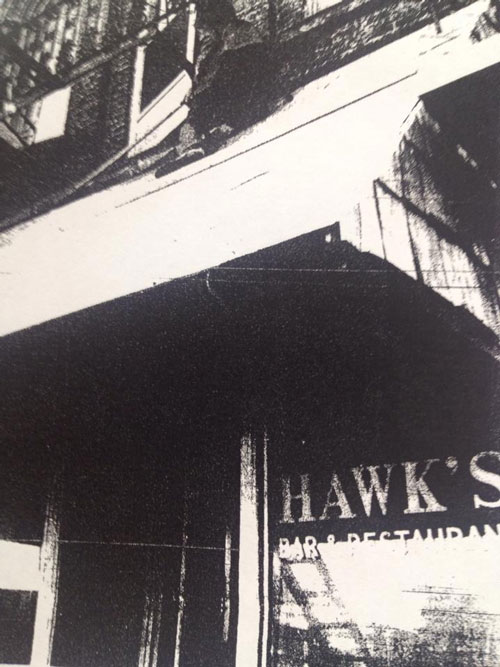
With Rock Music Blaring Over A Speaker, College Kids Push Keg from New Orleans to Milwaukee for Charity.....1982
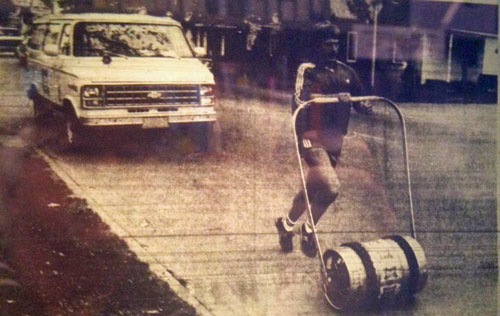
There they were heading down Fourth Street in Mt. Vernon five college students taking turns pushing a barrel in three mile shifts 2000 miles raising awareness for St. Jude's Children's Research Hospital. The Tau Kappa Epsilon fraternity urged on by head banging long hair music pushed on while raising over $250,000 in pledges too. They average about 50 miles a day they said and denied that they empty the keg each night and fill it back up each morning. Rock On boys! "You got to fight for your right.....to party."
Judge Steve Bach in 1982
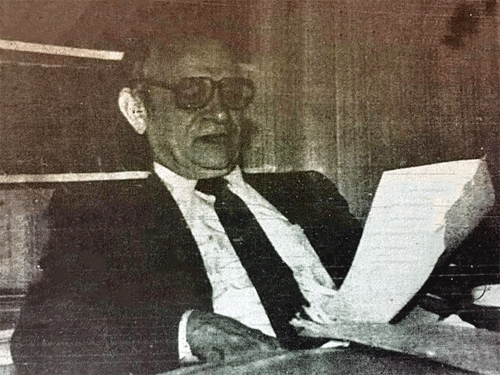
Came to Mt. Vernon in a private practice in 1954.
Governor Orr Honors Malcolm Fuhrer.....Early 1980's
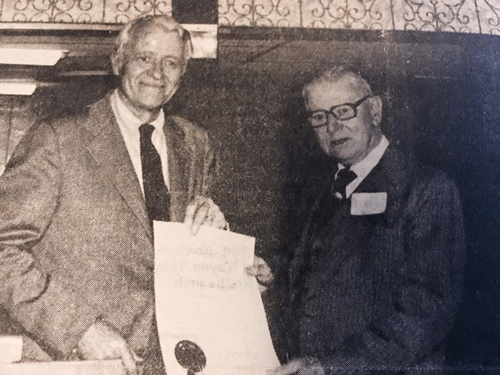
The local Chamber of Commerce met for their annual dinner, this time at the Southwind Smorgasbord and one of the items of business was honoring Malcolm W. Fuhrer as honorary president of the local chapter for "his dedication and many fine contributions to his town and community." Way back in 1922, Fuhrer had been elected president but had to decline because of extensive business travel. Fuhrer always regretted that he couldn't serve in the position. Orr said, "It's high time Mac is put into that role," and presented him a certificate and gavel to the local businessman. Mac received a standing ovation and was quite emotional of the unknown honor that was he was surprised with that evening. Orr later praised Mt. Vernon for its schools, computers in the middle school, the Southwind Maritime Centre and its future growth and importance.
1970's
Welborn Clinic-Posey County Ribbon Cutting.....March 1978
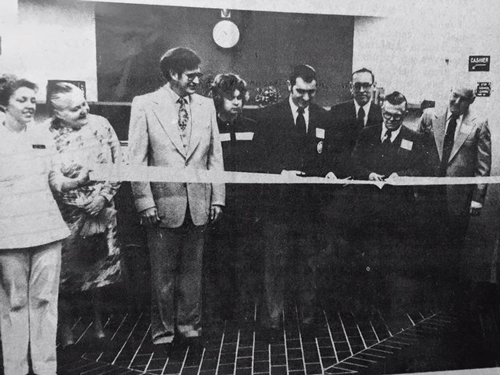
L-R: Medical Secretary Jeanie Ricketts, Rev. Mrs. Ann Melanson of First Presbyterian Church, Donald Gent the executive director of Welborn Baptist Hospital, Marty Randsford, Dr. Drake Lehmann a medical administrator, Quention Gwin President of the Chamber of Commerce and Mayor Jackson Higgins in the center cutting the ribbon. The clinic actually opened on January 1, 1978 during the great blizzard. My wife was an emergency nurse there until it closed and then she transferred to Welborn Hospital for 20 years until that closed down. She now works as a family practice nurse at Deaconess Family Practice on the west side of Evansville.
Danny Burgess Stamps Prices at Lutterman's.....1978
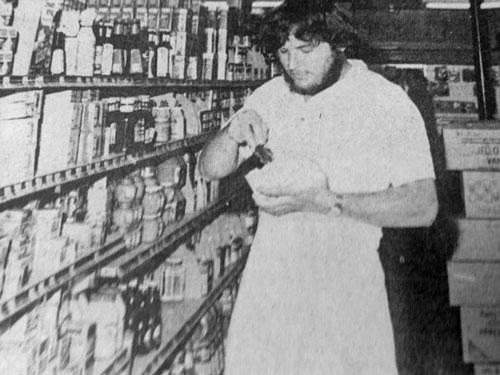
Malcolm Fuhrer.....October 1977
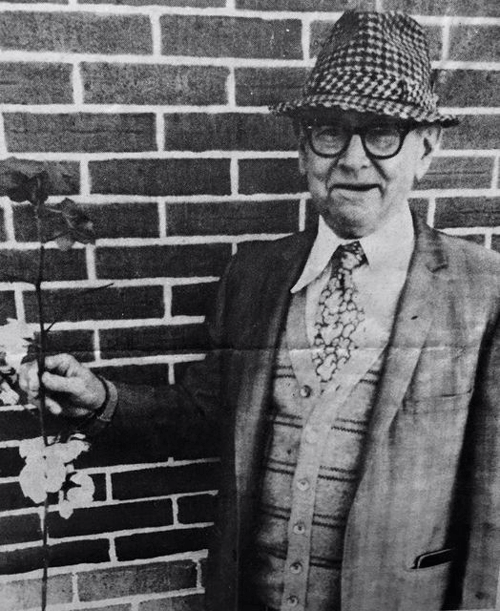
Malcolm Fuhrer with a holdover from many years of growing cotton in his backyard at 513 Walnut Street. Nice Bear Bryant Alabama hat too.
John Doane photos known as Uniontown Locks and Dam now John T Myers Locks and Dam

Construction began in 1965 and opened in 1977. Named after Republican congressman Myers of the 7th congressional district.
"This is how we do it"....Parrish Flying Service....1976
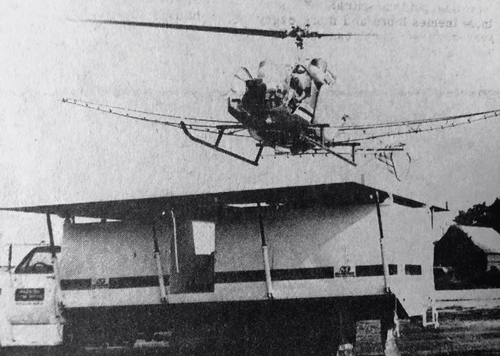
The photo shows Frank Parrish landing on his portable loading station used during field work. The truck helped keep down dust while loading chemicals. The station was twenty feet long and seventeen feet wide when sides were hydraulically lifted. Frank came to Mt. Vernon in 1960 and ~Wavy use to get a haircut from him on East Fourth Street until the Beatles found America ("turned left at Newfoundland"). In 1965 Parrish became a part time flying instructor and by the time of "Hey Jude" in 1968, Frank shelved the barber gig to become a full time agricultural and industrial flyer. He had Steve Curtis with him then as the chemical man and Jack Chappell as a mechanic. Thousands upon thousands of hours were flown over crops dodging power lines. Helicopter flying came around 1970, just in time to see Bull Island from the air. Come on folks, somebody surely took photos!
New Football Field - 1972
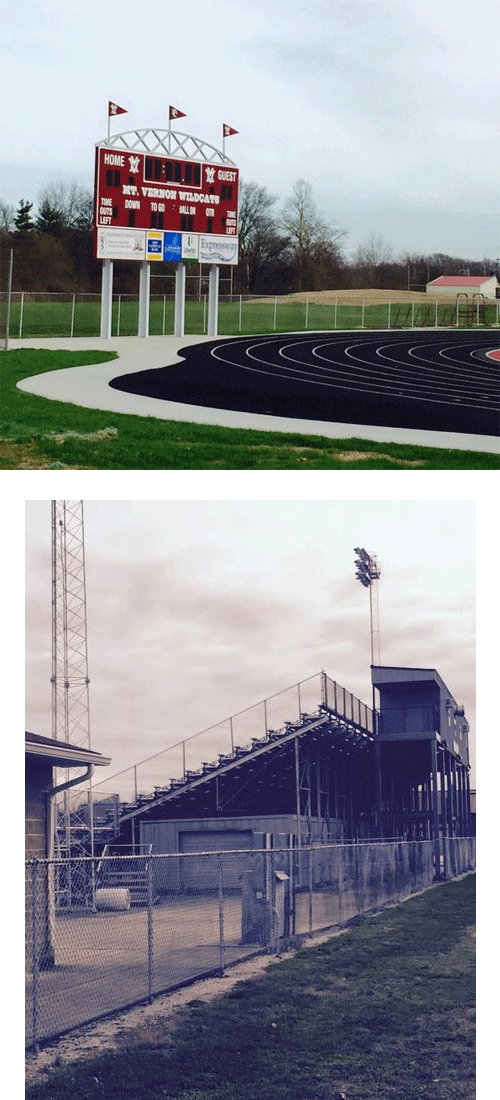
The last football game played at Athletic Park in 1969, Mt. Vernon defeated Castle 24-14 when Tom Weiss ran 144 yards on 31 carries reaching 1077 yards on the season. He had three touchdowns that day from 16, 1, and 14 yards out. Mt. Vernon had a conference record of 4-2 that year going 4-6 overall. Bob Roby named All Conf first team as defensive guard. Honorable mention were Tom Weiss, Bruce Heriges, Randy Boyer, and Tom Hoehn.
1960's
Reuse and Recycle....1969
In June of 1969 the Mt. Vernon armory was converted into a skating rink. Pledges were taken from individuals and businesses for a new suitable floor. Some of those boards of the floor are now utilized in the home Bernie Moll is restoring on Walnut street behind the coliseum.
Third Party Presidential Candidate and Segregationist George Wallace got 1204 votes in Posey County in 1968
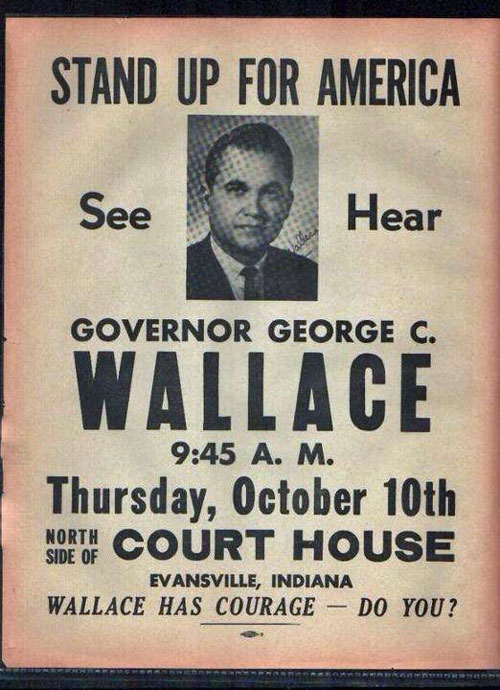
Oh Georgie....I can still see you on the steps opposing integration saying, "Segregation now segregation tomorrow, segregation forever." He held onto those beliefs until an assassin put him in the wheel chair the rest of his life and when facing his maker he renounced his previous statements. In 1968 he won five southern states, getting 10 million popular votes and 46 electoral votes. He like Nixon ran on law and order in a chaotic time. He did have a plank I liked....."If the Vietnam War is found to be unwinnable in my first 90 days of taking office, I pledge an immediate withdrawal of United States troops." Of course his running mate was Curtis "Mad Bomber" LeMay of WWII fame or blame. LeMay made a statement during the campaign that we should consider using nuclear weapons in Vietnam. Wallace's first choice for Vice President was former baseball commissioner "Happy" Chandler but he withdrew the offer when people brought up that he was the commissioner when Jackie Robinson was let into and desegregated baseball. His second choice believe it or not was Col. Sanders....."A chicken in every pot." Wallace and hippies didn't get along either. Wallace said only two four letter words hippies do not know are W.O.R.K. and S.O.A.P." He said the first long haired anarchist that lies down in front of my limo will be the last one he sees.
Dennis Mercer working at Mt. Vernon Drive-In .....1968
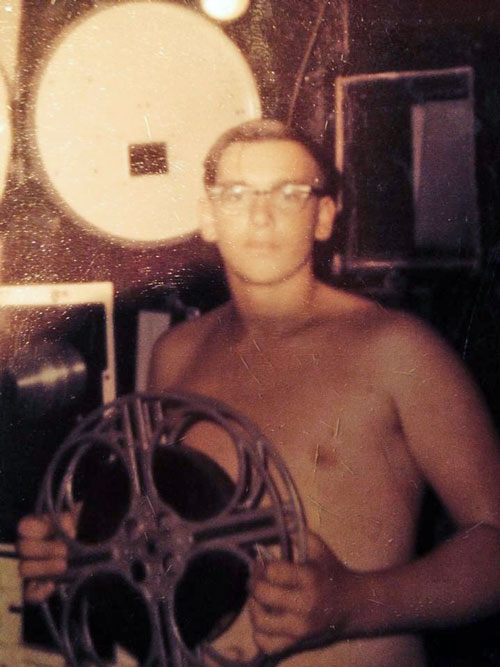
Heavy Hitting Double I League Action.....1967
The Frank Moll Indians defeated Princeton 17-11 in the night cap of a double header with 20 hits. RBI leaders that game were 6 by Jim Howard and 4 by Gerry Allyn. Howard and Jerry Rutledge homered. The record for runs in a game was in 1959 when St. Phillip defeated Union Township 28-1. That was the last year that Mt. Vernon won the pennant.
Dr. Challman Remembers the 1930's and Mt. Vernon.....1967
1967 was the year Dr. William Challman and his family left Mt. Vernon after coming here in 1932. When they moved here there were eight doctors practicing: Jenkins, Doerr, Sugg, Emmick, Ranes, Fullinwider and Hardwick. Challman opened an office upstairs on Main Street and began his practice of medicine. This was the height of the depression and money was scarce. He sometimes didn't get paid at all and other times was paid with meat, fruit and vegetables. In that time doctors made country calls to Point township, and to the eastern and northern parts of the county as well as the homes inside Mt. Vernon. When World War II came doctors went into the military and a shortage occurred. Then most patients came to the office. Telephone service was different then as patients would call and sometimes you could barely understand them or they would forget to leave their name or address in an emergency. The local telephone exchange operator would then say that the last call was so and so and lives and such a street. In those days before antibiotics, pneumonia was more prevalent. He once visited a woman on the Kentucky side of the Ohio River, being rowed across the river in the winter, then picked up in a horse and buggy and taken to the house. Dr. Challman said he returned several times from trips frozen like an iceberg. He worked with refugees during the 1937 flood at the Coliseum in a ten-day period. Over 400 people were there each day. Cars drove around town with loudspeakers asking residents to donate blankets and anything to help the people. Mrs. Challman helped deliver a baby at the Coliseum and the mother named the child Dorothy after her. Also, in 1937 the Challmans visited Europe where he had some special training in Vienna. The house he stayed at was bombed by the Germans during the war. He visited Germany in 1937 to see a relative and he was already a stormtrooper. He recalled walking down the streets with him and everyone would salute and "Heil Hitler." Everyone but Dr. Challman and the Germans glowered at his lack of enthusiasm. He visited Berlin and said it was beautifully decorated every night and bands played on every corner. Unterdunlenden was the most beautiful street he had ever seen. After the war it was all gone, disappeared on the other side of the Brandenburg Gate in East Berlin.
Mt. Vernon Democrat Editor's Reaction to GOP Off-Year Victories.....1966
Garth Whipple picked up the telephone and on the other side was Clinton Maurer, Mt. Vernon's "Mr. Republican." It was 1:30 in the morning and Clint, the Republican county chairman wanted to gloat. "You can't call me Clint anymore," he said, "now you must call me MISTER MAURER!" Clint wanted to know about what size headlines to expect in the next edition of the Democrat about the GOP victory. Garth said, "I'm leaning very heavily in edging the entire paper in black! Goodnight." That was the election Roger Zion won congress and Joel Deckard Joint State Representative. By the way, the Headline read: "Republicans Make Shambles of Off-Year Elections....Zion, Kramer and Deckard Outscore Democratic Foes." Locally we still won some county officers including Donald Miller as Auditor. Miller was the same guy who gave Robert Kennedy a dollar bill when campaigning and jokingly told him to get a haircut. RFK pocketed the dollar.
Remembering Cold and Wet Baseball Practices....1966
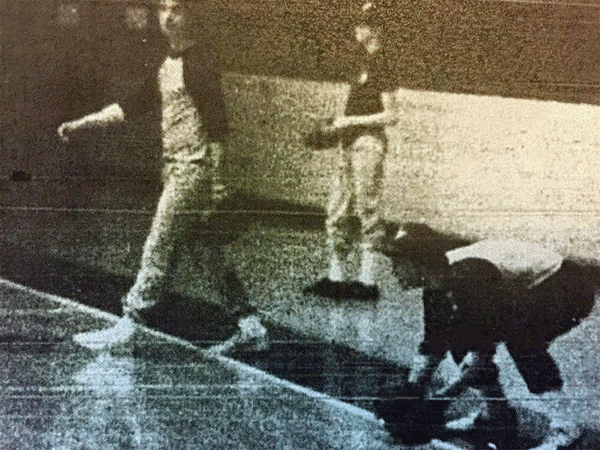
Back in the 60's I bench warmed for one of the better baseball teams we ever had.....the 1966 Wildcats under coach Gerald "Chummy" Jeffries. They lost two games. With Ed Howard on the mound, we could shut down anybody. Right after the varsity basketball team was eliminated from Sectional play, we would begin our workouts. We ran the bleachers and the horseshoe, then we would loosen our arms. There was something about throwing inside with 30 guys or so with all that sound of mitts catching that throws off your timing. It's unnerving and unnatural. Balls would get away and you would duck under someone else's throws retrieving it. If the coach wasn't looking there was always horseplay from the upper classman who had their jobs secure. Jeffries would hit us grounders in there too, which I thought the basketball coaches would not appreciate. I can remember taking grounders on the asphalt outside in the parking lot too. Those hops kind of make you gun shy! We would come in close to the end of practice and we would line up for wind sprints of the length of the floor. We would be in groups...pitchers, catchers, infielders, then outfielders. I was an infielder. You would run the floor then walk back along the sides. After a few of these it seemed like coach was saying, "infielders, infielders, infielders." Then he would say ok, "win your heat and you can hit the showers." Well, that didn't do ~Wavy no good! That meant I might have to run another 10 sprints until it was just me and Jimmy Estes left. It was close, but he nudged me out and of course, if you know Jim......you never hear the end of it. To this day when I see him, he says, "you can't play no ball!" I don't know why but he always made me laugh. In those days right field was a swamp, we had no grass infield, or a outfield fence. We had a cinder track running through the back part of the infield and through right center field. There was also a light pole and a tree. The dugout was basically chicken wire and if you were not playing it sure got cold sitting on the bench with only a windbreaker in those days before global warming. I was always trying to warm up pitchers behind the concession stand or while the catcher was putting on his gear. Bench warming sucks. Mr. Jeffries got tired of some of my coaching comments and gave me the scorebook of which I was good at. I sat right beside him. That didn't work out too well either. One day he said, "Ray if you want to coach, do it at first base." Anything to get off that bench. Game over, collect the bats and carry them across the street in a duffle bag. You got to start somewhere. Once the coach told me...." I was going to put you in, but I could not find you." I said, "I was warming up Rheinhardt." Oh well. Two decades later our George's Stucco House hosted a tournament to raise money for our team. It was a old timer's tourney. It had the old Stucco House team that won State, Regional and maybe even national tourneys. They were all in their late 30's and early 40's and you could still see the talent. They won that tourney too. The second-place team surprised me. It was local players who played Double I League ball in the 1950's and 60's. Out that long and they could still play. Art Hall and Mr. Jeffries played. I was umpiring home plate and Gerald took ball one. The catcher looked back at me. Jeffries took ball two. The catcher looked up to Chummy as said, "What do you have on him?" Coach said, "he used to play for me." I said, "Not much! Don't take anymore, be swinging." He had to step out.....laughing!
Blankets Passed for Charities.....1960's
I do not attend as many local basketball games as I once did, much to my shame. I was looking over my first book, "From Brownies to Wildcats" when I recalled our cheerleaders...Patty Moll, Cathy Ozinga, Brenda Villines, Debra Hartmann, Carolyn Russell and Marie Weintraut holding up a blanket to the crowd and people would throw in coins for the March of Dimes or some other great charity. Always some coins would roll around across the hardwood and the reserve cheerleaders would pick them up. I told you I was big on cheerleaders didn't I? I'm sure I did. Matter of fact, I can't remember seeing any of those March of Dimes coin collector fold outs in businesses anymore. I think that was started during the FDR administration. Oh well, memories....support your charities, your teams and your cheerleaders.
Mt. Vernon Students See Watts Rioting in August of 1965
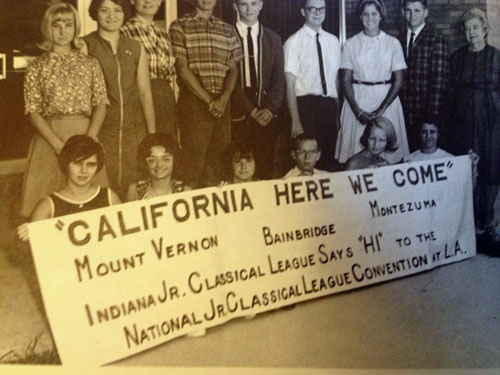
Fourteen Mt. Vernon High School students, who were Latin students and members of the local Junior Classical League attended the National JCL convention on the campus of UCLA and had a firsthand look of the riots on their way home. The pupils were with their sponsor, Mrs. Florence Kouts. The riots spread to the campus and all the girls were locked in one dormitory and all the boys in another building. From windows they watched the burning of cars and buildings. When they left that next day by bus at 4:30 a.m. they learned later when they arrived in Phoenix, Arizona that rioting was bad an hour later on campus. The next day the students saw Carlsbad Caverns and then headed for Juarez, Mexico. The Mt. Vernon group included: Phyllis Rohlman, Amy Vollmer, Nina Marie Kelley, Joe Moll, Beverly Imsande, Evelyn Scherer, Deborah Hatch, Mary Lou Dick, Susan Cox, John Russell, Steve Dick, Larry Gregg, Ann Atkins, Charles Scherer and Mrs. Kouts.
New Harmony Designated National Historic Landmark.....1965
In August of 1965, conservative Democrat governor Roger D. Branigan stood with the Secretary of the Interior, Stewart Udall under the shady elms of Workingmen's Institute as New Harmony became the seventh city in the state to be recognized as a Historical National Monument.
~Wavy Raps with Former Mayor Higgins on National Guard Training in Puerto Rico.....June 1965
I sat down with Jackson Higgins this morning about when he was Captain Jackson L. Higgins, commanding officer of Battery B National Guard and his 15 days of field training in Puerto Rico. Every time I see Mr. Higgins, he greets me with..."Here comes trouble with a capital T." Jack told me they departed from Evansville airport with Company B (Mt. Vernon), Company C (Vincennes), Company A (Princeton) and the Evansville unit on planes provided by the Air National Guard of Pennsylvania and Georgia. They were C87 Boeing Strato-freighter and C121 Lockheed Constellations. The flight from Evansville to Puerto Rico took about 8 1/2 hours, non-stop with assault rations eaten for two meals. On arrival at Ramey AFB in Aquadilla Puerto Rico the battery moved to Salinas on the southern coast at Camp Santiago. Here they trained with 105mm artillery firing from about five miles away. At the same time the Hoosiers were on the island a like number of soldiers from Puerto Rico were sent to Camp Grayling, Michigan for training. Jack said he got to spend the weekend in San Juan viewing the sites. The following year during drill, Mr. Higgins was growing his beard for the local 150th anniversary of Mt. Vernon and showed up with a beard. When asked what it was all about by a commanding officer, Jack told them he was a "brother of the bush." I guess that didn't go over well with the brass and he shaved. Because he did when he got home, he was tried by the local kangaroo court of Mt. Vernon for breaking his vow and was put in the stockade on courthouse square until he was bailed out. While in the stockade, someone threw in lighted fire crackers!
Meter Blossoms.....1965
A new idea to beautify city streets was conceived by Ralph Staple's Foundry of 711 West Second Street. He invented an apparatus to hang flowers above parking meters to put "color and sweetness" into our daily lives. They were used sparsely on the east side of Main between Fourth and Fifth streets. Two were located in front of People's Bank and Trust and another was perched atop the meter at Norton's Key Market......It was the 60's you know. No statistics on if it cut down on parking violations or if the idea expanded.
99 Year Old Republican Votes for Democrat for First Time.....1964
The father of Helen Elliott of New Harmony was born in 1865. He had voted Republican in every election he had been eligible to vote for and he had only missed one in his long life. In the primary of 1964, his limited vision resulted in his daughter helping him with the ballot. As the general election approached he decided he would for the first time ask for an absent voters ballot. When it arrived he told his daughter....."Now you do this exactly as I tell you, Helen." He said he could not support Barry Goldwater the Republican for his stand on Civil Rights. So he said, "Vote for Lyndon Johnson for President and the rest of the ticket Republican." Here he was nearing the century mark breaking from the party he had always supported with his traditional views. His explanation was "the Civil War has been over a hundred years. It's time the Negroes had their rights!" He told his daughter that as a small boy right after the war he would see the Negroes here on steamboats and on the river bank loading and unloading sacks of grain. They would be dressed in a single garment, made of a gunny sack ending at the knees; they were barefoot in the cold weather. An overseer stood nearby with a whip and would use it on any who lagged behind in his load....after the Civil War mine you! Even as a small boy this was terrible to him. He remembered racist talks of citizens. He recalled someone asking him whether he would have his children go to New Harmony or Mt. Vernon schools. A man said if they went to Mt. Vernon he might have to sit with a n*****. Mr. Elliott said, "well I sat in a double seat about 90 years ago with a little Negro boy right here in New Harmony and I never thought it hurt me any."
A Story of Registering to Vote in Mt. Vernon.....Early 1960's
This story was given to me awhile back and after watching the movie Selma yesterday, I feel now is the time to tell it. I will not use the names...some people are still alive. I wish not to embarrass them who may have changed their attitudes. It seems it was Election Day and General Electric was a new plant in Mt. Vernon. One of the supervisors let his people off early to vote. A black lady stayed behind. When asked if she was going to leave to vote, she said she was not registered. Soon it was found that she had not been allowed to do so. The supervisor was upset. He checked with other minority workers and found none were registered. He got on the phone and called the Mayor, school officials and city council members and said meet them at the court house. "These people WILL be registered!" He told them that one of the reasons GE had moved here was the work force and they had made a commitment to minority hiring and if the community was not behind them it was not too late for the company to find a new site for their money. The men and women were registered.
"Gentleman Jim" Country Singer Dies in Plane Crash Heading to Mt. Vernon.....August 1964
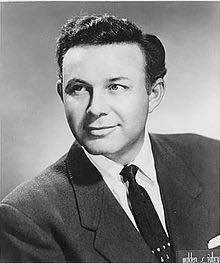
Jim Reeves was a popular country and western star who was killed in a private plane in route to Mt. Vernon that crashed in Davidson County, Tennessee. Besides Reeves, his pianist Dean Manuel was also killed. The two were heading here to visit with Francis Knowles and family. Knowles learned of the crash by listening to a radio broadcast.
"Von Tri Luftballoons"....It's a Bird, It's a Plane..It is a Blimp!.....July 1964
A blimp full of thousands of dollars of instruments was lassoed by Oscar Seifert when it flew low over his soybean farm. The blimp was 55 feet in length and 15 feet in diameter. It was one of three balloons that broke loose from its mooring in Ft. Wayne, Indiana. The other two were caught right away. The blimps were part of air pollution experiments over Indiana. This one flew 250 miles to Marrs Township when it was hogtied and attached to Seibert's pickup truck. Oscar was painting his house when he saw the blimp approaching. It had been in flight 12 hours.
Dancing at the Mt. Vernon Drive-In.....1964
On Friday nights starting in May of 1964, owner Paul Love announced that there would be dances preceding the screen programs. The first one had the band "Wanderers" playing a rock n roll combo composed of the Chaffin and Gibbs brothers. The movie that night was Elvis Presley in "Kid Galahad."
Home Razing Bares Old NY Newspaper.....April 1964
Two copies of The Independent, a newspaper published in New York between 1848 and 1928 were discovered in the studs of the Leonard Home (not sure of location) razed by then present owner William H. Keck by Clarence N. Miller. The house was built they said in the 1850's and the date of the issues were from 1876 and 1877. An advertisement in one showed a Winchester rifle, which stated, "perfect for those living on the Indian frontier." The paper was founded to promote Congregationalism and was a voice for abolitionism and women's suffrage. It published poetry of literary people like Elizabeth Barrett Browning, Harriet Beecher Stowe, and John Greenleaf Whittier and reached its zenith of publications in 1870 with a circulation of 75,000. My thinking this might have been the Frederick Leonard home. He was from a family that had been in Mt. Vernon since 1834 having graduated from high school here in 1875. He graduated from Indiana State and was in the literary department. Later went to University of Michigan and studied law in the class of 1881. He came back to Mt. Vernon and for 33 years he was a member of the Posey County bar. Like his father he was a Republican. He served one term as Mayor starting in 1892.
Police Cruiser Keys Taken.....February 1963
This is the city...Mt. Vernon, Indiana. He works there, he carries a badge.. .his name? Patrolman Kenneth Terrell. It was cold, rainy, dreary morning about 3 a.m. and the patrolman stopped in to Helen & Totties's Cafe...100 block of West Fourth for a cup of coffee. It's tough being a cop, all at once you lose your first name. You're a cop, a flatfoot, the heat, the fuzz and when you walk somewhere the temperature and conversation goes down 20 degrees. While finishing the warming coffee the copper finds that his cruiser keys have been taken. You work all night on stakeouts and this is what you get. You go back in, use the telephone, call the chief and say you have been robbed. Anxiety and frustration builds as you get help to push the car to the Police Station. Oh the humiliation! And paperwork? Oh, you'll file a report when you are right and when you are wrong and when you aren't sure. Not an easy life being a cop.....but I am damn glad to be one.
Talking baseball.....1963
Mt. Vernon American Legion Baseball Strikeout Record is 22 by Carl "Windy" Wade with 22 vs Ferdinand in 1963 and second best is Eddie Howard's 21 vs Vincennes, a one hitter in 1965. Earlier that same season Eddie threw a no-hitter and struck out 20 vs Mt. Vernon, Illinois. Wade threw three no hitters in high school, two in a row. Ed I believe only lost one game in four years of pitching for Mt, Vernon and that was a one run loss to Princeton in extra innings in his freshman year. He "could bring it!"
"Me and my Shadow...".....1963
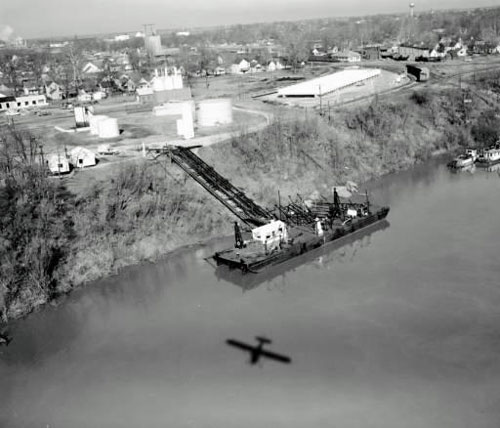
My father worked at the Farm Bureau river dock from the early 1950's until 1981. This 1963 photo by John Doane.
Progress in the 60's
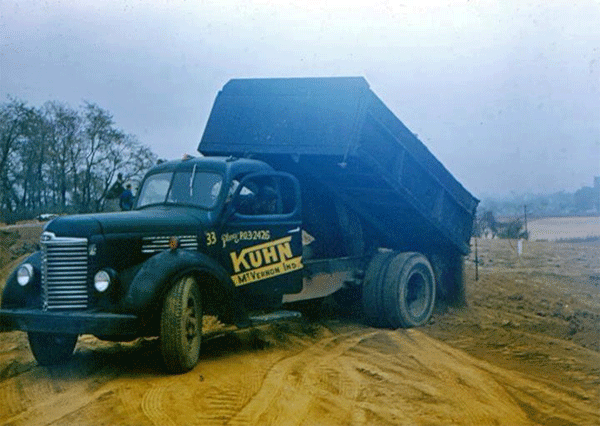
Appears to be near Smith Road and Country Club Road
Frank Moll Indians Basketball.....1962
The Indians in their 12th season of independent basketball had a 42-2 record winning 26 games in a row. Art Hall was the leading scorer with 655 points in 37 games and next came Richie Moore with 555, Frankie Dickens at 464, Jim Russell at 462. Bob Gentil at 290 and Johnny Johnson at 229.
Jack Higgins Refs Tough Game, Oakland City.....Early 1960's
Jackson Higgins once told me a story about a game he officiated in Oakland City. His dressing room proved to be the women's bathroom it seems. The game was between the Mackey Aces and the Oakland City Acorns. Mackey being the smallest school in Gibson County did produce two eventual Evansville College Hall of Famers in Gus Doerner and later Mt. Vernon High School basketball coach Harold Brown. Jack said it was tough game between the county rivals and "the two centers must have been dating the same girl because every attempt was contested and every foul was a hard one." Tempers flared, fans were brutal on the referees and the game went down to the wire. The game ended on a basket and a foul. That free throw attempt was never taken as fans filed out onto the floor from both sides to fight. Jack and the other ref quickly made the motion the game was over and hurried to dress and luckily sneaked out of the place undetected. Mackey consolidated in 1968 with Oakland City and Francisco and became Wood Memorial.
Bill Causey.....1960
Mt. Vernon Democrat sportswriter Bill Causey in the 1950's and 60's was quite a poet. He published some works and incorporated them in his sports writing, usually around the holidays. He wrote one poem during an argument of a Double I League baseball game. He almost single handedly started the Mt. Vernon Little League program buying equipment and supported it in the paper with write ups of games from the youngest to the men. He had batting averages weekly, photos and produced nicknames for the kids. His eyes got really bad in the end and he didn't drive. From what I heard, he wrote most of his columns at the Heidelberg Cafe.
Woman Stayed Inside Home for 25 Years.....1960
A story was told by Walter Neal who interviewed a lady who had stayed in her house for twenty five years. There were some eccentric siblings in Mt. Vernon it seems and the brother was the only one who ever left the house. He also only went out to buy dog food and pick through trash. After the brother had not been seen for days, people started looking for him and found him very ill. Authorities took the brother to a veteran's hospital and the sister to a state hospital. She was in awe of the world outside and was very interested in such things as light switches and refrigeration.
Advance Drillers Little League All-Stars.....1950's and 60's
I was talking to Jim "Smokey" Rainey about the early years of Little League in Mt. Vernon and specifically the Advance Drillers All-Star team. Started probably in the early to mid-1950's and coached early on by Mt. Vernon Democrat sportswriter Bill Causey. Later the coaches were Jackson Higgins and Ron Bennett. What an honor it was to play on this team. If you survived the tryouts at Athletic Park you got to wear your Driller cap during your regular season Little League games. The truth is we wore it everywhere. The team played other county teams....I especially remember St. Wendell, Poseyville, Wadesville and Cynthiana. We were promised that if we won the league we got to go to Sportsman's Park on Grand Avenue in St. Louis. That was a big deal back then. Some boys had been no farther than Evansville. I can recall seeing a game against the Los Angeles Dodgers. During batting practice we were down the left field line and the closest player to us was former Cardinal Wally Moon, a past Rookie of the Year. We kept hollering to him to throw a ball the entire time and when the bell rang ending batting practice he did so. "Smokey," who lived nearby the ballpark said he played I believe 5 years with the Drillers. Most of us only got to play one or two years. He said in the beginning they had a yellow shirt, with an oil derrick on the back, blue striping and sleeves. I believe I got that right. "Heavy" Vance was the sponsor. After that season they went to the Mt. Vernon Creamery ran by Holger Anderson and they had all the ice cream they could eat. They thought they were going to have to turn in their shirts, but they made an announcement that they could keep them and that the following year they would purchase full uniforms. I wore those uniforms...wool, heavy, with the oil derrick on the back. My first year on the team we had red caps, white AD lettering and a grey bill. First time I ever had a hat like that. We took great care in folding the front just right making the AD stand out just so. The next year the hats were solid red with white AD lettering. I remember we lost only one game....it was at St. Wendell and it was rumored the umpire was intoxicated. Jeff Hartman, as I recall hit an inside the park homerun to either tie or put us ahead late in the game, but they called him out for missing third base, which we disputed. Anyway, we won the league again and it was a happy bunch in St. Louis watching Stan Musial, Kenny Boyer, Joe Cunningham, Larry Jackson, Lindy McDaniel and Vinegar Bend Mizell.
1950's
Advance Drillers Close Out Championship Season; Head to St. Louis.....1959
The mighty Drillers took down Cynthiana 11-6 to win the county title again. Mark Nix hit the first pitch he saw from Ray Moltz for a home run. Then Ed Howard followed with another round tripper over the center fielder's head. Howard had two other singles, Jim Estes a double with Nix, and Gary Burns having two hits each, Gary Coon got the win, Bob Estes presented the winner's trophy and individual medals and Mr. Vance said they would head to St. Louis Sunday to see the Cardinal-Dodger game. Howard led the team in hitting at .511 for the second year in a row. He also led the team in runs scored with 21. He also won all three games he pitched and his three years as a Driller he hit .462, .482 and .511. Mark Nix was second in hitting at .444 and led the team with 3 home runs. Team ended their season 11-2 with one of the losses 2-0 to a non-county rival the West Salem, Illinois nine.
Booker T Wins 2 from Eville.....1958
For the first time ever, Booker T, Washington defeated the Evansville Lincoln Lions twice in one season in 1945. In recognition of the double victory, First Sergeant Lales Waller, an alumnus of the school sent $25 for awards. Waller was the son of Ulysses S. Waller of Mt. Vernon and he was stationed somewhere in the European theatre. Mt. Vernon High School will duplicate the two victories against Lincoln with our great team of 1958
Traditional Rural Dogtown, Illinois Christmas.....Late 1950's
When I was a young boy, my sister and I would get up early Christmas morning to open our presents and have the proverbial ritual breakfast of orange juice, sausage and pancakes. Later we would pile into the family Chevy and head across the new Wabash Memorial Bridge to a little community we called, "Dogtown." It had other names like Marshall Ferry and Rising Sun. Wasn't nothing there but a long street of houses and a well-kept country Baptist church. The ruins of the old country school lay at the foot of the Dogtown Cemetery, which looked like a mountain. The "old home place" is where we gathered, a home going back to the 1860's where all of mom's 12 siblings I believe were born. Back then Uncle Leonard lived there, a single man, a man of the world to them, who had a job with the railroad and in the winters lived in Florida. He took pictures of Miami and trains and boats and put them on slides. We would marvel at the sights he saw. He had exotic souvenirs of his trips like painted coconuts and palm weaved hats and colorful stones. When he died early in 1961, the place for the next 40 years lay vacant for a resident pretty much, but it was where all the family gathered for large events. The home was said to be a refuge for any of our family members in need. Aunt Myrtle kept it up. She was the ace cook and she was like another mom to her brothers and sisters. Thanksgiving and Christmas dinners were like huge feasts with dozens of people in attendance. The Christmas tree was small, but beautiful. It had those old fashioned bubble lights of which I never grew tired watching. The small children got handmade gifts and treats and Uncle Leonard always gave us one silver dollar. I wish I had kept all of those! Candy was in amazing quantities, some homemade like fudge and divinity. They were displayed in bowls, tins, baskets, plates and I gorged myself with gluttony sweets....always my downfall. I would sit with the men around a large pot belly stove in the living room. On the walls were photos of relatives during World War II. My Uncle Sam would tell me about his and Uncle Walter's baseball playing career in semi-pro leagues then he would fall asleep in his rocker. He was a lot like Uncle Joe on that television show, "Petticoat Junction." My dad would be trying on shoes that Uncle George sold part time. He worked somewhere, probably Carmi repairing bicycles. He was a thin man with wild greasy hair and behind his back some in the family called him "Barney." He did have that resemblance, but Dad never did. Dad always bought a pair of shoes every year to help his family....my pop was always helping out and positive about people. My Uncle Gib lived across the street and they usually had their own dinner, but they would come over and visit when we were around. Gib was different. He was the only Democrat in the family it seems and he liked to talk politics and stir things up. He was tolerated but I found him interesting...talking about FDR and the party of the working class. Gib had his faults like making me pull his finger and crude jokes, but I liked him because he had an edge to him that was wild and different. He had lost a finger in a accident and he kept it pickled in a jar for us to look at. The women of the family tried to help Myrtle, but she would run them off if they got in the way. She had a army of hungry mouths to feed and she was going to get it done on time and perfect. She always did. She was a great lady who never cut her hair in 86 years. Wore it in a bun, but I once saw it long after she took a shower at our home and the white hair was below her waist. A blessing was always given and sometimes we would go over to the little church, ring the bell and sing some carols. "The Little Brown Church in the Vale" was usually sung. Yes, a visit to Dogtown was an interesting experience anytime of the year, but Christmas was special and lives in memories.
Local Man Remembers 39th Anniversary of Sinking of Mordavia.....May 1957
William H. McReynolds, of East Fourth Street was one of over 400 men who were picked up at sea by two destroyers when their vessel, the armed merchant cruiser, Mordavia was sunk in the English Channel on May 23, 1918. A German U boat took her down with a single torpedo filled with 480 Americans. The Mordavia was leading a convoy of five ships near the Isle of Wight with British destroyers darting in and out. Two men of the tri-state were killed, those being Barney Williams of Sturgis Kentucky and Frank O'Dell of Shawneetown, Illinois. Fifty-six Americans lost their lives. McReynolds was later gassed in July when Americans and French troops captured Chateau Thierry. The wreck of the Mordavia sits in 45 feet of water and now is a dive site for experienced divers.
Mackey Ferry Makes Last Crossing......July 10, 1956
The century old avenue of traffic across the Wabash River west of Mt. Vernon made its last run. At the end it had three owner/operators, James Kenneth, and Lincoln Rowe, all brothers. They decided they could not compete with the Wabash Memorial Bridge. For maybe a hundred years, the date was not found of its beginning it carried passengers, horse and buggy and vehicles across the river. It was located about a mile downstream from the new bridge, and was connected by dirt roads between Mt. Vernon and New Haven, Illinois. Business was good right up to the end, making its five minute trip across the river on an average of 100 times a day. It was once called the Ashworth Ferry before it was called Mackey Ferry and before modern gasoline motors it was a steamboat.
Landmark Razed.....June 1955
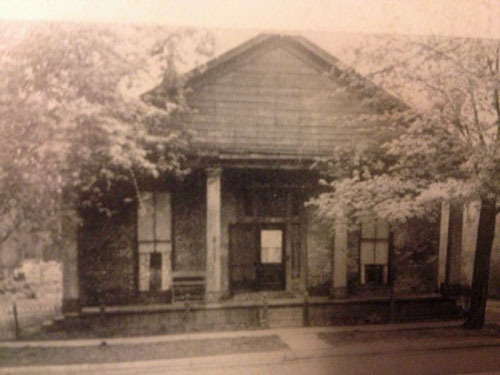
A spacious brick building belonging to Holger Anderson located on College Avenue across the alley from the Mt. Vernon Creamery plant was torn down to provide space for a used car lot for Brite Motor Sales. The building was erected shortly before the Civil War for the occupancy of a girl's seminary. When the war started the project ceased. Rufus Larkin, a bookkeeper for many years at the defunct First National Bank and his wife Annie Duckworth Larkin lived there for more than 60 years.
Actor Fess Parker a Few Miles Below Mt. Vernon Filming Davy Crockett.....June 1955

Sodium Fluoride Urged as Additive.....March 1955
Mt. Vernon medical and dental professionals went on record as favoring the use of sodium fluoride in the city water as a partial preventive of tooth decay and submitted a resolution to the city asking as much. I remember Doctor Dunnigan giving me a fluoride treatment of some sort as a child. The resolution was signed by all the local physicians and dentists and presented to the Common Council in regular session by councilman Percy Bartlett. It proposed a water treatment at the rate of one part of sodium fluoride to one million parts of water. They said the cost to the taxpayer would be less than the price of one candy bar per resident per year. Makes me think, with the use of bottled water now days, does it have this additive? Must check a label, I guess. My rural cousins use to tease me about how well water tasted so much better than city water because of the fluoride. In those days I was confused at what they were talking about. All I knew was turning a faucet handle to get a drink was easier than priming a pump and working a handle, than filling a bucket and bringing it inside.
Hedges Central Basketball.....1955
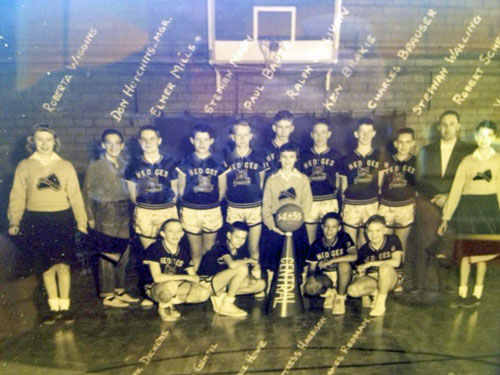
Charlie Brauser went on to Oakland City College to play basketball. He is in our athletic hall of fame as well as his college's. Was an outstanding basketball coach for the Oakland City Acorns. In 1967 his Acorns went into the Evansville Regional undefeated before losing. We almost got them in the Sectional finals taking them to overtime.
CD's Amphibian Duck.....1955
In 1955, Dr. Challman met with the unit and asked if they could use an amphibian duck as one was available in Toledo, Ohio. Challman got into his airplane and took Gene Rowe, Victor Hester and John Yaggi to Toledo to pick up the duck. It cost $150 and the only training that was given was when the garage operator handed them the keys and pointed out...."There is the gearshift." It traveled about 45 miles per hour and got about 8 miles to the gallon. This meant frequent gas station stops along the journey. Back then there were filling station attendants and when they would pull in and drive over that hose that made the ding-ding noise, they would ask in amazement, "Where do you put it?" They bounced around Indianapolis downtown in the 7- and one-half ton duck but never got stopped by police. They learned the hard way how to drive the duck, and now needed to know how to float it. They took the duck to McDonald's gravel pit to use for training purposes which included skin diving for underwater emergencies. Back then people were still swimming in the old pit. The Civil Defense decided to buy the gravel pit which cost the ten members $3 a month each to purchase. They still allowed swimmers, but now they had to be charged a small fee and they used the money to buy parts for their used fire truck that needed nozzles.
Glenn Curtis "Noble Grand".....1955
Mr. Curtis, one of my favorite people was elected noble grand of the Mt. Vernon Lodge, No. 49, Independent Order of Odd Fellows. That sounds like a good place for him. Wonder how Odd Fellows got their name? I could not think of a better representative. Glenn makes me laugh and educates me too. At that time, he was working at North Side Market I believe. The vice grand elected as officer that year was Harold Gentil. If memory serves me Harold beat out Glenn for Mayor during that period, I believe Glenn said 13 votes. Not many Republican mayors in Mt. Vernon history, so I consider it a moral victory for our great historian, humorist, folklorist, and cartoonist.
"Crack the Back Door, Would 'ya?".....November 1954
Private E-2 John D. Roberts, 17, just a junior at Mt. Vernon High School was also a member of Battery B, Mt. Vernon National Guard unit, and was overcome by carbon monoxide gas. Motors running and a gas field stove were on during a drill session at the armory on Main Street. Mt. Vernon physicians attended him, giving him oxygen supplied by a community resuscitator rushed to the building by the local Fire Department. The treatment saved his life. He is the son of Mr. and Mrs. Dorsey Roberts of Locust Street.
Bill Reineke Selected Mt. Vernon Postmaster.....May 1954
Thirty-year-old William F. Reineke then of RR3 Mt. Vernon, a Lynn township farmer, World War II veteran and Republican leader was recommended by D. Bailey Merrill, (R), 8th District Congressman for appointment to the Mt. Vernon post. I remember Bill and his family on Lincoln here in Mt. Vernon. He was an active legionnaire and involved in school issues and the Farm Bureau circles. There were three people in consideration, all Republicans. Hmmm. How did they find that many? The former postmaster, Martin Smith, a Democrat had died in 1952 and we had an assistant postmaster doing the duties, Mrs. Raymond Hoehn. That was followed by an acting postmaster named John W. Brown. The applicants took a Civil Service examination for appointment and the list was whittled down to three. Earlier, those who tested were John Brown, Reineke, Charles Schmidt, George Krug, Percy Brite, William Hill, Ervin Renschler, Lloyd Peerman, John Doane, and Ted Papenmeier. Bill Reineke served with the 249th Tank Battalion of General Patton's Third Army Armor in World War II and was in constant combat for 198 days. He held five Battle Stars and a Purple Heart. His wife Lucy (Kincheloe) was from Wadesville.
Lt. Paul Conlin's Remains Come Home After Three Years.....1954
Lt. Conlin, 24 years old the son of Mrs. Goldie Conlin of 625 Woflin Street went missing in Korea on January 3, 1951. Mrs. Conlin three months before that had a dream of an explosion and that her son had been wounded. It was so, as he was wounded in the hand by a enemy grenade. Again, on the night her son went missing she dreamed that an explosion buried her house under tons of earth. She didn't know exactly what it meant, but circled the date on the calendar. She received a letter two days later from her son dated December 22, 1950. This would be her last correspondence with her son. Lt. Conlin was declared dead in January of 1954 and in June of that year his remains were recovered near Chonghang-Ni and identified in Japan. He was flown home and buried under full military rites by the local American Legion at Bellefontaine Cemetery.
Posey Historical Museum Hit With Theft Again.....1954
Twenty years had passed since the last time the Posey County Historical Society was robbed. It happened once again. On a weekend, entrance into the Memorial Coliseum was gained by breaking a window on the west side of the gymnasium, and from the gym the intruders went upstairs and pried the lock off the door of the museum. Eight small locks were twisted off the display cases and the loot was taken.
March of Dimes Line in Mt. Vernon.....1954
Residents of our fine town were asked to join and contribute at a set up point on Main Street between Third and Fourth Streets by the local Kiwanis Club assisted by Boy Scout Troops 84 and 81. This was a Saturday and earlier on Friday night, a blanket was passed around the gym by the cheerleaders as money was tossed into it at the Mt. Vernon Wildcats-Owensville Kickapoos basketball game. All the money went to the March of Dimes. By the way, the Owensville team defeated our Wildcats 63-61. The game ended in controversy as Mt. Vernon hit a last second shot to seemingly tie the game, but it was waved off because of a traveling violation. Fans didn't approve. Bob Martin led the Cats with 17 points.
Kiwanis Easter Egg Hunt of 1954
We just had one recently at Brittlebank Park. Back then they were held at Athletic Park. Years before that they were segregated hunts held by the Fire Department. In 1954, the Kiwanis Club held theirs on Easter Sunday in the early afternoon after churches were let out and families had time to gather and enjoy a meal. If you were under 12 years of age you could become a "hunter." There were three divisions of age groups to give everyone a chance to fill their baskets and buckets. In addition to the nearly 100 dozen colored hen eggs, 125 dozen candy eggs, assorted jelly beans, children looked for prize eggs, those with a "K" on them as well as golden eggs, entitling the finders a special prize. The project was under the supervision of the Boys and Girls Committee, which included James O. Baxter, David Benthall, Dr. Henry Watson, Eldon Crawford, Harry Hess, and James Tygart. Kiwanians spread out to assist the youngsters and supervise the group making it a safe and happy event. "Don't fall on the cinders!"
Raccoon Causes Man to Get a Ticket.....May 1953
"Come on Rocky Boy"....A raccoon perched atop a utility pole at Walnut and Water Streets all day caused a scene. Mt. Vernon Police were interviewed and they thought that it may have been run up a pole by a dog. Anyways, it caused much concern....women came out of their homes in their aprons and pointed, and talked with neighbors about it. Motorist stopped to see what was going on. Somebody threw a rock at the critter until someone said, "Don't do that, you might hit young Rocky in the eye." Ideas finally came to Louis Roberts, 20, who said, "Rocky you met your match," who tried to bump the pole with his vehicle to persuade it to come down.....The law didn't like that and wrote a ticket to Louis for $5 and costs on a charge of reckless driving. ....and Rocky? Well, he took the attitude..."I'll be along soon enough as soon as I am able...d'do d'do d'do do."
Farmers....Battery B Wants Your Son.....1953
If you have a son who is between the ages of 17 and 18 1/2 years of age and you want him to stay home and help you with farm work, he can do so by enlisting in Battery B. That's right, just one night each week and attend camp just 15 days a year. That is of course there is not a riot or a war or who knows they need more help in Korea, but I digress. Here is his chance to stay home and get paid for his military duty. We pay starting out $2.60 per drill and after four months your pay is increased. Aw the appeal is so real, come on down, meet the swell fellas..."We got the Guns, We need the Boys."
Plane Buzzes White County Farmer; Causes Runaway.....1953
Over in Carmi, 60-year-old farmer Ernest Morrill was mowing a field adjacent to his home with mules pulling the mower when a plane dived from the east toward the mule drawn mower, moving its wings back and forth less than 30 feet from the ground. One wing grazed one mule's head and the animals bolted across the field, the mower bouncing along behind them. The plane soared away. Morrill was thrown off and dragged more than 30 feet before he broke away from the machine. He was released after treatment of bruises to face and head. No word on the reckless flyboy in a small, silver monoplane. I don't think it was Sky King.
Kuhn Truck & Koal Fire of August 1952
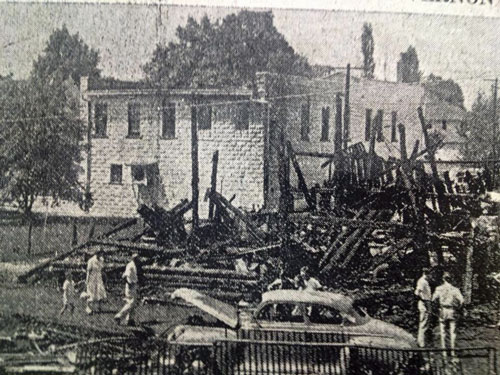
Weisinger Funeral Home was saved from the fire explosions of gasoline tanks from Kuhn's.
Birth of Posey CD Unit.....Early 1950's
In 1952 and 1953, Mt. Vernon was besieged by five major fires that did significant damage. A group of men volunteered to supplement the local fire department. Mayor Paul Hironimus and Fire Chief Bill Booth asked ten men to form an auxiliary. These men would practice three or four times a month and would answer a call in an emergency if needed. When they were the auxiliary, a large fire happened when the Scheiber Cabinet Shop, Breeze Garage, Dr. Vogel's office and the Mt. Vernon Democrat caught fire. A wall caved in and a barrel of paint remover blew up in the Breeze Garage. The fire spread quickly. It was a very cold night and Pick Toothman was on the roof of the Democrat and John Yaggi was fighting the fire from the front of the building. Yaggi's back up man left to get more hose and the Yaggi was thrown into the gutter. "I nearly drowned," said Yaggi "as well as onlookers." Later Dr. Challman was appointed Posey County Director and Gene Rowe, chief of the auxiliary. They decided to become the Civil Defense Fire Department and be governed by the Civil Defense by-laws. I believe this fire destroyed many bundles of old Mt. Vernon Democrats before they were microfilmed sadly. There is a large gap of papers missing, but thankfully supplemented by the paper, The Western Star.
Hedges Central School Postcard....1950's - Does anyone ride a bike to school anymore?
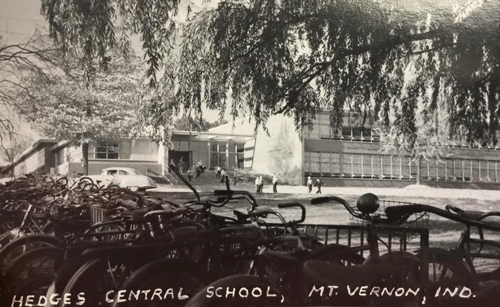
I think back at how I would put my baseball glove strap over the handlebars and hang down and my baseball bat I would stretch across the bars holding it with my palms as I rode my bike to Athletic Park or other diamonds. I remember those weak lights on the front of the bikes as well as baskets. In the 60's bikes changed with long seats and sleek lines. I remember the first ones I saw they were just called, "English Racers."
Olympian, POW, Honored Subject in Movie, "Unbroken" Spoke in MV.....July 1951
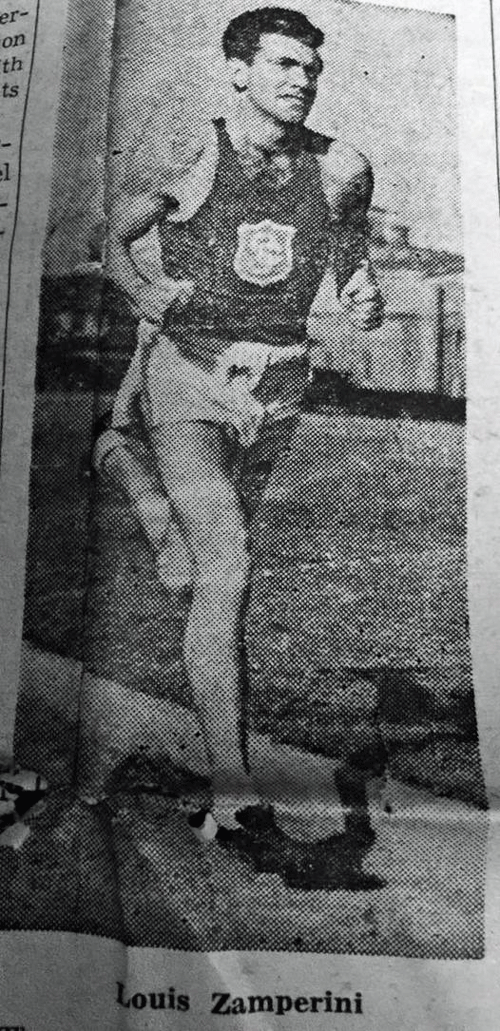
The world champion runner, Louis Zamperini spoke at a meeting called, "Christ for Posey County" held at the Memorial Coliseum. It was a evangelistic meeting of pastors from many denominations present. The Mt. Vernon Republican newspaper called the story, "the best story to come out of the war other than the Atomic Bomb!" The War Department listed him as one of the ten most American men to suffer the most during the war and he made headlines around the globe. In the 1936 Olympics in Germany, he almost created an international incident by tearing down Hitler's private swastika flag from in front of the Chancellery in Berlin. The newspaper said he was shot at twice by guards but took that flag home with him. He spent 47 days at sea in a rubber raft and two- and one-half years as a POW in Japan. At this time, he was speaking across the country, Canada and yes Japan of his personal savior in Jesus Christ.
1951.....finally integration
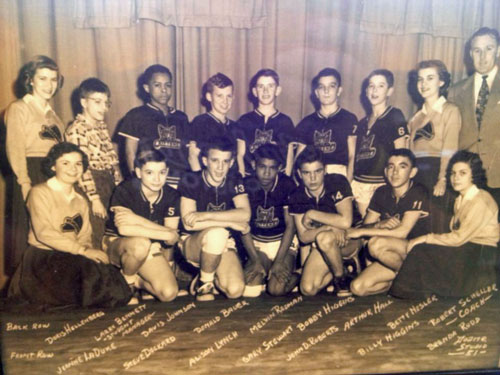
Davis "Slick" Johnson is a hell of a nice man. I visited their home last year and learned many things about that period of time in Mt. Vernon. He is the brother of Johnny Johnson, the first great black athlete at MVHS. Jeannie LaDuke is a cheerleader here as she will be at the high school. She was in the 1949 Hollywood movie, "The Green Promise" with Natalie Wood. She became a great academic, was at the White House and she is an author too. Bill Higgins is in the MVHS sports Hall of Fame as is Art Hall and Gary Stewart.
New Harmony Celebrates its Annual Golden Rain Tree Festival with Pageant.....1951
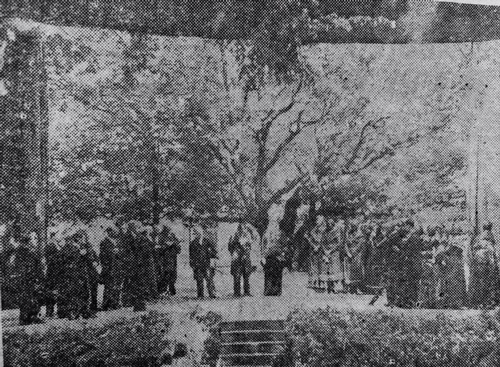
The pageant depicted the history of the community and scenes written originally by Ross Lockwood Jr. It centered around Father George Rapp and his followers who came to the territory in 1814 to found the town of Harmonie. Other characters represented included Robert Owen and his sons, Joseph Neef, William Maclure, Madame Marie Fretageot, Thomas Say and others. Dances and music of each era were presented. The dilemma of "Everyman" was shown in a dance where after many frustrations man struggles with the material, intellectual and the spiritual of which one is successful attaining "new harmony" by a combination of all three.
Circus Plays to Overflow Crowd at Airport.....September 1950
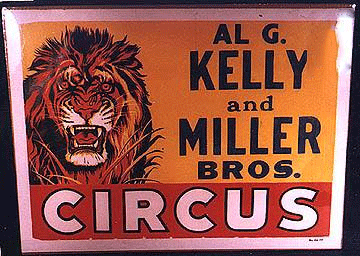
The largest circus to play Mt. Vernon in 27 years, the Kelly-Miller Brothers Circus had a afternoon and evening engagements at the municipal airport east of town. 65 semi-trailers pulled into Mt. Vernon and spectators watched the unloading, feeding, and watering of the wild animals prior to the show. A giraffe was even part of the exhibit being the only circus besides Ringling Brothers and Barnum & Bailey to have one. The night performance drew 5,700 people as the seating was capacity and others sat on hay bales under the overflow canvas tents. Fifteen elephants put on quite a show it was said, as did Evelina Rossi on trapeze. Mayor James Bennett praised the show for its cleanliness and wholesome entertainment. He also sent kudos to the Mt. Vernon Police Department for their excellent directing of the heaviest traffic ever seen in Mt. Vernon.
1940's
1948-49 Hedges Basketball
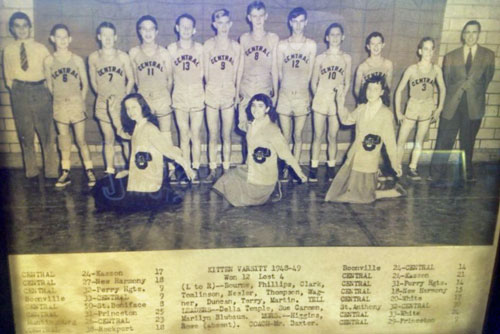
Mayor Higgins is in the photo as is Hall of Famer coach Jim Baxter.
Mt. Vernon Selected as "Test City" for New Mild Cigarette.....1949
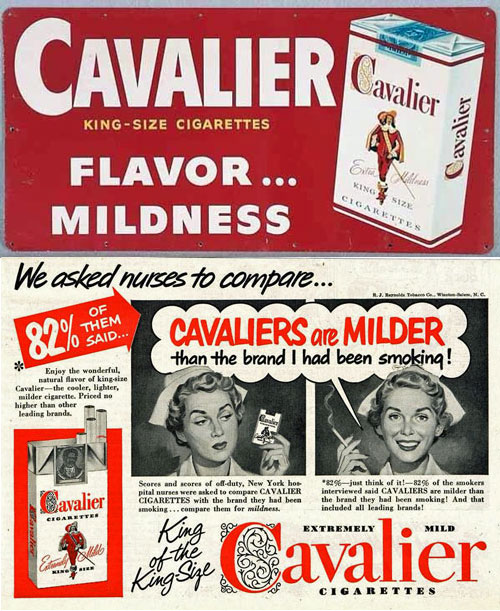
R.J. Reynolds Tobacco Company announced arrangements for the distribution of the Cavalier cigarette to the area, the first new one brought to market by the company in 36 years. During this time the company had been producing the Camel brand. The brand went on the market the first week of March. The cigarette was soon eclipsed by a new brand a filter tip Winston. Cavalier never really caught on, even though it was the sponsor of the TV show..."I Got a Secret." I hear it was big in Ecuador.
Ok WWII is finally over
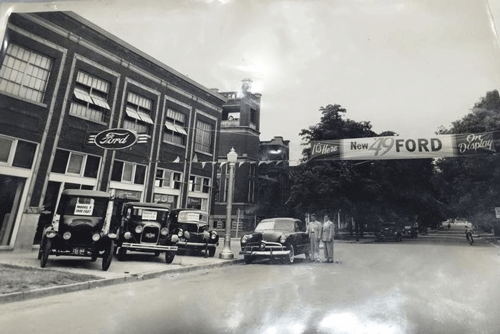
Ford starts producing new cars verses war effort vehicles. John and Bill Keck come back to Mt Vernon after the death of father Grover and come in the family business. I love this shot because of the new 49 post war Ford. The 17 model T that was their grandfather's demo (Roger McCormick has this now) a model A and I think a last pre-war Ford. I love they are standing in Main St and the only traffic is a kid on a bike. Also notice the old Methodist Church which lasted to 58!
In 1948 Henry Wallace, former VP under FDR Campaigned in Evansville

In 1948 Henry Wallace, former VP under FDR campaigned in Evansville as the Progressive Candidate for President and was protested because of his support for unions. April 6, 1948, the man who was replaced as vice president for Harry Truman came to town. If he would have stayed VP he would have become President when Roosevelt died in office. Henry was a thinking new dealer, utopian visionary. Some said he was the best Secretary of Agriculture ever! He was also Secretary of Commerce. Server in Evansville made refrigerators and they wanted to do it with low wages and a union was organized. Server fought it hard and jobs were jobs so veterans of the Second World War were recruited to walk the picket lines in favor of the company. Wallace came in he was a man of vision. He was for an end to segregation, put blacks in his campaign and said he would have them in his cabinet when elected. He backed as Teddy had for universal healthcare. He preached full rights for all Americans. He went through the South had eggs and tomatoes thrown at him preaching against second class citizenship. People called him a Communist, way ahead of Joseph McCarthy. Born into the Presbyterian faith, he eventually explored other religions including spiritualism. He wrote on Buddhism and was always lobbying to protect monuments of religion from war. He hung out with Einstein, H G Wells and George Bernard Shaw. He was a man of action, sometimes he was found wrong and gullible. He acknowledged as much with a book in 1952 called, "Where I was Wrong." He supported Eisenhower and even Nixon, yet JFK invited him to his inauguration of which he was very touched. A complicated, intelligent, flawed man with good intentions. That's not so bad to be known for by this liberal.
Before Welcome Wagon.....1948
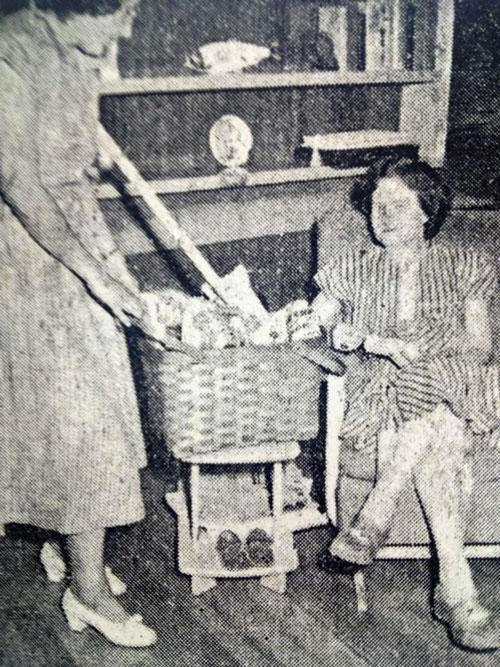
MV Greeting Service in 1948. Here Mrs. James Noland presents to new resident Mrs. Floyd Hall gifts from MV business firms....."Welcome!"
Opening Gridiron.....1947
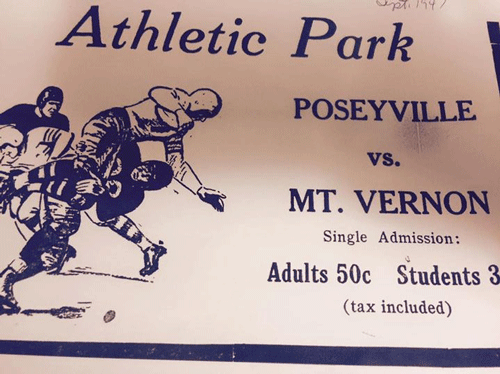
Opening game of the 1947 season as Mt. Vernon defeated the Posies 47-0. Cats line averaged 5'11" and 167 pounds. We had three lettermen back from a 9-0-1 season the year before. Game was called 8 and 1/2 minutes into the third quarter by the 45-point mercy rule. Benny Isham the QB had a TD run and a TD pass to Niemeier. Bill Russell scooped up a blocked punt and ran it into the end zone. Bill Roach rushed for two touchdowns and Ferrel Meinshein had a five-yard TD scamper. Posies made it to midfield once. Whitesides and Isham both had two dropkick PAT's. This was the season we went from a six-man team to ab 8 man team. A loss to Dale after six victories would end the longest winning streak in Mt. Vernon history 18 wins and 2 ties from 1945-1947.
The Peerless Moves To New Location - "Come Party".....December 1946
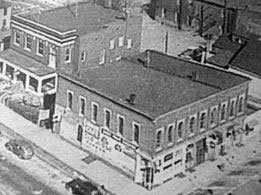
The Peerless Cafe, owned then by Mr. and Mrs. Raymond L. Schenk and formerly located at 209 Main, opened appropriately on a Saturday at its new location at 101 Main Street. It was a place that was once the old Krug Saloon, so it was used to a good time. The inside was rebuilt and re-arranged. The walls were done in Mulberry color "harmonizing with the mahogany woodwork trim." The tile was linoleum for easy clean ups I guess. They had then two clean, modern rest rooms built under a real balcony "which adds much to the appearance of the floor plan!" A modern bar, ten booths and serving tables. They served sandwiches along with beers, wines, and liquors. A hot air furnace was new and so is fluorescent lighting. Personnel were Harold Gwin, Otto Pfeffer, Mrs. Agnes Beirman and Miss Ivtol York with Clint Cornelius and John Henry Bryant as porters.
Graduation Party for Seniors of Booker T. Washington and Reception by Juniors....May of 1945
"Palm Gardens" was the theme of the Junior-Senior Reception at the Booker T. Washington School. The Home Economics room was decorated with palm trees, fresh flowers and a painted tropical moon. The guests seated at beautifully decorated tables and the music opened with "Always," played by the "Jive Juniors." A tribute to the Class of 45 was given by Birdie Jane Glass. A comedy routine was put on by Herbert Kirk and Posey Bishop and was well received. Alvin Martin did sleight of hand card tricks as "The Great Enchanter." The highlight of the evening was the closing number by the orchestra with the tune of Auld Lang Syne and sung by Birdie Glass. The program came to an end as the lighted tapers, gracing the tables were extinguished one by one. On the last refrain, a quiet hush descended upon the guests as the last candle was dimmed and the tropical moon was illuminated. Parents gave short talks praising their appreciation to the school and administrators; thereafter, refreshments were served and dancing was enjoyed by the young guests.
So "Largest GOP House Numbers since the End of WWII"....What Happened then ~Wavy?
Oh reckon back to the 80th Congress when one Republican said, "A vast amount of New Deal rubbish will have to be removed before even the outline of our free institutions will become visible." Sound familiar? Here they were the majority, dominating the upper house on domestic issues. Their agenda? They did pass a few anti-union measures, but Truman took much of the sting out of the Republican bills with vetoes. Republicans assumed they had a mandate to repeal the New Deal. That did not prove all that popular come next voting cycle. In that time the Republicans gained 13 Senate seats and 57 House seats. What are they known for today? "The Do Nothing" Congress! At least they were until the Obama era. What were some of the bills taken and what were their interests? Well, they approved citations of contempt of Congress against Hollywood with communism witch hunts, they were upset with Truman by executive order ending racial segregation in the Armed Forces, they hosted the House of Un-American Activities Committee, we got Nixon going after Hess and in the next cycle....the Democrats came back strong winning back control of the Senate and House of Representatives. So, while some of you jump all over the place ~Wavy maintains the course. If you want to see more silly acts like Attorney General John Ashcroft covering the breast of a statue in the Great Hall....stay tuned, the circus is coming to town in January.
Christmas Highlights Of the Black Community.....1944
Mrs. Jennie Bishop, wife of BTW principal Guy Bishop use to have a column in the Mt. Vernon Democrat called, "COLORED NEWS." As Christmas came close in 1944 she wrote of the Booker T. Washington Blue Devils defeating Evansville Lincoln Lions in basketball. In celebration, Santa Claus delivered to each child a "Lincoln Victory" pencil in appreciation of bringing honor to their school. In the school gym the BTW put on a play called, "Mother Goose Christmas," for the younger ones and a cantata for the intermediate grades. Afterwards the teachers treated the children with small gifts. The Lesser Lights club held a Christmas party at the home of the Bishops and they sang Christmas carols and listened to a talk on how the holiday is celebrated in other lands. At the close, gifts were exchanged and ice cream and cake were served.
LST 816 docked at Mt. Vernon during "Navy Days" October 26, 1944
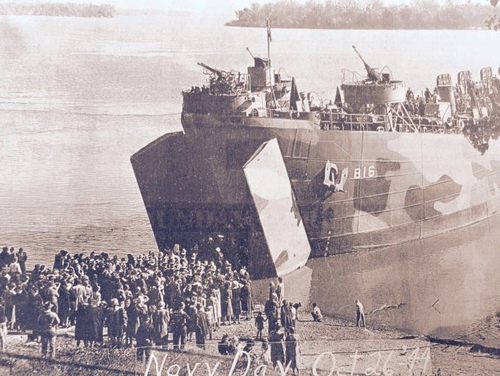
It was assigned to Asiatic-Pacific Theater and was involved with the assault of Iwo Jima in spring of 1945. Two battle stars for the ship and was scrapped in 1948.
World War II letter home....."Over There" 1943
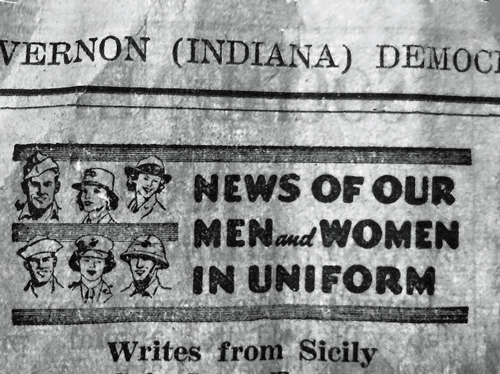
Tech Cpl. John T. Kishline, an electrician in the United States Army Air Corps, wrote his parents, Mr. and Mrs. Warren Kishline, Mt. Vernon from the island of Sicily where he was stationed. He wrote "I hate to think what Italy and Germany are going to look like." He had seen some of the devastation brought by the Allied bombardment and was moved by the poor, destitute Sicilian population, especially the children. Kishline had been in service for 18 months and arrived overseas in July of 1942, earlier in Africa.
Old Stop Signs.....1941
"Yaller" is the color. Yes, yellow was the paint color used for lane divisions on the downtown Main Street in 1941. Stop signs were often yellow also. This was so because yellow shown up better at night before reflectors. As a matter of fact we use to have some white Stop signs with black lettering and writing on the back like "watch your step" in the 1920's.
Western Star Newspaper Office.....1941
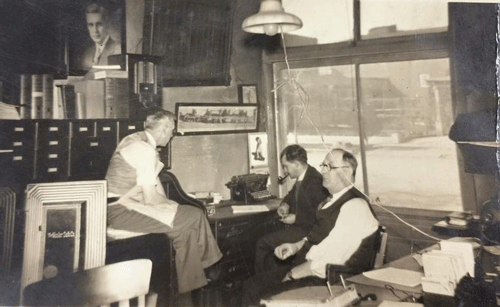
Was told it shows Frank Fessenden, Herbert Leffel, and Bill Causey. Can anyone confirm? I don't think it is Causey. Not sure he was here in 1941. Photo courtesy of Holly Leffel.
Seeing Double - Two Queens.....1947
In 1947 the Football Homecoming had something never seen in Mt. Vernon before....two queens. Nancy Huffman and Jo Ann Bishop reigned that evening with the queens elected by votes cast in conjunction with season ticket sales. A colorful pageant was held that night in the non-conference game between Mt. Vernon and Grayville, Illinois at Athletic Park. The captain of the team was Bob Dausman....I wonder if he got to kiss them both? WWWD?.....What Would ~Wavy Do?
Centennial Notes.....1916
The crowd, which by all indications was far the largest ever assembled in Mt. Vernon, even surpassing the passing of Governor Alvin P. Hovey. The vast throng was orderly and the police and firemen on duty had little trouble with unrulily characters. The weather was all that could be desired for such an event and was ideal for all outside entertainment. The old saying "that there is always room for one more," did not hold true on the last night. The levee and all surrounding buildings were packed with a good natured and very appreciative audience. People hung out windows and sat on balconies...even roofs. The water pageant was a success. The chairman of the event showed how he understood to successfully advertise the big show and a large crowd, maybe 20,000 was evidence enough to show that it was a success.
1930's
New Years Eve Club Parties In 1939....
The social clubs of Mt. Vernon extended a warm welcome to the new year of 1939 with parties and dances. There were 55 couples at the New Year's Eve dinner dance at the Elks for members and wives and lady friends. Music was furnished by Wee Willie Web and his "colored" entertainers from Mt. Vernon, Illinois. At the Eagles, 50 couples also had a dinner/dance and the music was furnished by Jean Kohler and his orchestra. As midnight approached guests walked outside to hear the steam whistles and gaze at the starlit sky over the Ohio River.
New Ferryman, Studied for His Captain's License by Studying at Arrow Cafe.....1939
A Western Star reporter entered the Arrow Cafe, operated by Dave Ashworth and found him curled up in one of the booths reading a book, which was a huge book. When asked what he was doing, he finally informed him that is was a book of questions and answers on securing a pilot's and river captain's license. "It's necessary that I memorize all of them," he sighed. Dave was so confident that he already owned a little craft that plied the Ohio River and the Kentucky shore buying the ferry along with Joe Vail. He successfully passed the examination and now......"It's Captain Ashworth, if you please."
MV Mayor Quoted in The Pittsburgh Press.....May 1938
In a column called, "They Say" of items across the nation, Mt. Vernon Mayor Herman Bray was quoted: "I've discovered that I can find out more about what's going on in Mt. Vernon by selling hamburgers than I can being at City Hall." Bray at the time owned a sandwich shop.
For Me, It Was Only Around Girls.....1938
Stuttering..... I don't want to make light of it too much or seem insensitive, but this Doctor, a Robert Millsen, a director of Speech Correction of Indiana University made a study of all Indiana counties using samples of the population. He concluded that there were 180 persons in Posey who were stutterers and 540 persons who lisp or have other articulation defects. Finding my voice was also a problem, getting it out from my heart to the world wasn't easy growing up. Probably around blondes my stuttering jumped more than 10 words per 100. Fear and anxiety can cause it to worsen I hear. I had lots of that, but really I just didn't say much around girls.....I seemed to have got over that.
Antique Quilt from 1804, Had Unique Story, Displayed at MV Fall Festival.....1937
An antique quilt was displayed and entered under the name of Mrs. Georgiana Stevens at the Fall Festival quilt show that was a part of early Mt. Vernon history. Mrs. Mary Shyrock, aunt of Mrs. Stevens, spun the material used in the quilt. It was completely handmade and spun from raw materials by hand. Mrs. Stevens said she got it when she was nine years old and Mrs. Shyrock was very old then. Shyrock was the wife of Valentine Shyrock, owner of the ground later sold to Godfrey Weisinger who in turn sold it to a committee for the establishment of German cemetery, today being Bellefontaine. Her remains were the first of the female sex to be interred in the cemetery.
Flood Over.....1937
On February 17, 1937 Martial Law was lifted in Posey County by Governor Clifford Townsend and civil government resumed its rule of the Posey County flood area. The order to lift military rule was announced by Lieutenant Beauford Alldredge, commander of Battery E. Alldredge thanked the community for their co-operation. Liquor bans are now lifted and where the carrying of firearms by persons other than police or guardsmen was concerned, it went back to as it had been.
Dump Open Burning Times Changed.....1937
A discussion was held within the fire department in Mt. Vernon about the controlled burning of brush at our different city dumps. It was decided to burn them at night instead of Sunday afternoons in the thought that the pollutants would be safer for residents in their homes.
Former Slave Once Served in Civil War Under Posey Captain...Son lived here.....Dies 1937
n Hardin County, Illinois lived Harry Whitehead. He was called, "Uncle Harry" and was very well known to the citizens of that community. He was born on a plantation in Virginia, Culpeper County on May 29, 1840. His father, a slave was Harry Brown and his mother, a slave was Rebecca Whitehead under master named Whitehead. He was one of eleven children. Five of his siblings were before his memory and were sold. At age 20, Harry ran off and joined the Union Army at Chattanooga, Tn., serving 34 months and was captured by the Confederates by Hood's army and forced to dig pits for men to fight in and trenches around such cities as Columbia and Macon, Georgia. In the Union Army he served under Capt. Elliot of Posey County. He first married in 1869 and died in the 1890's. He married again in 1907 and lived on a Civil War pension and was able to have a home with electric lights, a good radio and even a car driven by his nephew in the 1930's. They divorced in 1937 at age 97 when Harry filed because of desertion. He had to be carried into the courtroom and put in the witness chair. His voice was weak. He said his wife had gone to live with one of his sons in Anderson Indiana. Two weeks later Harry died. One son, Edd was living in Mt. Vernon at that time. The American Legion of Elizabethtown, Illinois honored him at the services. Harry had started the annual celebration of Emancipation Day each August 8th in that county and was known for barbecued meat that he served to friends.
Vernon Theater Draws Large Friday Night Crowds.....1935
In May of 1935, two fireman were sent to the Vernon on Friday nights to investigate the seating of large crowds they were having from a safety point of view. By order of the Chief the fire marshal was contacted in 1937 to ask for instructions on controlling immense crowds blocking entrances. I never saw anything in the papers of any changes. This story comes from the Fire Department log book. Don't ask me how I get such things.
Challenging Assumptions...Putting One's Self On the Line.....1930's
Recently Sharon Rowe Barbarette relayed this story of her father Norman about life in the mid to late 1930's. I found it moving, compassionate and yes brave. Norman owned a school bus and was contracted by the school district to transport students to school from Point and Black townships. Schools were small and many only open for the younger grades in the rural area as the older ones had to take off for farm work. My dad was one of those children in that area at that time. Sharon tells us that the black students were not provided transportation and had to walk to the one or two schools available to them. I never have heard a name of a black school in Point, but I know black children lived there. Maybe, he brought them all the way to Booker T. Mr. Rowe thought it was wrong to not give these students a ride, so he picked them up. When word got to the school administration they were not pleased, and "he was soundly reprimanded." He was unmoved and responded that he owned the bus and he was not asking for pay to transport the black children and basically, "didn't see how it was any of their business who was on the bus." The administration backed down and he continued bringing the children to the school. Sometimes a heart seeing oppression and a tortuous injustice moves in wonderful ways that seem small maybe at the time that changes attitudes in the future that leads to better humankind for us all. Thanks Norman Rowe and Sharon for sharing this story!
Major Varsity Letter Winners....1930-1937
Mt. Vernon High School records show that during this period it was a difficult time. Girl's basketball, of which we excelled was stopped state wide in 1930. The depression hit and costs were curtailed. Following a winless football season in 1930 we stopped playing until the Pocket Athletic Conference was organized in 1938. Even then, during the war there were seasons when only four games were scheduled. At best there was only football, basketball, track, and baseball. Baseball, another sport we were good at was sometimes thought as minor and few letters were given out. For two seasons, 1932-33 and 1933-34 the cage sport was the only one for which major monograms were awarded. In the 1935 year, there was but one letter given in baseball, and that going to the hurler Alfred "Dutch" Wehr who pitched the only game of the season a win vs Evansville Reitz. From the fall of 1929 through the spring of 1937, according to Honor Day records, two athletes won four major "M's" in one sport. Paul Moeller and Oliver Willis accomplished this feat on the hardwood. Moeller earned the most letters in all sports during this period, eight, including two each in baseball and track, plus his quartet in basketball. Willis had six, one each in baseball and track plus four in basketball. Stafford Abell won six, three in basketball, two in football and one in baseball. Arthur Woods had five on two each in football and basketball and one in baseball. Six other Wildcats won four letters.....Malcolm Fuhrer, Dwight Roberts, Elsby Goffinet, Wesley Waterhouse, "Dutch" Wehr, and Mark Kost.
Nonnie Robison Speaks of Biff Carr.....1930's
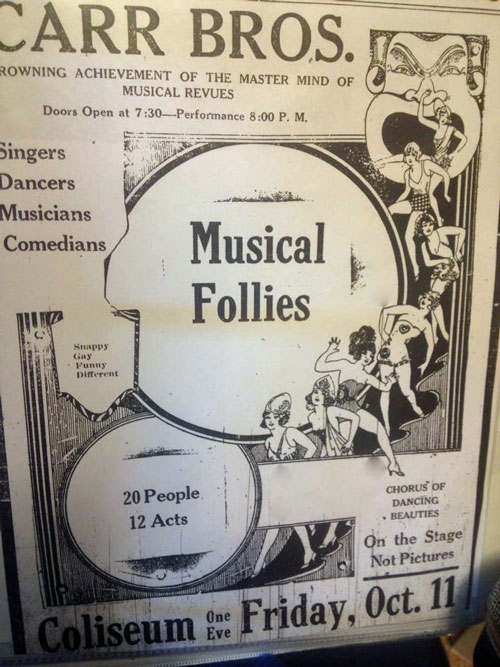
Biff Carr was a Mt. Vernon High School graduate from 1913. From an early age he was a promoter it seems. He was talented in acting, in music and comfortable on stage. He hosted these musical follies shows across the Midwest that included vaudeville and minstrels. Nonnie tells me that during the depression they fell on hard times and Carr for a spell came back to his hometown. He may have even stayed at the Carr Hotel on East Second Street where his sister Mary lived. Biff's wife had bleached her hair like Jean Harlow, the movie star and she gave tap lessons supplementing their income during this hard time. Eventually, Biff left again. I have found however that in 1963, the Class of 1913 had their 50th class reunion and they toured the brand new high school on Harriet Street and that Biff was the Master of Ceremonies keeping his classmates laughing at old memories and routines.
Change of Heart.. Conscience Got the Best of Him.....1934
For several days that July of 1934 a local merchant noticed that eggs were missing from the nests of his laying hens. Then, one day he went to the hen house and found 18 eggs in one nest, and on top of the eggs was a Bible.
Parachutes Dropped On City In Strange Promotion...One for Case of Beer Not Found.....1933
In recognition of the construction of a new Sky-Highway marker as a guide to aviation a number of out of town business firms extended their thanks with gifts dropped by parachute from a plane piloted by Dave Alldredge who winged his way over the city. Not all were found days later. The Sterling Company of Evansville sent an aerial guide attached for a complimentary case of Sterling beer. It was supposed to be delivered to Mayor E.F. Bamberger. There were shirt coupons from the Vogue in Evansville too and car tune ups from a place called Weidenhoff's in Evansville. Coca Cola Bottling Works just sent over a case of real coke over to City Hall by delivery truck. A.E. Fretageot of New Harmony sent congratulations with a round trip ferry ticket. The Baby Shop sent a doll and well the list goes on and on. I am sure many of the gifts intended for the Mayor fell in "enemy hands."
Mt Idy Po Po Force Down to Two.....August, 1932
In August of 1932 the Mt. Vernon Police force was reduced to two men...two! Chief of Police William D. Lawrence was on duty during the daytime, after all he was the boss, and at night patrolman Robert Randolph looked out for trouble. Must have kept the extra badges in the desk.
Severe Windstorm Tears Through Mt. Vernon .....August 1932
The peace and tranquility of our city was disturbed as on a Friday afternoon a storm of near tornado force demolished small buildings and left city streets strewn with tree debris. A torrential rail accompanied the raging wind flooding the streets. The only injury reported was Arnold Lewis, an employee of the Overall Corporation on North Main Street who sustained a terribly mashed hand when a window fell at the factory.
New Restaurant in Town.....July, 1932
In July of 1932, Herman Bray and son Charles opened a restaurant and ice cream parlor at 111 West Second Street. Everything served was a nickel except for barbecue and it was a dime.
Reuse and Recyle - Early Days.....July, 1932
In July of 1932, Posey County's last covered bridge, the Wolflin Street bridge of Mt. Vernon was dismantled and was to be re-erected over Gresham Creek, north of New Harmony.
"Retired Rube," AKA, John S. Williams Tells of Posey Relative.....1932
John Williams, a retired school teacher, use to write in the Western Star paper from time to time telling Posey stories....Here is one: "My great-grandfather George Row, came to the Indiana territory from Hardin County, Ky., in 1809. He built a one room log cabin, with a stick chimney, about two hundred yards southeast of where Prairie School house number 9 was later built. About 300 yards from his forest home was a one acre glade. Formerly a swamp, this glade was covered with swamp grass and was used as a cow pasture. They called this grazing land amid the surrounding forest. "The Prairie" well this gave the name later to a neighborhood settlement, church and school which were built around the spot."
Christmas.....1931
Christmas 1931....the Elks Lodge treated 262 "unfortunate" children with a Christmas Party at the Elk's Home. All were greeted by Santa. A fine tradition that continues today. Times were called hard....the economy was bad, business was slack, money was tight, spending was less.....but love still existed.
Fatal Fire.....April, 1930
On April 30, 1930, John Reinhardt died at his home on Mann Street from burns he received in the Graham Valve Plant fire. Reinhardt, had his auto stored in the rear portion of the building and tried to remove his car from the blazing structure suffering the fatal injuries.
Walnut Street Before Post Office...Pre 1932

You can see the Elks, St. Matthews, Fogas residence, Masonic Temple (now Hovey House), Dr. Robert Hardwick residence and then the old Court Hotel which will be the site of the new federal building.
Mt. Vernon Map.....1930
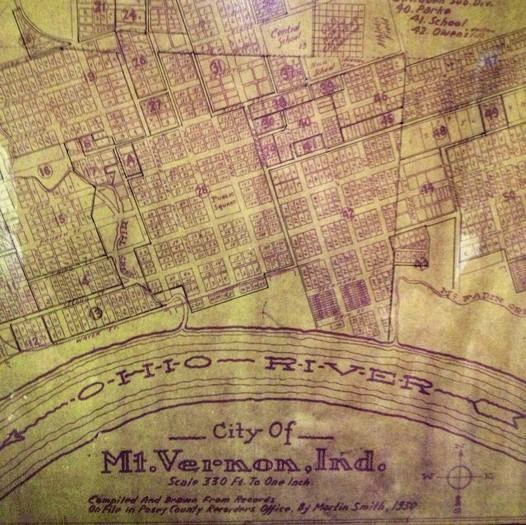
Trent Vanhafften Showed Me A Cool Map from 1930.
1920's
A Gold Ring for a Quarter.....c 1927
Yesterday I had a delightful conversation of four hours with Nonnie Dewart Robison. We talked about many topics, her family history going back to the early days of Mt. Vernon with the Ellis family to her childhood and her teaching career. It was during that later part she became emotional with her love of children. I could tell she was a wonderful elementary teacher. Those sweet memories of good children and those that somehow had troubles in life, she recalled their youth. I found that very touching. I have homework to do as she loaned me a book to read filled as mine are with underlines, asterisks, and yellow highlighters. I have several stories and footnotes for characters, but this one is about Nonnie as a three year old child. She was looking in the Ike Rosenbaum display window on Main Street admiring the jewelry. Her grandpa then ran a shoe repair store and she asked him for some money. He gave her a quarter. She went into the jewelry store and Mr. Rosenbaum waited on her. She told him she would like to buy a ring full of diamonds. Ike said, "You do? How much money do you have?" Nonnie opened her fist and said, "this much." Mr. Rosenbaum saw the quarter and said, "Let's see what we can do." He found her a little gold ring....no diamonds, but a real gold ring. Nonnie says that her children all had turns wearing that gold ring when she became a mother.
"Human Fly" Scales Court House Before Large Crowd.....April 1926
Harry Leonard of Washington, D. C., scaled the courthouse like Spider-Man I guess in front of many curious spectators. He ascended from the west side and upon reaching the dome changed his climb to the south side. After reaching the flag staff he advertised the Derring Sales company, distributors for the Overland cars and Hironimus & Miller, garage owners. The Kelly-Springfield inner tube was tested when in midair, the man using it as a support in swinging from the top Cornish of the building. Ropes were also used by the man in ascending to the dome.
City Council Turns Down Request To Illuminate "Town Clock.".....1926
The city council ordered that the town clock in the steeple of St. Matthew's Catholic church be dressed up in the near future with a coat of paint. They also deemed it too expensive to illuminate the time piece. It was announced that it would have cost $100 to wire the clock and $14 monthly to make the dial visible during the night. "Pop" Fessenden, in the book "The Old Timer" said it struck on the quarter hours on two bells and the hour on the largest bell. Not sure of it ever being lit....I want to say yes, but I am not sure. Comment from Shelly Cunningham McConville: St Matthews is trying to raise money (January, 2015) to repair the bells so they will all ring. I didn't know there was a timepiece on it. Unless it's the bells. I better have another look! Donate for the bells everyone! You don't have to be Catholic to enjoy hearing them.
1926 Photo of Keck-Gonnerman on West Fourth Street
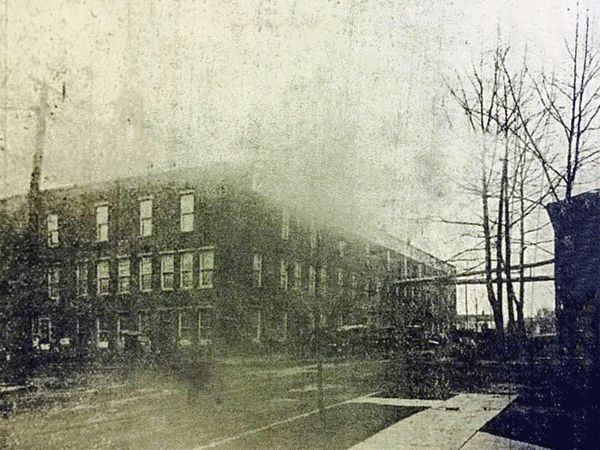
Guest Comments from Richard Allen Keck: Great picture ray! So the foundry was on the south side of the street and the office, car dealership and big boiler were across 4th St to the north. The thing you see going across 4th is the flue from the second story which took the wood shavings from the foundry over and fed the boiler. The boiler in turn ran a large pulley belt which ran back across the street and fed power to all the power equipment. The plant was self sufficient from a power standpoint!!! Wavy: Thanks for the explanation Richard! Where Bee Nix Motors was on 2nd and College I have a photo from this time called Keck-Gonnerman Auto RAK: Ok that's another good story. So as a division of Kay Gee (nickname of Keck Gonnerman) they started a car division in 1907. First with Cadillac, added Oakland, Nash and then Ford in 1912. By the early 20's the car division with 10 employees was making more money than the foundry with 200 plus. The foundry was run by my great grandfather John Keck, brother Louis Keck and Billy Gonnerman. The car division was run by John's son Grover, my grandfather. Story goes that Grover has 2 salesman Davis and Ed Downen who are leaving to become the Ford dealer in Maunie Illinois (can you imagine that). Grover asks why they don't go to Poseyville which is a better "point" for a dealership. Davis told Grover they didn't have the capital to get that point. So Grover became a silent 50% owner in Davis Downen Ford in Poseyville. This did not sit well with Louis Keck or the Gonnermans who thought there might be some monkey business going on. So in the early 20's keck Gonnerman Automobile division became Keck Motor co and was separated from Kay Gee. Then the Gonnermans started their own dealership Gonnerman Chevrolet where John Gerton is today.
Long Time Western Star Subscriber
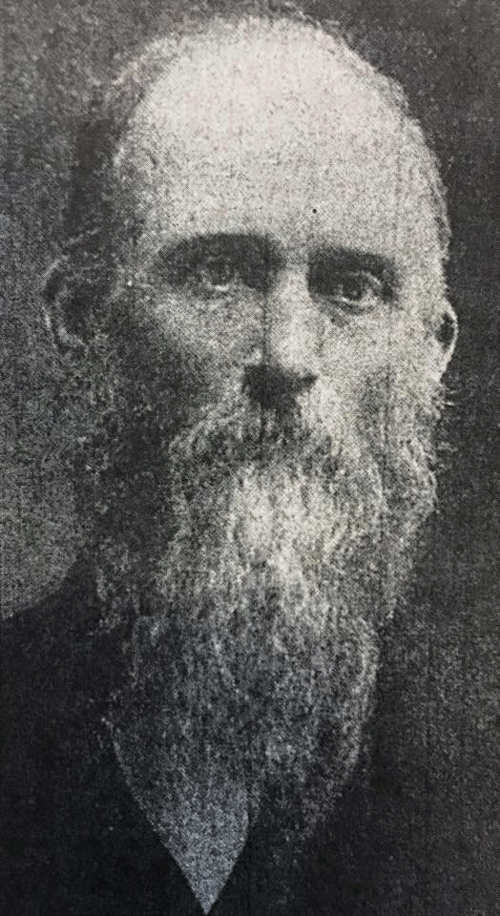
One of Several Readers Recognized in 1926 for being 50 Year Subscribers to the Western Star Newspaper - James C. Jeffries, born in 1842 in Black Township.
Great Midwest Tornado or known locally as the Griffin Tornado March 1925
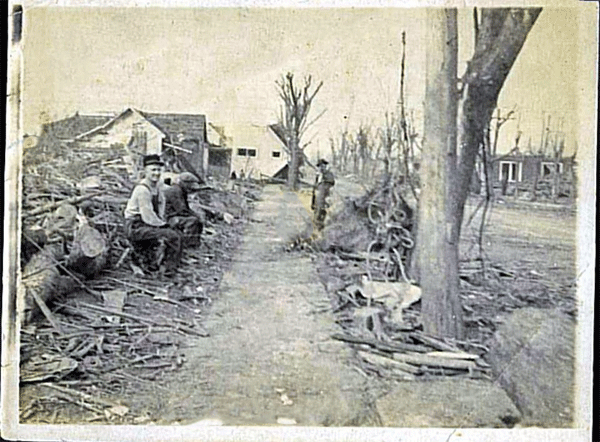
Great Midwest Tornado or known locally as the Griffin Tornado March 1925
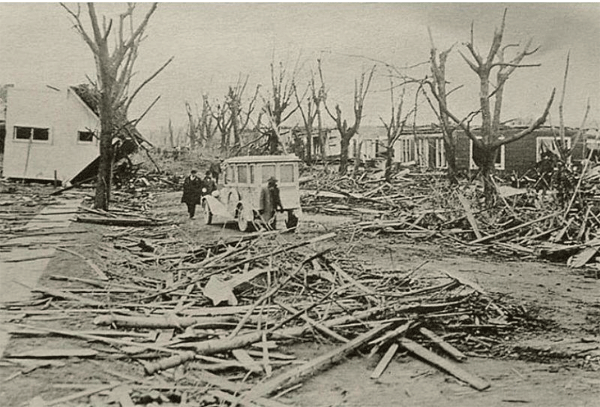
MV Chief of Police Also Ran A Dog and Pony Show.....1920's
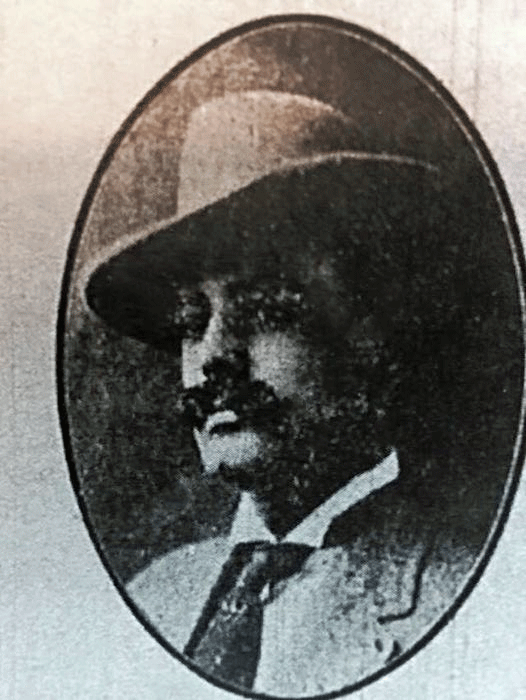
Frank Smith by all indications was a premier animal trainer and did engagements throughout the eastern and southern states. Right here in Mt. Vernon we had the winter quarters at the home of Smith at 321 East Water Street. He called it, "Smith's Society Circus," with seven dogs, three ponies and one monkey. All the animals were personally trained by Smith and had the distinction of being the only man in the world who ever trained zebroids in a circus ring. Although they never appeared in public, a half dozen zebroids on the Dr, Hasting farm in Point township trained with Smith as an experiment. In 1926, Smith did a a show here with the M.W.A. circus and was one of the best events of its kind ever presented here as the stunts of the performing animals was amazing. Wherever he took his show it was well received. During the winter months in Mt. Vernon the animals were given a thorough workout each month by their trainer. As 1926 closed the chief was slowing down due to the demands of his job, but he continued short distance engagements at county and city fairs.
Vaupel Concrete Plant.....1920's

Once beginning in 1910 was the A.H. Vaupel concrete plant occupying three blocks on East Fourth and one block on East Fifth street. It was putting out a capacity of 500 blocks a day. By the mid 1920's, from a meager start the business expanded to twelve men. Vaupel engaged in building culverts and highway bridges, curbs and gutters and the making of streets themselves. They mentioned that they were quite proud of the curb on North Canal street. His firm had the contracts for East Fifth street. At their firm they were busy manufacturing concrete blocks and concrete bricks and posts. Foundations, barn pillars, basement floors, fire places, and chimneys made from concrete were some of the things they did. Vaupel also had a warehouse on the C.&E.I. tracks near the Fuhrer-Ford Milling Company. That was erected in 1922 and was 30X80 filled with steel wire, facings, bars, road stone, rocks, asphalt, and metal culvert plates.
New Harmony High School held a "Indoor Circus".....1925
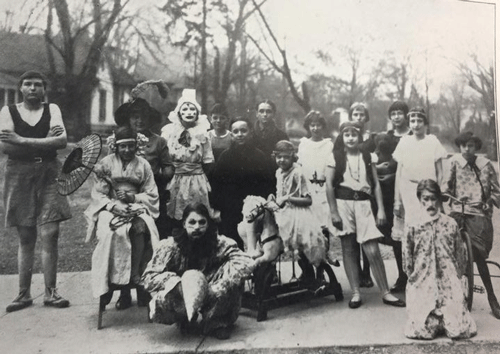
Mt. Vernon Decides It Needs "Stop" Signs For Driving Machines.....1925
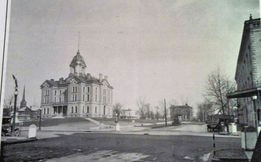
A new ordinance passed the city council and Commissioner Ed Green set out to take charge of the project. The signs were placed at each intersection on Main Street and on Second Street from Mulberry to the C&E.I. depot. On one side of the sign is the word "stop" in large six-inch letters, underneath which will appear the words, "Arterial Highway." The signs in the shape of shields were painted white, with black lettering and were mounted on an iron post. Keck-Gonnerman company manufactured our signs. Under the ordinance all traffic must come to a complete stop before entering any street designated as an arterial highway and no complete turns are allowed. On two "preferential" or "through" streets, automobiles will be required to park parallel with the curb, if there is one, with a distance of five feet between each auto. Other details will be figured out later.
Fire Hazards.....1924
Fire inspectors were giving the town the "once over," looking for hazards. Besides the usual rubbish, old sheds, coal oil drums and bad flues the most striking one was explosives in the warehouse of E.B. Schenk Hardware. On Wood and Sycamore they found hay stacks. Rohlman's store was called, "a fire trap."
1924 Drawing of Mt. Vernon Milling Company
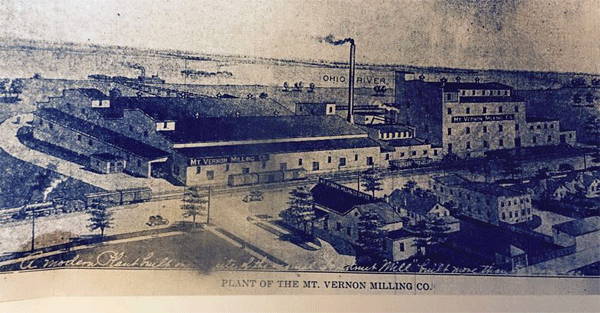
This $200,000 investment came after a fire that destroyed the Plan F Hominy Mill in September of 1924. This was on East Water Street.
Gonnerman Auto Company....1924
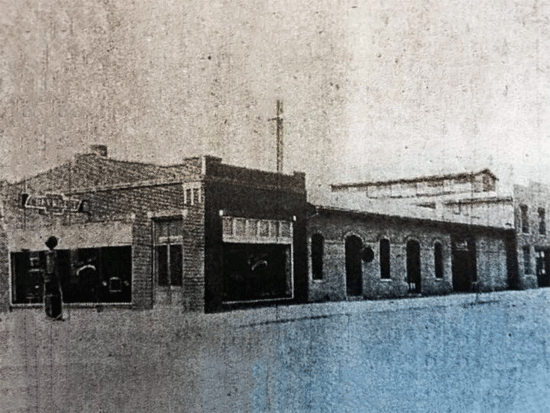
William Gonnerman, member of the manufacturing firm of Keck-Gonnerman was also president of the Gonnerman Auto Company on the corner of Second and College Avenue. Organized in 1924 for the sale of Chevrolet, Hudson, and Essex cars and Chevrolet trucks. This had been the John Derrington auto place, but the original building was not large enough for the new company, so additional ground was purchased in the rear and a two-story brick building was erected as the repair department. The old building was refitted also with a plate glass, and a salesroom. The personnel were Wm. H. Gonnerman, Robert A. Keck, David Alldredge, Charles Moye, Vivian Alexander, Henry Bartlow and several assistants.
"Billboard" Reproduces Western Star Artist's Cartoon.....1922
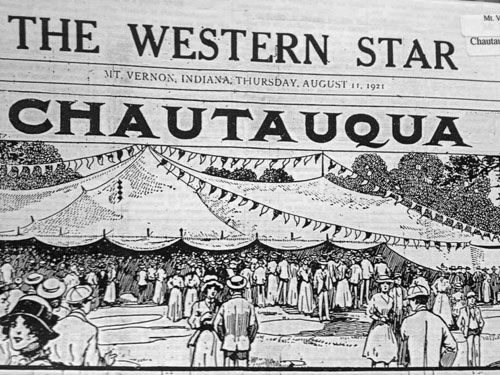
The issue of Billboard magazine on January 7, 1922 reproduced the Chautauqua scene in Mt. Vernon of August 1921. The artist was Mt. Vernon Western Star cartoonist, Martin Smith. The performers of the Chautauqua saw the paper and made several great comments about it and it found its way to the national news. The reproduction showed the same cartoon with the words: "Mt. Vernon Chautauqua, August 14 to 18, 1921." and below the cartoon are the words: "Bigger and better than ever before. Original cartoon drawn for the Western Star by Martin W. Smith." Chautauquas in Mt. Vernon were held at Black's Grove until around 1910 until they were moved to the Central school grounds after that school was built and a large storm caused flooding at Black's Grove causing loss of revenue. They were filled with political speeches, religion, local patriotic themes for children, and then national and regional acts of music, juggling, animals, comedy, etc.
Basil McFadden, Fullback MVHS.....1921
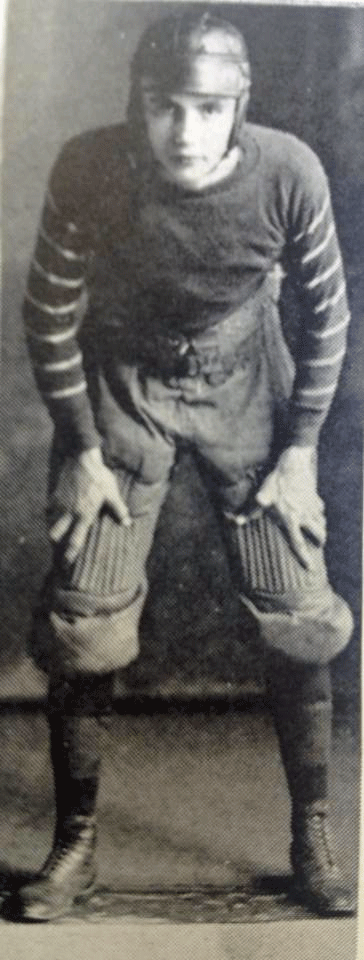
Guest Comment from Doug McFadden: He was my uncle and was a star at MVHS and Oakland City College. His cousin Charlie McFadden was a teammate at both. At that time cousin Merle McFadden was playing for Indiana State. Wavy: Some of the early football helmets going back to the 1890's were made by a local harness and saddle maker.
Ferry Runs to Kentucky Sandbar for Sun Bathers.....July 1921
The Flesher Towboat and Barge Line Service Company of Mt. Vernon made special arrangements for the utilization of the beach across from Sherburne Park for local sun worshipers. I can remember boating over there in the 1960's and camping out. Was told just this week that there was once a telescope on top of Fuhrer-Ford Milling that kept a keen eye on the bathing beauties.
Cheerleader.....1921
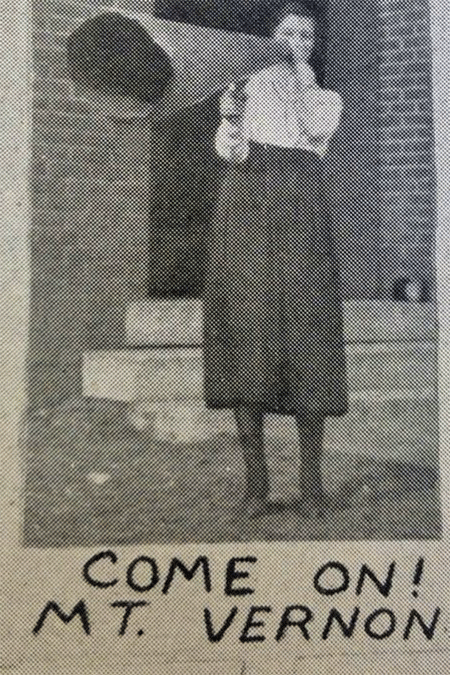
Holy smokes! Looks like Mr. Hames chose that skirt.
Modern Woodmen's Building In 1920's
This place had lots of names and events. First it was a Methodist Church built in 1852 on the site of Sam Scott's former cabinet shop. Now Sam he was a strange sort - a Revolutionary War soldier who made his own coffin and kept apples in it before he was eventually buried in it. The church began to grow until membership was in the 200's and a new one was erected on Sixth and Main in 1904. This building on Walnut Street was sold to the Knight of Pythias who used it as a lodge hall. They had a great band that once played in a parade in Washington D.C. The Knights sold the building then to the Modern Woodmen of America group. If you want to know more about these guys. google it. They had some rather interesting beliefs of exclusion. For a while the building also hosted Mt. Vernon High School Basketball games. The Woodmen finally expired and gave it to the city who used it some for dances and a youth center before, you guessed it: they tore it down. Two strange red bats were found in the building during the razing and a brick with the paw of a dog. That was in 1954.
Court Hotel - 1920's

The Court Hotel - where the post office is today...one of two photos I have ever seen of it...it's really not leaning either, just the angle. The Court hotel, corner Third and Walnut streets, at the end was managed by Mr. and Mrs. William Bishop. Mrs. Bishop supervised the food department while her husband the general management. They leased the building in 1922 and here they announced that they would have a place to have a night's rest and a home cooked meal. They succeeded with this in the number of persons seated about the tables in the two large dining rooms each day. Mrs. Bishop was known as a fine cook and there were never any complaints. Transients would come in and given special attention just like the regular boarders. Not the newest or the most modern place to stay in town, nevertheless the meals made it popular. Twelve large rooms were maintained. It was once the home of the late Dan Rosenbaum. This site was chosen for the new post office way back in 1911 when it was purchased. John Boehne was our congressman of our district then. An architect from Washington D.C. visited Mt. Vernon several times making sure his design fit in favorably with the surrounding public buildings. Work began in December of 1931 on Mt. Vernon's ninth ever post office and the Court Hotel became now a distant and probably forgotten memory.
Stewartsville Owls Baseball Team.....1920

1910's
1918
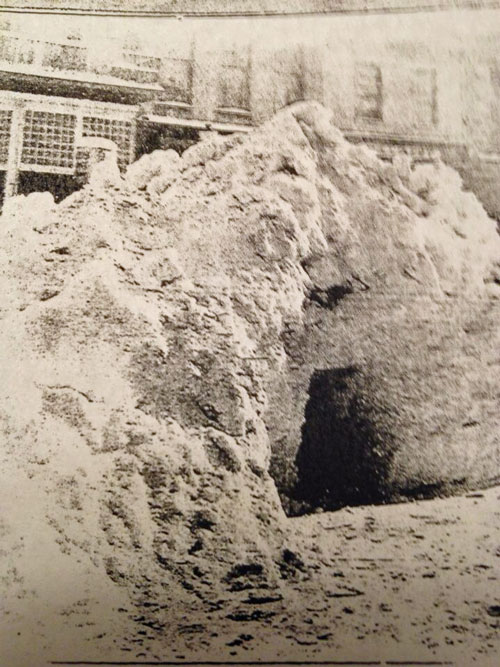
This was that terrible winter of 1917-1918.....the year the Cotton Blossom was destroyed by ice at our riverfront. Over 40 snow days that winter.
Louis Wassem and World War I Letters.....1918
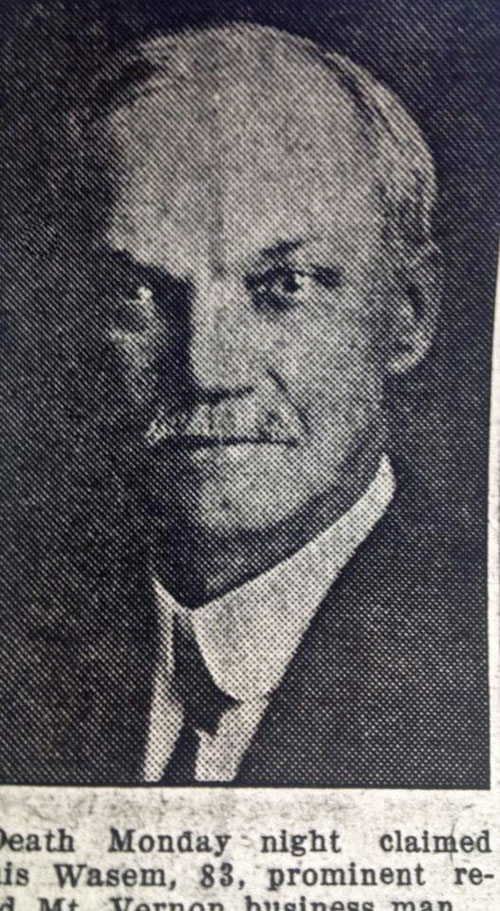
Two surviving letters sent home to family and friends from the front of World War I have survived from August and September of 1918. It seems Louis' job was an ambulance driver. He writes home of receiving letters and the Western Star infrequently through delays. He writes several times of being gassed. Once he said, "slightly gassed, but the effect has gone now. Gas shells fall from 11 p.m. until day break." Many times he drove his ambulance with a mask on. Once he took refuge in a farm house from the gas and covered underneath the doors with blankets to keep out the gas. When he drove, he dodged great shell holes, trenches, dead horses and bridges tumbled into the rivers. He also was shot at by an airplane. He mentioned hundreds of German POW's, but their will to fight still in them. Born in Bavaria in 1849 he came to America at age 16 and even then the trip over was eventful....it caught on fire, but was brought under control after a few hours. Here in Mt. Vernon he had a grocery business and died in 1936.
"I Was Older Then; I Am Much Younger Than That Now".....1918
The Western Star newspaper ran a story on Francis Hancock, known to his classmates as "Fossie." He had just put in 80 acres of corn, of which they bragged on because you see he was well over 75 years of age. Well, "Fossie" being a widower, was offended by that article because he was having quite a bit of luck with the ladies and when the paper told he was an old man...Well, "You guys spoiled it all!" All his lady friends he had "the caps for" would not give him the time of day...would not even wave as he rode past their homes. The Western Star apologized, but did not print a retraction. By the way, I (Wavy) am only 41.
"Baby the Wind Must Blow".....Summer of 1917
Posey County was going to have an excellent crop of corn that season, that is until a storm came in with winds reaching almost 100 mph. Trees and large limbs were blown down including a wall on lower Main Street. Barns were destroyed; ears of corn were broken off and would rot. The electric and telephone companies sustained heavy damage and the city was without power. It hit early in the evening of a large shopping Saturday in Mt Vernon. On West Second Street 172 dead sparrows were picked up by small boys and on East Second another bucket full. It was a bad day and yet going forward we had the great winter of 1917-1918.
"Clean Your Premises" Urged in Preparation of Centennial.....1916
As time quickly approached for the dates of the Mt. Vernon centennial, every citizen was asked to get busy and beautify their premises for the occasion. Soon visitors would be here for two days of festivities and the mayor wanted everyone to be sure that no one leaves with a bad impression of our "modern little town." He ended with, "cut the weeds, shave the lawns, clean the alleys and get busy!" Mayor Alonzo Grant, announced that auto drivers could use the Central School yards for parking purposes. The large shade trees will afford excellent picnic grounds for lunches and the building itself will be open for water and other conveniences. G.L. Hoehn also offered a lot at the corner of Fourth and Mill for Centennial purposes for parking. George Ashworth, a north main grocer also has parking places for 50 to 75 cars. At each of these places an officer will be present to take care of all property.
Centennial Parade.....1916
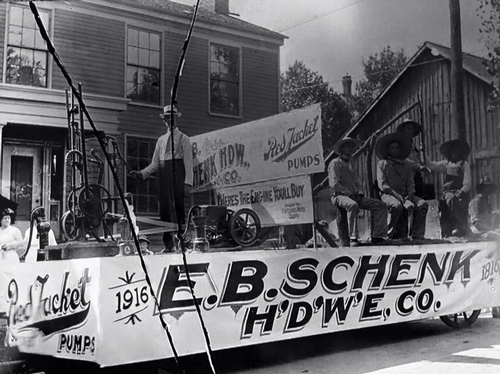
E.B. Schenk Hardware had a splendid float advertising the celebrated Red Jacket pump. Messers. E. B. Schenk, Jesse Wade, George Kaffenberger and Arthur Schreiber in their rustic costumes were a hit along the entire march.
Centennial Horseman.....1916
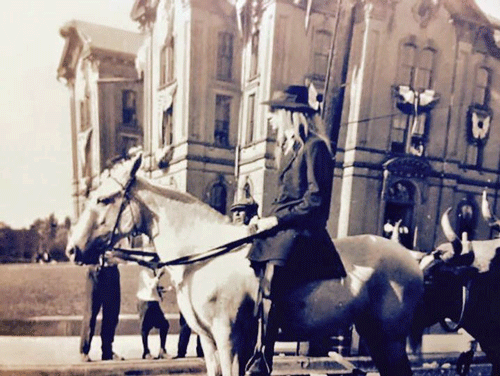
We had a couple of riders in the 1916 parade...Wm Maurer represented a religious circuit rider and Dan Williams played the part of Daniel Boone. Frederick Hagemann and Paul Dietz also were said to have ridden ponies. Good to see a "long hair" in the parade and on a white horse to boot!
Local Company Centennial Float.....1916
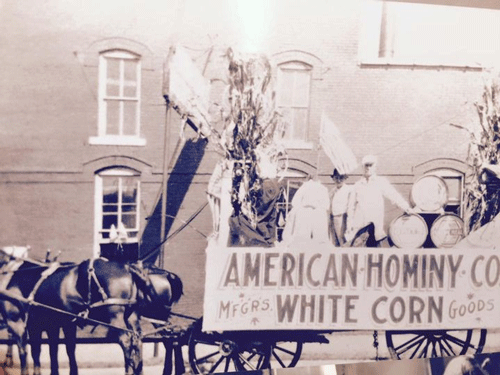
Hudnut Company corn products from the Water Street Mill...1916. Julius Brittlebank was an executive of this company for awhile and when he died around $90,000 was given to the city to have a park constructed in his name.
Old Newspaper Tells of Old Home.....1916
Cornelius Bradley has many descendants, including my wife. Cornelius was an Irishmen who came to the Virginia colony and served in the American Revolution. I believe he was in the Battle of Monmouth in 1778. Posey County records show he earned a pension for his service to the new country. A newspaper article during our Centennial celebration in 1916 listed historical sites in and around Mt. Vernon. Compiled by historian B.O. Hanby it said, "On the river, at the rocks on or at the Bluff was the site of the home of Hannah Bradley, wife of Cornelius, only woman in Posey County scalped by Indians. She is buried at Bradley Cemetery nearby." I am not familiar with Bradley Cemetery. McFaddin (one d, two d's, I or e, you pick) Cemetery....yes. I do know that at least one stone over time was found between Water and West Second during construction of buildings.
John S Hopkins in Evansville ... 1915
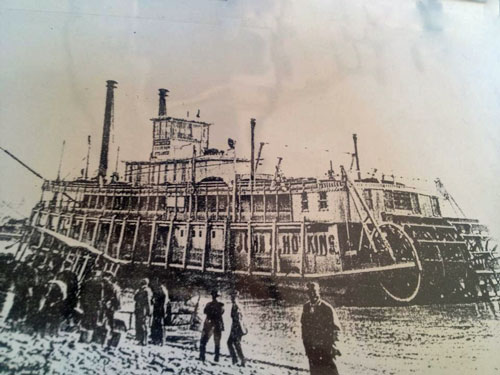
The John S. Hopkins was an excursion ship who docked at Mt. Vernon many times. This is 1915 in Evansville.
Relic of 19th Century....Evansville's St. Mary's Hospital Razed 1915
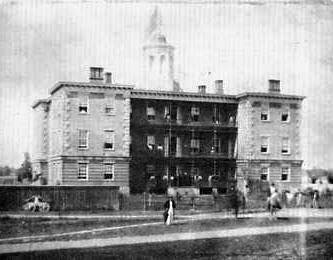
An old landmark going back to 1855 and important during the Civil War was razed in 1915. It stood at the foot of Wabash Avenue on Ohio Street. Two acres of land were purchased in 1852 on what was called Lamaso Wharf. In 1855 the marine hospital was built at a cost of $25,000. It was three stories of brick construction along simple lines. It had few rooms, but they were all large and each ward could hold forty to fifty cots. It was surrounded by large spacious grounds. When the Civil War broke, the government made it a military hospital to care for sick and wounded as few real hospitals existed in Kentucky and Indiana, at least close to the river. Thousands of soldiers wounded in the battles of the Cumberland River were brought to Evansville and treated here. A Dr. McCoy, living in 1915 remembered visiting the hospital in 1863 and said the whole west side was literally covered with tents with soldiers from both the North and the South. Some of the men waiting to be treated came directly from the battlefields of Fort Donaldson, Fort Henry and Corinth. McCoy moved to Evansville in 1873 and was the appointed surgeon of the L&N Railroad and spent most of his time within the walls of the hospital. After the war, it was converted again to a marine hospital until 1881 when it was sold by the United States to the Sisters of St. Mary. It moved out in 1893 to a new facility on First Avenue. It spent its last days as a tenement.
The "Last Bean Supper".....New Harmony circa 1915

I have run across two of these photos. The other one I have seen was during the Centennial year of New Harmony in 1914. The bean suppers were held in honor of Veterans on Decoration Day or Memorial Day as we call it now. The now defunct Cynthiana Argus newspaper under editor Doyle Oursler, ran this photo in 1991. It is from a then 85-year-old lady, whose grandfather Jonathon Kelton is shown in the second row, second from the left. Jonathon was married to Mollie, the daughter of Major Jesse Nash was an officer in the 16th Regiment of Indiana Volunteers in the Civil War, made up mainly of Posey County soldiers. Nash had come to New Harmony from out east right after the Rappities, possibly as early as 1815-1816. Possibly all of these men are Civil War Vets. Names were not written down but those known are: Shady Stalling & Shanklin Ramsey of Wadesville and Mr. Poet (first row, first from left) and Mr. Sanders (first row, 4th from left) of New Harmony. The picture was taken by J. Moore Smith, a New Harmony photographer. The woman remembers as a young girl her grandfather coming home and saying, "this was the last of the bean dinners so take good care of this picture." The granddaughter was sad that she had not written down the names of the sixteen veterans. "So easily history is lost, when we fail to record our own present events."
New Harmony Centennial Booklet.....1914
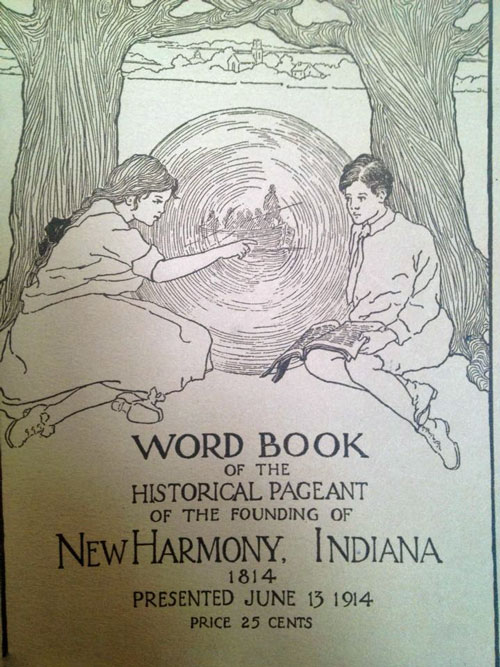
This cover of a little pamphlet I discovered in a paper file at Willard Library. I had seen one of the festivities of the New Harmony Centennial before, but this one was quite different.
"94 Feet" Is Not the First Movie Made Here....Let me Tell You of June 1913
A few years go in one of my earlier volumes of Ray's Ramblings I wrote of a Mr. Randall of Evansville representing the S & R Film Company. He came here to our city for two days taking motion pictures for his company. The first work he tackled was our fire department showing the hose house horses of our City Hall building being harnessed and later he filmed them making a run south on Main Street. Wouldn't you love to see this footage? After that as the apparatus was returning on Main Street, he took a view looking North on Main, showing a great throng of people, the monument and the court square. The next scene involved Chief of Police Smith arresting a chicken thief. The thug coughed up everything from chickens under his coat to razors in his pocket. The next morning, he took pictures of the Keck-Gonnerman foundry, the Strawboard factory and Sherburne Park. He took more scenes of the Fire Department on a run, the laying out of hose, and views of a street cleaning machine. He filmed members of the Mt. Vernon Commercial Club and the railroad depots. The film was about a thousand feet long and was to be shown in Mt. Vernon in about a week. Not exactly a feature film, but I would LOVE to see it!
19th Century Love Affair Remembered .... Tombstone Erected to Lost Love in 1913
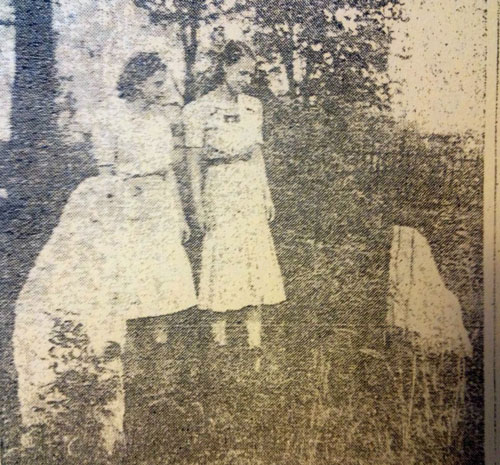
In youth Clem Weiss was in love with Anna Liza Ham until one day they had a quarrel. It ended their romance and he headed west to California and became a physician in the late 1860's or early 1870's. Around 1913 he came back for a visit and asked about Anna. Only the oldest citizens remembered her and they could not confirm if she ever married. Clem was told she was buried in the Old North Cemetery, an unkempt burial ground behind what would one day be Mt. Vernon High School. He employed a man to locate her grave....there were no markers. He found the location or close to it and Dr. Weiss, in a last gesture for the woman he had loved in his youth, ordered two stones erected. They were ordinary stones, bearing no name or inscription. By 1938 when this photo was taken they had become ragged and flaking. They no longer exist sadly. The stones were placed on the crest of the hill, nearby are the graves of the old Leonard family, a family burial ground, not part of the old North. The old stones of over 500 people are now mostly gone...the Juliet North who died in 1834, the Hector Craig of 1836, the Welborn's of the 1830's and 1850's, the Mexican War veteran, the grandmother of a Secretary of State, the original stone of Judge Pitcher (replaced), the relatives of Governor Hovey. Long gone too are the names of Thomas Newman, Aaron Baker and Jesse Baker. Dust to dust including the hanged murderers of 1884 Anderson and Snyder. There were maybe as many as 50 Union soldiers buried here and victims of the cholera epidemic of 1873. What's done is done sadly.
Indiana State Board of Health Lists MV Company as an Environmental Concern to Ohio River...,.1911
In 1911 the Board of Health listed 28 manufacturing concerns to health on the Ohio River, 20 of which were in Southern Indiana. Evansville had seven locations and we had one, the Mt. Vernon Strawboard Works. At that time, we had 75 workers and they were concerned with the 600,000 gallons of water used for washings per day and the 200 barrels of lime used doing it. The Board of Health had got their first laboratory in 1906 and immediately started testing water supplies within the state, both river and wells. One report said, "in its raw state, the river water is contaminated and unfit for drinking purposes at any point along the survey....it should not be used without purification by filtration and chemical treatment."
The Ohio River Water Survey.....1911
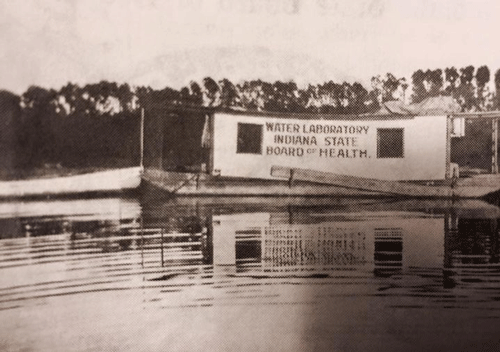
In 1911, the State Board of Health undertook a major survey of the Ohio River that bordered Indiana. Scientists traveled the river in a houseboat outfitted with the latest testing equipment. The idea was to ascertain the suitability of the river as a source of domestic water supply and to what extent manufacturing was polluting the water......You really don't want to know. Do 'ya? Well, in the raw state the river water was contaminated and unfit for drinking at any point along the state. They said it should not be used without purification and could only be made safe by filtration and chemical treatment. In 1913 that same board authorized the General Assembly to enforce towns and cities to change their ways. Health was a mess...we still were fighting new battles to safeguard our food, medicines, etc. Laws, yes laws were made for butter for cold storage, to sanitary school houses, rats, weights and measures, clean milk cans, hospitals, sanitary mattresses, fertilizer reduction, false advertising, mausoleums, child neglect and working laws, drainage, reclaiming land, the pickup of rags and paper stock, the cutting of weeds, the open containers to flies and on and on. The government stepped in to fight epidemics, cure disease and safeguard our lands and food. Big government good....small government bad....democratic socialism good....fascism bad. Have a good day....time for town hall meeting.......Bernie!
Buster Brown Advertising.....June, 1910
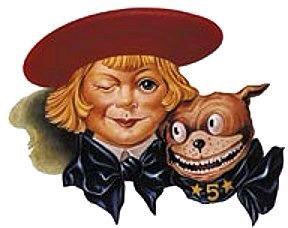
In June 1910 a midget dressed as Buster Brown and a pit bull playing Tige were put in a store window at Stinson Bros. to draw a crowd into the store. Buster Brown Shoe Company had hundreds of these traveling midgets with their little dogs too traveling the country for advertising.
What To Wear to High School Graduation.....1910
Thirty-three in the graduating class that year assembled at the court house. No yearbook yet, no real photos have surfaced. But they were there...class colors were maroon and old gold. A well to do graduate had her dress made by a local dress maker. I guess they didn't wear gowns. It was colored silk with sheered sleeves and crystal ornament on the front valued at $5. No cap for this ceremony. She wore a big leghorn hat with a black velvet brim and the crown was loaded with flowers! The student in remembrance said it was very heavy and gave her a headache. She described her hair...."over a rat around my head with some little curls hanging down in back." As a graduation gift she received three pairs of silk stockings.
What To Wear to High School Graduation.....1910
Thirty-three in the graduating class that year assembled at the court house. No yearbook yet, no real photos have surfaced. But they were there...class colors were maroon and old gold. A well to do graduate had her dress made by a local dress maker. I guess they didn't wear gowns. It was colored silk with sheered sleeves and crystal ornament on the front valued at $5. No cap for this ceremony. She wore a big leghorn hat with a black velvet brim and the crown was loaded with flowers! The student in remembrance said it was very heavy and gave her a headache. She described her hair...."over a rat around my head with some little curls hanging down in back." As a graduation gift she received three pairs of silk stockings.
Memorial Day.....1910
That's is when the best team of horses would be harnessed with their tails and manes braided in red, white, and blue ribbons attached to the head piece of the bridles. They would be sent down to Sy Kirk's shed where the cannon was stored and hitched to the caisson it would take its place in the parade just behind Major Kimball, astride Dolly his favorite saddle horse. Behind that would be Civil War veterans, Spanish American war vets, the Ladies Harrow Relief Corps, patriotic organizations and small children carrying flags. The parade started at the L&N depot and marched down Main Street to the river. There the caisson would be positioned to fire across the river in front of the speaker's stand decorated in red, white, and blue bunting. The band would take its place and the dignitaries behind the stand. A few patriotic songs were sung, then the ladies of the relief corps would be on a barge anchored up river and on a signal would release a small float with a wreath of flowers on it. As it drifted by the riverfront, one of the cannoniers would light the fuse and the cannon blast in a tremendous roar. They fired 21 salutes followed by more music, lesser speeches than the known public speaker. On this particular holiday, sixth grader Sherman Carr was picked to read Lincoln's Gettysburg Address.
Involuntary Baptizing.....May 1910
Andrew Alldredge around noon went down to John Doyle's fish dock, south of Moeller's stave factory, and while watching them clean fish on the slippery dock, his feet slipped out from under him and he plunged into the 20 feet of water and disappeared. Doyle kept his eye on the spot Andy made and when he surfaced, he pulled him out and "hung him to dry." At this point the current was swift, and he was lucky someone saw him fall.
Chas. A. Greathouse Elected As Superintendent of Public Instruction on State Ticket.....1910
Greathouse, formerly from Mt. Vernon was elected by the state democratic committee on August 25th in Indianapolis to take the place of Robert Aley, as superintendent of public instruction. Greathouse spent the greater part of his early adult life in Posey County in the cause of education. He was a country teacher, and principal of Mt. Vernon High School and county superintendent of Posey County for ten years. In business he aided in the organizing of People's Bank and Trust Company at Mt. Vernon and served as its president. At the time of his election he was 40 years old and a graduate of Danville, Indiana, normal school. He studied at Indiana University and lettered in football in 1891, 1892, and 1893. This short biography was provided by the Evansville Advocate, a union newspaper in 1910.
1900's
Mt Vernon Brownies.....1909
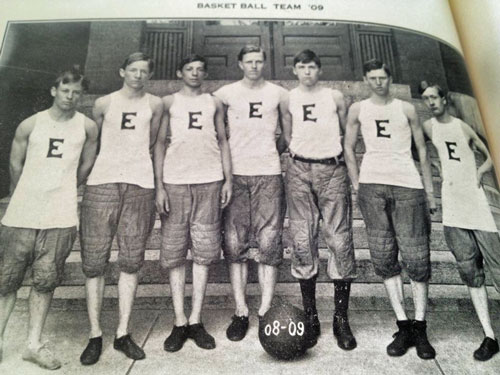
My earlier book, "From Brownies to Wildcats" published in 1983 did not have that we played Interscholastic basketball until 1911-12....A Evansville High School (Central) annual says something different. According to the 1909 Evansville yearbook we played three games against them one each in the months of December 1908, January 1909 and February 1909. E.H.S., then the only high school in Evansville defeated us 30-15 in Evansville and then they came to Mt. Vernon where they got us again 28-22. The last contest, again in Mt. Vernon, we defeated our Evansville rivals 29-21.
Black Local Civil War Vet Had Hard Life.....Dies 1909
"Uncle" Si Johnson, one of oldest of his race in Mt. Vernon and for years peddled kindling throughout the city with an old broken down horse died at his home in the eastern part of Mt. Vernon from the effects of a recent paralytic stroke. He was 69 years old, a veteran of the Civil War, and was survived by a wife, son and an adopted daughter.
Soldiers and Sailors Monument.....1908
The idea of the Soldiers and Sailors Monument at the courthouse and dedicated in 1908 came from a local man, Christian Dannheiser, who was born in Bavaria, Germany and worked at the Keck-Gonnerman foundry. Major G.V. Menzies and Leroy Wade became interested and a petition drive was created. Taxes were raised for the monument of which it cost about $14,000.
Steamers Joe Fowler & John S. Hopkins were frequent visitors to Mt. Vernon. Here they are shown at Elizabethtown.....1908

Flesher....A Name of Posey Rivermen......1907
Around 1907 a man named Millard Flesher and his younger brother Isaac Newton Flesher came to Mt, Vernon and were owners of the Flesher Towboat Company. They came here from Ohio, Their father was Andrew Jackson Flesher (1827-1898) and he was in the ship building business for 55 years owning his own sawmill and soon was one of the foremost boat builders in the Ohio Valley. He once owned over 30 boats himself and was said to have built over 150 for others. The great flood of 1884 took much of his wealth, but the Christian man just sort of shrugged his shoulders and said it was God's will. The boys came here and Isaac N. and his wife Belle were well known. The Belle V. Flesher was the party barge that ran excursions from our wharf. As steam engines gave way to diesel fuel the Flesher's influence waned. Millard moved on to Arkansas where he is buried, a son, William Jackson Flesher hung for a while working on river boats on the Ohio River.
John William "Jack" Frost....Prominent Artist and Cartoonist's Parents Lived in Mt. Vernon early in the 20th Century.....
In 2010 Frost at age 90 passed away in North Carolina. He had been born in Evansville Indiana in 1919 to Oscar and Jenny Edson Frost former Mt. Vernon citizens. He studied at the Art Institute of Chicago then went to work at the art studio of Johnstone and Cushing of New York city. He also had eighteen years as a magazine cartoonist with the Charleton Pubishing Company of Derby, Ct., a leading comic book producer. In addition he did several nationally syndicated comic strips and editorial cartoons for Connecticut and North Carolina newspapers. In 1946, the Evansville Courier had a write up about him in Karl Kae Knecht's column saying in that particular year he had done cartoons for Pepsi-Cola in Red Book and American; True Stories and Liberty and even a Ex-Lax cartoon for New York and Boston newspapers. His art work that year was seen in Pic, Seventeen, Calling All Girls, and the Detroit Athletic Club Journal among others. By 1946, Mrs. Frost was working for the War Department in the Pentagon.
William Harrison Green with Hose Wagon of Mt. Vernon Fire Department.....Early 1900's
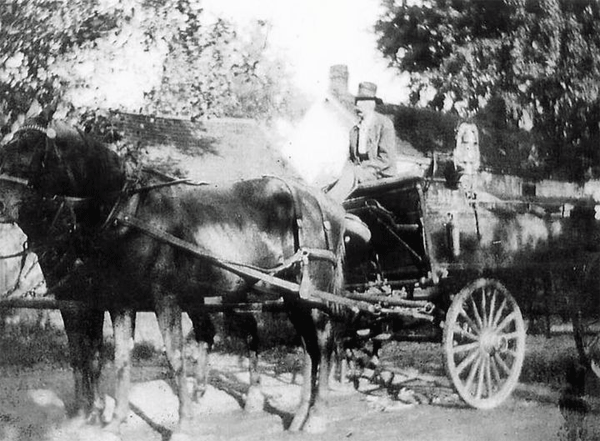
Photo supplied by relative of Green's....Arthur Thomas.
The Swinging Bridge of Mill Creek.....1905
Long ago a footbridge, a shortcut for pedestrians was constructed over Mill Creek of wooden barrel staves linked together and suspended by wire cable supports attached to trees on each side of the bank. It spanned about twenty to thirty feet and had a swinging motion irresistible to youngsters in that era. Children would jump up and down on the bridge and watch it rise and fall in ripples across the span. Sometimes they would make it go side to side in a huge arc. I guess it was dangerous, but it was a different time. Many a daring young man took a plunge into the waters below and swam out to the bank.
Alexandrian Carnegie Library Cornerstone Laid.....July 28, 1904
With 46 brothers present the lodge was called in special communication as a Grand Lodge for the purpose of laying the cornerstone for the Carnegie Library building at Main Street. Deputy Grand Master A. W. Emery received commission from the Grand Master Grimes to act as Grand Master on the occasion appointed Bro. Barker as Deputy Grand Master, Bro. S.G. Howard as Grand Marshall, Bros. C. Buchanon and J.J. Jones as Grand Stewards. The Grand Marshall then formed a Grand Precession and the Lodge marched to the Carnegie building headed by the Mt. Vernon Police over Second Street to Main, to Fifth. The cornerstone was laid in Due and Ancient Form with an address made by Rev. Lithesland. The procession was again formed and returned to the Lodge Room. I am sure a "Grand" time was had by all.
Warrick County Minister's Strange Request Carried Out....1904
In February of 1904, the New Harmony Times reported that the last request of a minister of the General Baptist Church at Folsomville was to be stood up in his pulpit during his funeral. His request was followed to the letter and as mourners came to the church, they saw the "glassy eyes of their old preacher looking out over the audience. The eyes never moved, set in death." This strange funeral had live ministers moving around speaking the burial tributes and "practically every eye was fastened upon the half reclining corpse in a coffin behind he pulpit. The ministers were often interrupted with shouts of some hysterical listener watching the scene. Here was this silver haired pastor, life gone, lips sealed forever, yet his eyes looked upon the faces of every man, woman in child in the audience. The minister had preached 45 years and the coffin was tilted back just enough to prevent his lifeless body from falling forward against the pedestal on which rested his Bible.
Crime After Dark....Evansville 1904
Crime happens in every decade. Here are a couple of strange ones from Evansville: A man was beaten and bloodhounds were sent to find a clue chasing a suspected man who committed suicide when cornered by jumping into a creek. After body recovered, the victim said he couldn't identify him as his assailant. In a saloon on Water Street a man was knifed and the perpetrator used as his defense that he had been knocked senseless by the other man's wooden peg leg. He was given a sentence of six months and fined $100. A woman struck her husband on the head with a hammer and slashed his throat with a razor. She was declared insane, and after two months in the asylum she was declared cured and released.
Life in 1902
Back then life expectancy was 47 years. Only 14% of the families had a bathtub and if you were lucky enough to have one of the 8000 cars in America, you only had 144 miles of paved roads to drive them on. Be pretty hard to buy a car when the average wage was 22 cents an hour and you made $200-$400 a year. You were probably born at home....95% of the people were. Only 6% would finish high school, and your physicians? 90% of them had no college education. Women washed their hair about once a month in borax and egg yolks. In that year only 230 reported murders in the entire United States. No need for gun control just yet it seems. Crossword puzzles, canned beer, and even ice tea had not been invented yet. One could go to the pharmacist and get marijuana, heroin, and morphine over the counter at the drugstore. "Heroin clears the complexion, gives buoyancy to the mind, regulates the stomach and the bowels, and is in fact a perfect guardian of health" an ad said. Cocaine was given to you at the dentist office. Soon in Coca Cola. It wasn't until that socialist republican, Teddy Roosevelt pushed all those progressive ideas like the Pure Food and Drug Act that regulated the safety of our medicines and food. No Mother's or Father's Day cards to buy, Sara Palin's Alaska wasn't a state yet and the speed limit was set at 10 mph. It would have taken a long time to drive to Las Vegas but why would you go? The population then was 30 people. California was then the 21st more populous state in the union with 1.4 million residents. No sky scrapers yet....the tallest building in the world was the Eiffel Tower. The "good ol' days?"
Evansville Journal as Teddy Stumps for McKinley...a Year Later McKinley would be Shot Down and Roosevelt would be President.....October 1900
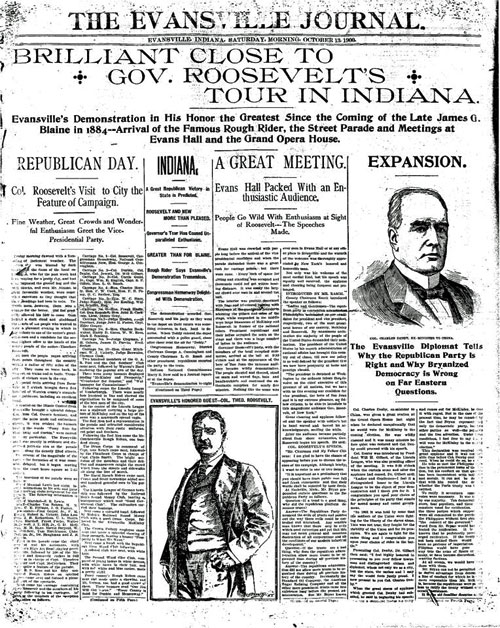
William McKinley and Theodore Roosevelt would lose in Posey County with the Democrats William Jennings Bryan and Adlai Stevenson winning 55% of the vote. Roosevelt would lose again in Posey in 1904 to Democrat Alton Parker. Roosevelt was the youngest President ever and except for his militaristic ways he was a good progressive....immigration was booming, he pushed universal health care, old age pensions, federal employment insurance, food and drug protection, dined in the White House with African American leader Booker T. Washington. Put big business in their place, protected the environment, ended trusts and came out for a "square deal." A square deal he said, "refutes the popular idea that the Republican party always legislates to aid the rich and oppress the poor." READ THAT AGAIN! What would be the percentage of chance that such a candidate ....the improbability of the degree of success that such a candidate could win the Republican candidacy today? Zilch!
Negro Life Insurance Policies.....1900
Did you know that the black population of the United States has a higher percentage of people with life insurance than any other race? The reason why maybe that blacks have an historical relationship with it and didn't want to trouble relatives for burial. Long ago white insurance salesmen sold the policies door to door and black families were allowed to only buy as much as it would cost to bury themselves whereas white folks could buy more coverage and pay lower premiums. Blacks were looked on as higher risk with lower life expectancy. Still blacks today see it as a way of passing on wealth to their heirs in a way they may not have had another opportunity. Here in Mt. Vernon when a person died, the several undertakers would hurry to the home of deceased black person and get the insurance money. Whatever the insurance sum was became the cost of the funeral.
1890's
~Wavy Trips Back in Time to 1893
Beautiful morning as I wake up at the Kahn Hotel across from the Court House. I was awakened by the nightwatchman Charles Glass so I could catch my packet south on time. I slide out onto the curb, and pick up a newspaper and a sandwich from the corner stand on the alley south of my hotel. No time to go to a restaurant. Glass has secured a dray for my trunk of wares and luggage. I decide to walk to the wharf. I talk to a man leaving from the hotel who is heading to the Chicago World's Fair by way of the E. & T.H. railroad. Tickets were $9.25 round trip and he will be gone one week. I stop into the Globe Cigar Store on Second and Main for a couple of choice cigars as I make my way south to the Ohio River. I give my ticket and board the small steamer, puff from my cigar on deck and read the Mt. Vernon Democrat. Reports of a unexplained explosion in Shawneetown, Illinois that is some sort of a riddle. Newspaper editor seems to think it was some sort of heavenly body, called a "meteor." Very queer news it was. Mt. Vernon news had a shooting at the Burris Saloon on Main Street the night before....four shots fired, only one hit its target; yet it took effect striking the rib and ranging upwards. It hit an ex-con, but Dr. Spencer extracted the ball and says it would have been fatal if the cartridge had been filled properly with powder. High School graduation news was on page three.....Alumni entertained the group at the Masonic Hall. That's that large unusual shaped building on Second and Store Streets. The music was provided by a Juvenile Orchestra, all under 15 years of age. After speeches, music and readings the folks had refreshments of ice cream, cakes and lemonade. Well, that's about all the news from the four page paper. We are underway, and I kick my feet up on the rail, enjoy my cigar, and watch the little town of Mt. Vernon drift away in the distance as we head to the next stop of my journey.....port of Cairo, Illinois. "Watch the river flow."
Lightning Deaths.....August, 1899
James Barnett and William Pitcher were killed by lightning while wheat thrashing in August of 1899. Pitcher's straw hat had its brim burned off.
Western Star Newspaper....February 27, 1899

Cuba?.....Let's Talk 1897
With Obama making big moves to normalize relations with Cuba, I thought I would revert back to a story I wrote in Volume 3 of Ray's Ramblings: Back in 1897 Mt. Vernonities were always filled with enthusiasm for a good mob demonstration. Pent up feelings for freedom for the Cuban people was the printed reason; but you never know. The island was in charge of not Castro but a former General named Valeriano Weyler, or as our residents were calling him..."Weyler the Butcher." A carefully made and life like effigy of the general was hung to the breezes, with a rope around his neck, on the telephone pole in front of Fogas' Drug Store on the corner of Second and Main. Sympathizers of the belligerents danced around for about an hour assaulting the dummy with tin cans, rotten eggs, old vegetables, rocks, bricks, tobacco spit, and anything else they could find. A good time was had by all I guess, and the police made no arrests. He was finally pronounced dead and taken down. An inquest was held over the remains and they feared the spirit of the Governor might do some sort of voodoo damage so they bound the dummy in chains and consigned him to the local rock pile. The next day Officer Reagin found it and burned it. There you go....take that you dirty rat!
Armstrong School #2 in Cynthiana.....1897
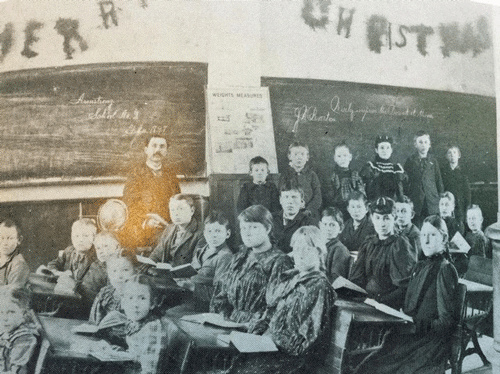
Notation said the photo was taken in February....just a little slow on taking the decorations down.
Fred Carr.....1896
"When a black man hates a white man he narrows and degrades himself. When a white man hates a black man he narrows and degrades himself....If for no other reason each should love one another."....MV black activist....Fred Carr....1896 I wrote several stories in earlier "Ramblings" about Mr. Carr, an educated columnist for the Mt. Vernon Republican late in the 19th century. He wrote church news, community news, and advice to the unemployed and to young people. He took steamboat trips on the Ohio River and reported back on how to get along. He said "for reasons of environment and early parental teachings, one may have disliked the Negro and may have refrained from making contact with him. Maybe you have always degraded and thought of him as a unworthy creature. Maybe you should resolve to make a change, experiment, show effort and pray about it. Think about your fellow man. Mind you, my plea is not for the sake of the negro alone, but for the white man. A man is not free when he is compelled for any reason to hate this man and hate that one simply because of some differences in the tincture of the skin, or peculiar shape of the nose, or curl of the hair. Thousands need to be set free....white and black....free to love the world. Show me a man that dislikes another human being on account of race or color or religion and I will show you a weak man, holding back his own growth, his own development. Let the soul loose."
Young Boy Thinks the Editor Has it Made.....1896
It was a Sunday baseball game in New Harmony between them at the Cynthiana Lockwoods when a young boy walked up to the editor of the Argus and said: "You must be the happiest man in the world. You can go to the circus in the afternoon and evening without paying a penny or to a hanging, a theater and you get wedding cake sent to you at your office. If someone gives you a hard time you can get back at them in the next issue." The old man thought it over some and said he might be right. The kid continued to think of more examples. "You don't have to go to bed early...you can stay up late and see everything that is going on. When I am a man, I mean to be an editor too and I may stay out late at night. That will be jolly."
Oak Hill Cemetery Ordinance Violated but Charges Dropped.....July 1895
In Evansville, three prominent ladies of that town were arrested at the cemetery for cutting slips from a rosebush upon their own lot, intending to take them home and plant them in order that in case the bush died they would have others of the same species to replant. The cemetery trustees as well as the police officer met in court and the judge dropped the charges.
Mason Cornerstone of "The Castle".....June 24, 1895
The old high school that once stood at the corner of Store (College) and West Fifth had a cornerstone that the Masons presented that cost $4 and had a copper box time capsule valued then of $1.25. Again the lodge marched up Second Street to Main and down Main to 8th Street, down 8th to Store, down Store to the building. After the ceremony and two eloquent speeches I am sure they returned back to their lodge. In that year the lodge paid their first ever funeral for Brother Campbell. The cost was $25 to H. Weisinger for embalming and burial and $7 to same for grave and lot. Henry Weisinger 1835-1905 was also a member of their lodge.
"Live by no man's code; lest you wind up on this road.".....1895
A gang of tramps came into town and two of them worked the "sore arm racket," securing enough money to buy three quarts of "happy red eye," and along towards evening they headed down to the depot with the intention of catching the next freight. They had a run in with the conductor, who was a hard customer to work with it seems and a fight ensued. One of the freeloaders came out of the skirmish with a very sore head, and three others made themselves scarce soon afterwards. One was so drunk that he could not get away and was taken inside the depot through the kindness of the agent to thaw out and await the authorities. The temperature was minus seventeen degrees two nights before. The constable sure has his hands full with rascals at the railroad week after week.....a heavy burden indeed.
"Preach a little gospel, sell a couple bottles of Doctor Good.".....1895
Dr. Newman was his name...."Wonder upon Wonder....with marvelous powers!" That year the doctor traveled around Corydon, Jasper, Poseyville, Cynthiana, St. Wendel and New Harmony to name a few towns. Nightly at the Thrall Opera House in New Harmony that summer in front of hundreds the wonder man would stand on stage cure people of stammering, rheumatism, club foot, deafness, tumors, and liver ailments. He was a 19th century wonder all right separating men from their money with some alcohol laced elixir and fake healings. He was said to have given away gifts to the audience of silver butter knives, spoons and gold pens. I doubt that they were real...I mean how many bottles of Dr. Newman's Worm Extractor would it take to buy even one spoon? The newspaper was full of his ads and testimonies of people by name he had healed....."every night the men would come around and lay their money down."
Peoria, Illinois Herald Editor Slams Posey County about White Caps.....1895
First of all, whitecapping was a violent lawless movement among farmers in the late 19th and early 20th centuries in the South and were rumored to have been in our southern part of Indiana, Kentucky and Illinois as well. It had a distinctive anti-black characteristic and enforced what they thought were traditional family values and standards. It actually was founded in Indiana in 1873. Some say our lynching in 1878 had those markings of their group. Our own favorite son governor Alvin P. Hovey had explained one of the programs he planned to do in his term was to weed these people out of the state. He died in office in 1891. Now back to the Peoria story, this particular editor said he was afraid to visit this part of the state because of the white caps and admitted he had never been here. The Terre Haute Tribune took issue with Peoria and came to our defense in editorial. Terre Haute praised us for our history of scientists, educators, the growth of libraries and the recording of fossils and geographical information. New Harmony was rich in science with their "Boatload of Knowledge" and did not need to be slurred by a newspaper, Owen who planned the initial work of the Smithsonian Institution and women got some of their most early rights in our area. The truth is we have and had bad and good pianos and pistols, preachers and criminals. It was not and is not one or the other. Let history judge us wholly not holy.
Western Star.....1894
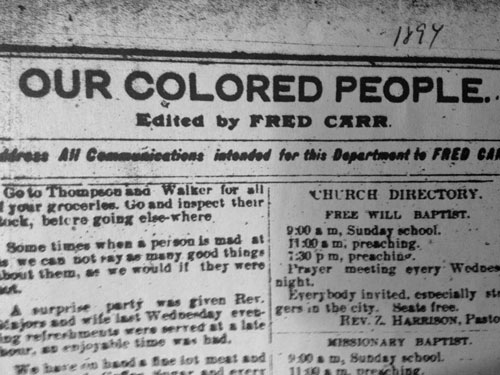
This was the first time I ever saw a column written by and for the black community in Mt. Vernon. I have written about Fred Carr in my previous volumes. This lasted a few years and it would be decades before we would see them again in the Western Star newspaper. This column mentioned black churches in Point township and Brewer Hills also. One speaks of a basket meeting in Point where several people were baptized. We can't give the paper too much credit because the newspaper at that time continued to describe African Americans in the worst derogatory terms. Even the obituaries of black men that white people liked were full at times with racism.
National W.C.T.U. Leader Speaks at Methodist Episcopal Church on Temperance.....1894
Mrs. E.L. Calkins, then of Indianapolis and Vice President of the Women's Christian Temperance Union delivered an address at the local M.E. Church. Later she would move to Michigan and become President of that organization for twenty-one years, retiring from that position in 1926. In Mt. Vernon she said: "Young man, dost thou go abroad in the land at night and rush the growler, and perambulate the streets at an unreasonable hour? Dost thou whoop 'em with the boys and finger for subsistence in the jackpot and back thy sheckles against the ever slippery tiger? Art thou a guzzler of beer and player of cards? Dost thou suck the pernicious cigar root and hast thou lost thy grip on the ways that are rigid and wisdom which is good in the world? Verily, verily, I say unto you, if so, thou art in a bad row of stumps, and thy name is pants with a big P. Thy heels will fly up ere long, and thou will find thyself floating in the soup. Keep thy lips from the jug that contains the intoxication juice, and steer widely of the aces, and in the ripening years of thy life thy pocketbook will be full."
Play "Cracker Jack" Portraying a Live Hanging Seen at Masonic Hall.....1894
A play called "Cracker Jack" had a lynching scene which was almost too real, especially to the actor who plays the part of the victim. The troupe that came into Mt. Vernon was the same one that played Toronto, Canada earlier the past year. At that time, the actor was strung to a set tree by a mob and cut down at the climax. Great care was always exercised and the man in charge of the hanging was once a deputy sheriff out west and had actively participated in more than one genuine tragedies of the sort. In Toronto, however, the noose slipped, and as ten men were pulling upon the rope, the unfortunate actor would have been hanged in earnest if the westerner's practiced eye had not observed that the victim's struggles and motions were real and not assumed. He jumped in just in time to cut the rope sooner rather than later. The actor's neck was severely wrenched, but he appeared as usual in the next act. In Mt. Vernon when asked more about it, he only said he had no lasting effects from it and would rather not talk about it.
Water Works Lays Down the Law.....1894
Back then you paid your water rents semi-annually, in advance at the office of the Superintendent on the first day of June and December. If you wasted water, they would shut you off. Urinals in public buildings were not allowed to keep running when not in actual use. Sprinkling streets was an issue. All that dust we had before paved streets it was the responsibility of the citizens to wet it down. Restricted to four hours a day.....who has time for that? It ran through a meter too. Each water taker must confine his watering of dust to the front of his own premises. You could not have a nozzle over one fourth of an inch except for an additional charge and no watering without one. If you used your street washing hose for anything but the intended purpose the water supply would be shut off to your house. Now if you were a persistent violator of their rules and regulations aforesaid, they would upon conviction, be fined at the discretion of the magistrate and be liable for damages and costs from the violation. "Better get in step with the people Big Brother and get them on your side, Big Brother, and keep them satisfied."
Man Charged for Carrying Concealed Weapons Scaring Kids.....August 1893
George Edwards, a "tough mug" was sent before police court and charged with carrying concealed weapons. Geo had been out drunk, and while on the northern end of Mt. Vernon he succeeded in frightening a crowd of children "at his pleasure." Found guilty he was fined $20 in costs. Squire Jones said of him: "Seems as though some people won't learn to leave their guns at home." ......must have been one of those "activist judges." In a related item (because I said so) the Presbyterian Church had a "Children's Day" and spoke to them and their parents of the old dogma, "Everlasting Punishment of the Wicked."
Chicago World's Fair.....1893
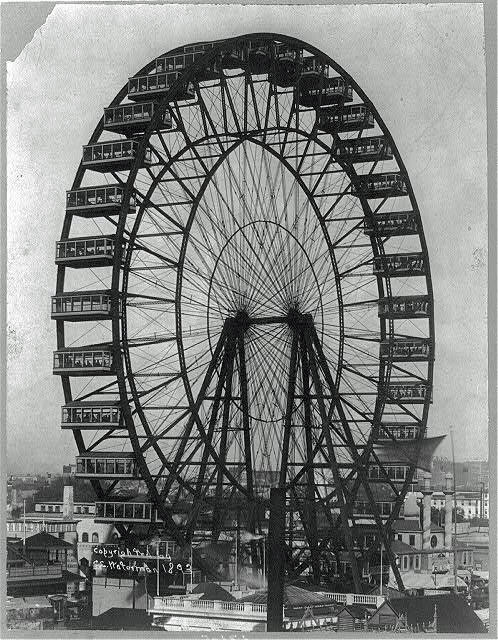
By August of 1893 it was estimated that over 200 people from Mt. Vernon had visited the Chicago World's Fair by train. Matilda Alexander wrote home a column each day, published in the newspaper of the sights witnessed.
How Western Star Described New City Hall Opening in Summer of 1893
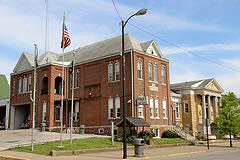
"Not Very Pretty," was the headline. The City Council had just had their final meeting in the Weckesser Block and soon would move into their own building on the east corner of Sixth and Main Streets. The finishing touches were being made for a Monday moving and a Tuesday open for business. The Western Star newspaper said, "hope the showing up of good advantage inside will be more so than it does outwardly." The Mayor's office was to be located on the second floor, facing Main Street. It has burglar proof vaults for use in keeping the records and valuables for the city. The interior is very pretty. Pine ceilings with natural finish greet the eye and three-foot wainscoting adorn the walls. The structure will cost about $7500 and is judged to be a bargain. Although the new hall is "odd looking," in outward appearance, on "account of the small windows, from which considerable fun has been elicited, it gives us satisfaction at least to those who have to use it." The building was equipped with two large wash rooms and necessary conveniences. The light was to be incandescent electric lamps. In the rear of the second floor is a room, probably the largest in the building, which has been set apart for the fireman to use for meetings and to drill in. Newspaper said also that "it is large enough for the brave laddies to hold their annual dances in," in reference to their Fireman's Balls. The Mayor's Office and Fireman's room are connected by large folding doors, which when thrown open will make it the largest room in the city. On the north side of the building is a large arched door, through which the fire apparatus will be taken to and from the building. The tower, would house the fire bell. 122 years in service and its days are now numbered.
Celebration at River's Edge before there was a Sherburne Park....June 1893
At about the time the huge gravestone of Governor Alvin P. Hovey was being transferred from the train station to the cemetery we had a patriotic celebration at the wharf. Workers freed the great stone that weight pushed its special wagon down to its hubs in time to head to the river. The Walter Yarona and his Marine Exhibition was in town and gave two exhibitions in the afternoon and at night on June 12th. The band played a concert at night followed by a free grand fireworks.
Railroad Argument Leads to Fight - Fortunately, they are Separated.....January 1893
Gus Laugel, engineer of the Evansville and Terre Haute railroad and his fireman Al Culley engaged in quite a quarrel when they arrived in Mt. Vernon at the depot. Al took out after Gus with a pickaxe, while Gus pulled his revolver and snapped it twice, but it failed to fire. Separated they were summoned to appear before Evansville officials but the end result was nothing much, told to behave neither lost their jobs despite ill feelings for over a year.
Brain Surgery at the Infirmary.....1893
Doctor D.C. Ramsey performed an operation called trephining, drilling a burr hole into the head of Robert Caldwell at the County Infirmary. The patient was suffering from epilepsy, by way of a blow from a brick bat received in July of 1892. The negro man's operation was performed at the request of the County Commissioners. Caldwell had been subject to fits and severe headaches ever since being hurt. I imagine his head didn't feel so good after this either, just saying. The doc removed a piece of skull one inch by two inches in size, known in medical terms as an "elevated and depressed bone." He then "dissected the brain, loosened the membranes from scar and skull and removed the old scar." Ahhh, I don't know about all this I tell ya! On recovering from chloroform ole Mr. Robert asked for food, and was "free" of pain! No fever, no nothing! That night he slept five hours and the prospects said he was good for recovery. The operation took one hour and ten minutes. Dr. Ramsey was assisted by Dr.'s R.S. and H.T. Dixon, Dr. H.H. Sugg, and Mr. Alvin Hovey, medical student.
Emancipation Day.....1893
The miniority community had a glorious time at the barbecue at the fairgrounds that April celebrating Emancipation Day. Some of the best barbecued meats around were served. A baseball match had the "colored" Mt. Vernon Blues defeating the Uniontown Reds by the score of 18-14.
Editor Warns Mothers of Young Women about "Libertines".....1893
"Mothers, are you not aware that there are breakers ahead of that precious daughter of yours, who is so unhesitatingly promenading the streets with, you know not whom? That was a warning, editor Leffel gave in the Western Star newspaper. He warned parents not to be indifferent to their future and to be extremely cautious of men well dressed, but unfit for any respecting girl. Many he said were gamblers, slick scoundrels, coming from the dens of the taverns and taking advantage of moral immaturity of the young women. If nothing goes wrong, it still "gives the slanderous tongues of gossip an opportunity to tear down and pick to shreds the characters of girls who, though innocent of all crime, must suffer the consequences of their folly."
Giant Skeleton Found in Griffin - 13 Feet Tall.....June 1892
The Grayville, Illinois Mercury said that a J. McClure and John Harris dug into a mound on the Heady farm a couple of miles north of Griffin, and unearthed a human skeleton of remarkable size. The bone from hip to knee measured 3 1/2 feet, and from knee to ankle of 3 feet. The backbone and ribs crumbled as soon as exposed to the air, but enough of the skull was saved to show that it was at least 12 inches through. The lower jaw would easily slip over one's head, and the teeth were in sections, three to nine in a group. The skeleton was in a sitting position and was said to be a man fully 12 to 13 feet in height.
Death Inquest.....January 1892
Frank Taylor who lived in a old boat just west of the Mt. Vernon fairgrounds on the Ohio River was found frozen to death. He was a widower, had a hard life and the coroner ruled.....he got cold.
New Years Celebration Burns Down Livery Stable.....1892
A livery barn on Store Street (College Avenue today), between Water and Second streets was totally consumed by fire from fire crackers and Roman candles. Marshal Maier and Pres Loveland were first upon the scene and released the horses, about 25 and also pulled out a few buggies.
The Alvin Peterson Hovey Monument Described.....1892
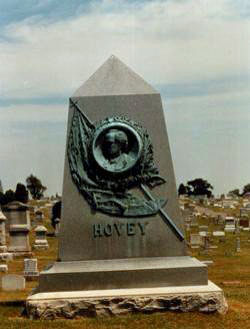
The late lawyer, General, diplomat and governor died and was buried at Bellefontaine cemetery north of Mt. Vernon. The foundation of the monument was set for over a year to settle sufficiently to withstand the immense weight of the monument which contained nearly 10,000 brick some four feet into the ground. The first base is marble, twenty inches high and weighs 15 tons. The second base is sixteen inches high and weighs four tons. The die stands on top of the second base and is of dark granite, highly polished. It stands ten feet four inches high and weighs seventeen tons. The total weight of the monument is forty four tons or 88,000 pounds and the total height is thirteen feet and four inches. On the western surface of the monument, near the top is a large bronze medallion bust in base relief of Governor Hovey looking north. The model for this bust cost $500. Underneath this is the inscription, "Alvin P. Hovey, Twenty-Fourth Indiana Volunteer Infantry." Near the base of the monument is the name "Hovey," in large bronze letters. The total cost of the monument is $6000. John Walsh, of Montgomery, Indiana was the designer and builder of the monument, and was assisted with finishing touches by Ira Nye, of C.P. Hiskey's marble works. A strike prevented the monuments delivery until after Decoration Day. The expense of the monument was borne entirely by Mrs. Menzies, a daughter, and the wife of Maj. G.V. Menzies, and C.J. Hovey, a son of General Hovey.
Civil War Counterfeit Mould Given to Mt. Vernon Man....May 1890
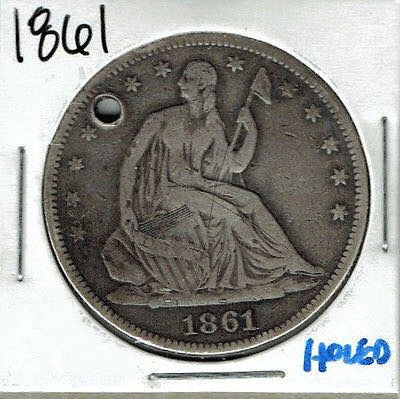
On a recent trip up the Tennessee River, boat captain George Throop was presented with a mould. The shaped cavity was said to have been used by a Negro during the war in making counterfeit half dollars which he would trade with the Union soldiers for greenbacks. In 1867 this item was found in the possession of a negro employed at the Cumberland iron works in Tennessee. It went on display in Mt. Vernon at the County Clerk's office.
Our Library's Namesake Opposed Women's Suffrage.....1890
Matilda Greathouse Alexander, Mt. Vernon's women's advocate for female education, the homeless, for prohibition, a poet, and author opposed women's suffrage at the end of the 19th century. She said, "women should not walk in men's shoes, nor participate in the political process." The journalist for an Indianapolis newspaper, and contributor to many of our papers surprised me with this statement. Born in 1842, to George and Martha Greathouse she was the youngest of four children. George died within a year of Matilda's birth and her mother remarried having two more daughters. Absalom Rodenberger was her step-father and he opposed educating the children in the school, thus their mother taught them at home. Alexander did go to the Catholic Academy of St. Vincent in Kentucky then returned home to teach at a country school. She only got to do that for a year when the Civil War broke out and she went back to the farm to help during the absence of her brother Frank, who had enlisted in the army. Afterwards Matilda married, but was a widow at age 24. Their only daughter Rosemonde attended a female college in Florida and a private school in New York. During this time Matilda became a journalist and a constant contributor to Mt. Vernon newspapers from 1878 to 1893. Some of the papers on microfilm show her notes in the margins. Her poems were always present and obituary poems too. She covered the Chicago World's Fair in print for the Indianapolis Times. She was a prolific author, but many of her poems and novels were never collected or saved. Two surviving novels include, "Going West" and "Homes for the Homeless." She supposed to have written a five act play on the life and assassination of Abraham Lincoln entitled, "From the Hovel to the Hall." No record can be found of it, but in a short biography of 1882 it was mentioned as one of her works. She formed a literary society in Mt. Vernon in her home, gave books to form the first temporary library in the City Hall, and when the Carnegie donation came in after her death the new library was called, "The Alexandrian Free Public Library." In her will she donated money and land for the library to sustain her great gift.
1880's
Late Spring Indeed.....May, 1889
In May of 1889 we had a very cold spring and it was the last of May when farmers planted their corn in overcoats to keep warm. On the 25th of the month, a very destructive hail and wind storm blew into the county. As much as 12 inches of hail fell and the next day at least 6 inches of hail still remained on the ground.
Hovey's Parade into the State House.....January 23, 1889
Mt. Vernon's own Alvin P. Hovey was moved into the governorship of Indiana. The Weekly Sun said: "Although the locals didn't vote for him our favorite son has traveled from log cabin to the governor's mansion. Celebrations reached a climax at Tomlinson Hall, Indianapolis, where couples twirled in mystic mazes of dance." It was described as a grand affair...never seen outside of Washington city. "What could keep the heart of a Posey County citizen from swelling with pride and joy as he is remembered that all that pomp and glory was done in honor to a once poor lad who grew into manhood in our beloved Posey County?"
Poor Infirmary
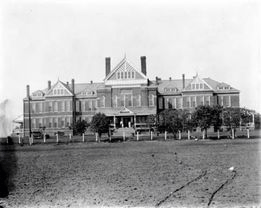
The poor infirmary was built on 30 acres of land purchased from Milton Black with construction beginning in 1889 or 1890.
Now You Know...1888
December 27, 1888 The Harrow Post GAR received 94 grave markers with names of the fallen Civil War veterans of this area. They were to be placed at the German and Leonard Cemeteries. (Now Bellefontaine and North) None of these markers remain at North Cemetery. Many rows of soldier's stones are out at Bellefontaine. It has been reported that many soldiers were reinterred there. Unknown whether this was done symbolically or literally.
Heat Wave Weather.....1887
During a prolonged heat wave of July, Mt. Vernon temperatures reached 104 degrees two straight days on July 22nd and 23rd, 1887.
Despite Violence, Mt. Vernon Sleeps Unprotected On Hot Sultry Night.....July 1886
Despite a decade of unprecedented violence, a local reporter made his rounds in quest of news and noticed many families were in the habit of sleeping with their doors and windows wide open. It was particularly noticeable among the "medium" class of people. They seemed to fear no danger, despite lynchings, and hangings and murders in our city in past years. "Their whole thoughts seem to be for comfort." On one street every house was thrown wide open, the occupants sleeping as sweetly as though they were guarded of all danger.
Firecrackers Cause Injuries, Chaos, and Corporal Punishment.....December 1885
Little Mollie Henrich was gathering kindling in the woodshed when her younger brother couldn't resist throwing a firecracker under her skirt. By the time Mollie returned to the kitchen of their home her clothing was ablaze and she ran out of the house into her father's barber shop on Main Street and he rolled her on the floor and beat out the flames with his bare hands suffering burns on both hands. Mollie received several bad burns also and then little Arthur in time received a sore bottom.
Mt. Vernon's 11th Mayor
Sylvanus Milner died on April 4, 1885 after a long and painful illness, age 51. He had just been elected mayor in 1884. He was born in 1833 and came to Mt. Vernon with his parents as a small child working in a grocery as a young boy. In October of 1863 he joined Company A of the 10th Cavalry as a Captain. In this group were 97 men, all but 13 from Posey County. Twenty-one were killed and five deserted. In Mt. Vernon he was also a former postmaster. He never married and willed his entire estate to his cousin, Miss Ola Bowman.
Town Visited Again by "Fiery Monster"... January 19, 1885
It was a Saturday morning, 4 a.m. and the warehouse in the rear of the Wm Geles confectionary on Main Street was discovered on fire by the watchman of the Pfeffer and Trendt's mill who gave the alarm. The wind was blowing a gale that morning. The new fire department responded and was helped that the roofs of the buildings were covered with snow, preventing many from igniting as a shower of sparks flew in all directions for a distance of two to three city blocks. Among the buildings destroyed was that of A.J. Clark, the jeweler, who with his wife occupied the second floor as a residence. They were awakened saving only their lives and nothing more, losing everything except what had been stored in a iron safe. Geles confectionary was a total loss and they barely escaped with their lives. Ike Wolf's meat shop was next with loss of close to a thousand dollars with no insurance. The millinery establishment of Miss Emma Tischendorf was completely destroyed and the agent for Singer Sewing Machine Company occupying part of the building lost 22 machines. The Jones family had room above the confectionary and they lost everything including a fine piano and "one of the best art galleries in the state." Mrs. Jones was overcome by the dense smoke and had to be dragged out. The Maloney family, an agent for the railroad was awakened in time to save a trunk filled with old clothes, but lost everything else. The room occupied by the Telegraph Company and the insurance agent lost all office furniture, but books and papers left in a safe survived. Leonard's Row, in the rear of the jewelry store, used as offices also fell victim. It was completely gutted. Cronbach and Wolf owned the remaining buildings and were insured partially. Others having damages was the St. Nicholas Hotel owned by Nick Joest. Many others owned by a dozen or so people were damaged more or less, by the removal of goods into the street with some breakage. The fire is supposed to have been the work of an incendiary. Postmaster Brown and Henry Schiela were overcome by smoke at the jewelry store and were dragged out of the building by George Curtis. Many of the members of the fire department, owing to the extreme cold had their ears and fingers frozen before they were even aware of the fact. Lon Hendricks and Henry Baldwin, managers of the department were credited for limiting the fire. Some claimed that a fire wall in the building occupied by Ike Kahn saved the block from destruction. All of the plate glass of the St. Nicholas Hotel, opposite the burning buildings were cracked by the heat. Afterwards, Ike Kahn threw open the doors of his place to the boys and whiskey flowed as free as water for "Vernon's Pride."
Local Arsonist Sought.....July, 1884
In July of 1884, local police searched for an arsonist who filled a gunny sack with pine sticks, saturated it on fire, then threw it into the attic of Richard Sarll's boot and shoe store. The daughter of C.R. Martin, who had a room across the hallway from the store's second floor, was awakened around one in the morning by the light of the flames shining then alarmed authorities who responded quickly putting out the blaze.
"Ooohhhh, You Put A Spell On Me....Sold My Soul".....1884
In mid-summer of 1884, strange cases were finding their way to our judicial courts. A man was arrested in Mt. Vernon for practicing witchcraft. A woman accused him of "hoo-dooing" her at a local establishment. Witnesses testified that he put a charm on her and wanted $4 to release her. The lady was known to be very superstitious and she had great fear. The law stepped in and took the man to jail. I was unable to find the result of the case as to whether the case was dropped or the "hoo-dooer" was a warlock or a charlatan. Of course, if he was convicted, I would be afraid he would turn me into a toad.
Hot August Tempers Explode Into Courtroom from Unlikely Sources....1884
The brawl on a Saturday was not amongst the town's worst but of the city's most respected merchants who had a dispute about of all things ... a hay rake. One of them received a good beating in the incident and therefore went before the court and filed a complaint against the other shopkeeper for assault and battery. This led to a counter complaint against the plaintiff who was accused of provoking the fight for saying &#%@*%#!(%$#....or "bad words". The judge already was in a bad mood facing election for an opponent he said, "belonged to that dirty party." It was decided that each man would be fined $1 and costs and dismissed both charges, stating he didn't have time for this nonsense and did not consider "the invitation to the neither world of sufficient provocation...be gone...behave." In other fight/court news a certain young man came running down Water Street at breakneck speed, sliding around the corner onto Main. When stopped and questioned, he replied, "there is a fight up above, you know where, and I don't want to be a witness." The "up above" was a bordello.
Mt. Vernon Democrat Still Had that Edge.....1884
The Presidential election of 1884 had that "Man from Maine" James Blaine of the Republicans and Grover Cleveland for the Democrats. Cleveland's Vice President Thomas Hendricks more than a decade before spoke in Mt. Vernon. He had been Governor of Indiana. The main issue was tariffs. the Republicans liked the big ones and the Dems the little ones. Remember there was no IRS in those days, and taxes came mostly on foreign imports and on alcohol. Blaine was sort of a shady character, his family lived well, but he never really disclosed the source of his income. Historians just say, "he lived on the ethical edge." Truth be told he probably was no better or worse than his contemporaries. Blaine had a group of followers known as "Half Breeds" because of their willingness to endorse protective tariffs and their belief in federal assistance for education for both blacks and whites in the South. Because of Blaine's finances some in the party threatened to bolt the party if he was selected. These vocal proponents of small government became known as "Mugwumps" an Indian word meaning big chief. They made a lot of noise saying that Blaine "wallowed in the spoils like a rhinoceros in the African pool." The Mt. Vernon Democrat found it amusing. They laughed at them and said, "we will not lose our well-earned reputation as an earnest and fearless advocate of pure Democracy! There is no need for alarm. One thing is certain, our Democracy and self-respect will never permit us to endorse or countenance rank mugwumpery and open and shameless bossism.". Posey County voted for Cleveland over Blaine 2773-2157. Mt. Vernon voters were even more Democratic than the other areas of the county. The election swept Cleveland into the White House by an electoral margin of 219-182 thus closing the "Gilded Age."
Relief Steamer Halpin with Governor Porter (R) Arrives in Mt. Vernon.....March 1883
Albert Porter dressed in overalls and a straw hat and with a boatload of state notables made a brief stop in Mt. Vernon looking over what was then the worse flood in recorded Indiana history. He continued down river distributing the remainder of aid for flood sufferers. He made the observation that Mt. Vernon was "high and dry." I wonder if that is where our motto came from? He was a weak governor, but a good man. The Democrats had thrown him virtually out of their party by 1856 because he was anti-slavery and after he got in the governor's mansion they blocked him at every turn. He was pro women's suffrage and pro-labor. He worked hard for improved working conditions for miners, orphans and hospitals. He gave a speech at the 1888 Republican Convention and nominated his old law partner Benjamin Harrison as President. In tribute, Harrison made him Minister to Italy in 1889.
"A babe in the home is a well spring of pleasure....a link between angels and men."......Local classmates celebrate.....1883
A silver cup, handsomely engraved was presented to Eunice Devo by her classmates for having the first-born child from their graduating class of Mt. Vernon High School of 1878. There were 18 graduates that year.
Snow Brings Out the Kids.....December 21, 1882
Four more inches of fresh snow on top of what we already had brought sleighs out into the streets. The little sleds going down the hills and the big sled pulled by horses. Small children were out throwing snowballs at each other and delivery men on Main Street. "It looks...it feels....it smells like Christmas....May every Mount Vernonite have a merry one.".....Western Star newspaper.
Unbelievable Hot Wedding Night.....October 1882
A devastating fire consumed the barn and harvest of John Junker of Marrs Township. The incident followed a wedding spree on the premise and it was surmised that sparks from the young men smoking incinerated the hay, wheat and structure. "For better or worse...."
Another Fight ....Photographer and One Handed Man Ward Off Kentuckians....July 1882
It was a hot steaming day and sweltering night when all crap broke loose. First there was a man arrested aboard the steamer, "Silver Cloud" when a man fractured another's skull with a club, then at Ike Kahn's saloon two Kentuckians came for trouble. While one of them was sampling the spirits inside, the other one had his fun abusing a "crippled" fellow outside the doors of the drinking emporium. Photographer Jones, the same Jones that took photos of the lynching at the court house, just happened to be coming by and saw the mistreatment and stopped it with a well-placed fist to the ruffian's eye who quickly ran into the bar. Must have been a tag team because out comes the other fella and he jumped on the nearest bystander which happened to be the "cripple." He seems to have had enough abuse and although having only one good hand, soon finished off the Henderson man and they were delivered to Marshal Paul and lodged in the pokey.
Nine Pages of Murders in William P. Leonard's History of Posey County.....1882
One of the earlier Posey County historians, Wm. Leonard captured the murders in Posey County from the earliest to the latest in his book printed in 1882. Many of the murderers never were caught. One of these was Jonathan Combs who on June 4, 1850 during the construction of the Old Plank Road between New Harmony and Mt. Vernon stabbed and murdered Noal Nesler. Combs made his escape and was never brought to trial.
Slippery Crooked Broker Swindles MV Capitalist, Arrested in Nashville.....1882
Ike Kahn, of Mt, Vernon arrived in Nashville to meet with the arrested swindler Geo. Perry and a compromise was agreed on. Perry returned about $200 to Kahn. It was discovered that Perry had a large amount of money sewed in the lining of his clothes. The arresting officer and Justice Galdwell said he would hold Perry no longer and withdrew the warrant when he returned the money and paid all costs. Perry had obtained the money from Kahn representing himself as having a fine bunch of hogs that he would sell cheap. Perry had made purchases for Kahn before, and Kahn not doubting him, handed him the necessary sum for purchase. The next day however, Kahn met the man with whom Perry was to trade, and asking him about his hogs, was astonished to learn that he had no hogs for him. This opened Kahn's eyes that he had been had and he sat out to look Perry up. He was traced to Evansville and then to Nashville where he was detained.
Christmas.....1881
New tall buildings were starting to grow along Main Street with the boom of new business and residential dwellings growing for several years. Big merchant stores were still rather sparse. We had plenty of groceries, blacksmiths, coopers, barbers, tailors and shoemakers...but there would come a need for more manufactured goods. Remember clothes were usually made at home from sewing machines. There was a store ran by Charles Quick who sold those. Furniture was bought at Charles Schiela's who must have been pretty wealthy. His crypt looks pretty nice at the cemetery. Lots of people made their gifts like in the old country with their own hands. Dolls were made of heavy cloth and stuffed with saw dust. Christmas trees were cut from the woods and decorated with popcorn strings and candles. Toys were made of wood or iron. A corn cob pipe or a pocket knife were good gifts. Stockings were nuts, and fruits. If you got a top or a doll you were pretty happy. Children worked hard too in those days. A pair of skates, a piece of fishing gear were cherished, especially by the rural and working classes.
New Harmony Fairgrounds Burn.....January 1881
Around three in the morning on January 10, fire was discovered on the fairgrounds and it was found that the large amphitheater was on fire and in a short time it was entirely consumed. There was no insurance. The amphitheater was 310 feet long and 24 feet wide and capable of holding between three and four thousand people and was built of a cost of $2000. It was thought the fire was started by an incendiary. Profits had been exhausted from the treasury prior to the fire and it was some time before an adequate replacement was built. A $50 reward was offered for the arrest and conviction of the arsonist.
"General Welfare Clause" of Mt. Vernon Enacted.....1881
After the "Great Fire of 1880" destroyed a good portion of Main Street, the city got busy making changes. To get insurance for the new building boom, Mt. Vernon had to have a fire department of which they organized. Later came an ordinance which prevented the erection of wooden structures within the city limits as maybe determined by the city, The city could compel the removal of wooden buildings erected if they were in violation of said ordinance an present building could be destroyed if the building was seen to be a nuisance to fire. Those "valuable" buildings had the right to repair them to bring them to code if the cost was more than $300.
One Issue Voter's Pledge of Princeton, Indiana.....1880
Today we have them, those candidates who are compelled to sign a pledge for issues opposing abortion, for gun control, against taxes, etc. Voters are urged too by groups and PACs to pledge loyalty to a cause. In the Princeton Democrat of the winter of 1880, 42 registered voters sent in a letter to the newspaper: "We the undersigned, believing that the future happiness of this great country depends upon its sobriety, and being opposed to the stuff that causes drunkenness, and in favor the entire prohibition of the sale and manufacturing of intoxicating beverages; we will work and vote as near as in our power, only for candidates with undoubted temperance principles who will act, as well as talk for the prohibition of the manufacture and sales of intoxicating beverages. We further agree to use our influence to push forward the sentiment of prohibition, regardless of past convictions or prejudices, and try to make Prohibition the leading question of the day."
1870's
Poor Marksmanship Critiqued by Western Star Newspaper.....1879
Geo. Daniels and James Lay had been quarreling in Ike Kahn's saloon around 5 P.M., resulting in one punch being thrown. Around 7 P.M. they met in front of Pap" Burtis store on Main and Lay fired at Daniels in the middle of the street with his Smith and Wesson pistol. Lay missed him totally and the Star said: "Lay is a bad shot and should be fined for not knowing how to use a firearm better. Geo. escaped without a scratch to drink and fight another day."
Coroner's Inquest of Cyrus O. Thomas....Killed October 1878 Prior to Lynching
"Be it known, that on this day an inquest was held by the undersigned, (William Hendricks), Coroner of Posey Count, at the residence of George Washington Thomas, in the city of Mt. Vernon, Black Township, Posey County, Indiana, upon the dead body of Cyrus O. Thomas. The deceased was about 39 years old, dark complexion, black hair, and mustache, spare build, about five feet seven inches high; was dressed in a striped cassimere coat, black cassimere pants, white cotton shirt, knit undershirt, white cotton socks, calf skin shoes and black hat. Had on his person two dollars and ten cents in silver, one memorandum book and a bunch of keys. Verdict of the jury: Came to his death by a shot from a gun in the hands of Daniel Harrison, while attempting to make an arrest at the house of the said Harrison.'
Coroner's Inquest of James Good - Lynched at Court house....October 1878
"On the 12th day of October, 1878, an Inquest was held in the city of Mt.Vernon, Black Township, Posey County, Indiana, by the undersigned coroner (William Hendricks) of said county, upon the dead body of James Good, found dead upon the Public Square of said city. The deceased at the time of his death was about 30 years old, about 5 feet 10 inches high, slim build, black complexion, black kinky hair, and black mustache. Was dressed in light colored cassimere coat, striped cotton shirt, cotton undershirt, black tweed pants, white cotton drawers, white cotton socks, and brogan shoes. Had on his person one pocket book, two nickels, one pipe, and one white cotton handkerchief. Verdict of the jury: Came to his death by hanging, at the hands of person to the jury unknown."
Coroner's Inquest of William Chambers - Lynched at the Court House....1878
On the 12th day of October 1878, an inquest was held in the city of Mt. Vernon, Black Township, Posey County, Indiana, by the undersigned (Wm. Hendricks), Coroner of said county, upon the dead body of William Chambers, found dead upon the Public Square of said city. The deceased at the time of his death was about 35 years old, about 6 feet high, heavy build, black complexion, black kinky hair, black mustache, black cassinet coat, light colored cotton undershirt, gray jeans pants, with cotton socks, white cotton drawers and brogan shoes. Had on his person one counterfeit Mexican dollar, and twenty-five cents in silver. Verdict of the jury: Came to his death by hanging at the hand of persons unknown."
Hung Men Used for Target Practice.....October 1878
I have written of the events of 1878 many times in my seven books and it was the backdrop for Judge James Redwine's novel, "Judge Lynch." Redwine spoke with lawyer Doug McFadden in 2008, a former candidate for congress of the 8th District in 1968. In 2010, Redwine wrote about their conversation in the Mt. Vernon Democrat in his column "Gavel Gamut." Doug and Don McFadden are brothers and their grandfather was Ben McFadden, (1869-1949), the son of Philocles Polk McFadden who was born in 1844. Doug had relayed part of the story to the Posey County Historical Society when the topic came up this past year when historian and cartoonist Glenn Curtis spoke to us of his life. Doug had written a book on the McFaddens: "A Family of Frontiersmen 1250-1950" and described the atmosphere in this part of the state in its white man origin from McFaddin's Bluff into the Civil War period. Our history was filled of loyalists to the Union along with Copperheads, White Caps, Sons of Liberty and Knights of the Golden Circle. Abolitionists worked underground in our strong Democratic community. In Doug's book, shared by Redwine in his article, page 101 Ben McFadden told Doug and Don that at nine years old Ben was taken by his father Polk to the courthouse square, just two years since construction, on October 13, 1878 to view the bodies of the four African American men still hanging from locust trees. Ben remembered seeing the victims of the mob hanging used for target practice with shotguns! Ben told them he could recall an innocent bystander having his eye shot out by an errant shell. "This account is corroborated by the newspaper editor, John Leffel who was an eyewitness to the lynching," Redwine wrote. The front page of the Western Star of October 17, 1878 reported: "The only accidents that occurred was the shooting of Alex Crunk, Sheriff elect, who was shot in the eye, and from the effects of which will lose that member. John Cruck was shot in the head and neck, the wounds, although painful, are not considered dangerous. Ab. Cruck and John Patterson also received slight scalp wounds. These gentlemen were all standing together on the south side of the square, and the supposition is that one shot wounded all."
Horrible Fate of Former Posey County Family in Nez Perce War.....1877

A few years before the Posey County family of James Chamberlain left Posey County and followed the Oregon Trail settling in the Willemette Valley in Oregon. In the spring of 1877, Chief Joseph was urged to move off his property of which he refused. The Indians had a treaty going back to 1855 allowing them to fish and hunt on their ancestral lands in the pacific northwest. The United States broke that treaty and war started in June into October. Local relatives received word that James Chamberlain was shot dead and his body badly mutilated and his five year old son, Jonathan was also killed. The wife was shot and left for dead, and the tongue of her infant child was cut out. The mother and child recovered. Joseph was tracked up into Montana and survived tremendous hardship trying to get to Canada. He finally gave up and the tribe was sent to a reservation in Idaho. This was after a massacre from the soldiers at the Battle of Big Hole of mostly unarmed women and children. Chief Joseph later made a speech called, "I will never fight again, forever."
Editor note: Emily Allyn has added the following information James Chamberlain (1825-1892) married Mary Ann Nesler (1829-1848) in Posey County on 20 JOuly 1846. They had one son, Jonathan (1847-1877). James remarried to Angelitha Jones after the death of Mary Ann. James and Angelitha had about eight more children. Sometime in the 1860's, this family headed west to Oregon, then back east towards Idaho. On 15 Sep 1872, Jonathan married Emma McLaughlin, in Oregon. On 14 Jun 1877, Jonathan was killed by the Nez Perce. His three year old daughter, Hattie, was also killed. Their infant daughter, Effie Dora, sustained a stab wound to her throat and mouth that permanently damaged (but did not completely cut out) her tongue. Emma and Effie Dora survived the attack, though. In 1880, in Washington State, Emma remarried to James Lonzo Tow and had six more children. Effie Dora first (in 1896) married Charles P. Smith. He died, and she remarried to Max C. Poindexter (allegedly related to Senator Miles Poindexter) in 1908. I think she had four children with each husband. Some of her children by her first marriage later used the Poindexter surname. Max C. Poindexter was found shot to death in a Chicago hotel room in 1920, and there was debate about whether it was suicide or homicide. Several members of this family ended up in Nevada but others went to South Haven, MI, which is where Max and Effie are buried.
And now the weather.....1876
In January of 1876 the weather turned cold and clear. Temperatures that month were in the twenties much of the month and river traffic slowed. The river was also falling and as temps raised above freezing, mud was left behind on the landing and any approach to the river was hazardous.
"A few very fine French Harps at James Foster's Store, 45 Main Street".....1876
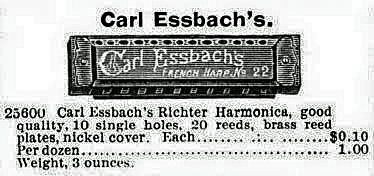
1876 was the first time the word French Harp was used in advertising for a harmonica they say. Anyway, I found a link in a local newspaper for them. A poem by Emily Thorton Charles in 1876 had the line in her poem "Christmas Dreams:" "And sturdy Nat to his dear mother flew, just see my book and a nice new hat. And mittens, and boats, and a French harp too!" Just put the reeds to your lips and blow, enjoy they swells and dying cadences. Be a folksinger.
Watching Pigs - A Lazy Day.....December 1875
Our material wealth was captured in a ledger in 1877 and I guess I can work it into this little ditty of a story. Auditor Owen completed statistics that year and found we had 23,849 hogs in the county but only 84 pianos. Anyway, back to the pig story. A few locals went hunting one winter, amongst the panorama of nature, even in its naked glory. In a piece of woods not far from Mt. Vernon, the hunters, (they called it sportsmen, yeah right), had little luck and became tired of walking, depressed so they seated themselves upon a fallen tree for a rest. One man directed their attention of a sight transpiring not far away. What they saw was both strange and comical, a dance of pigs! Pigs were still in a position when with a shrill squeal from one pig, this gentleman pig took on an elegant graceful demeanor. His dance was all the riot as the men watched. The pig strived to jump higher and squeal louder, than any of his companions. There were fifteen small pigs, not much bigger than a house cat. Nearby stood the mother, watching with interest and a critical eye. The men were quiet as the little pigs played. A ratty looking little fellow, with a pair of spotted legs, waltzed into the center of the ring they formed, stood for a moment in meditation, then advanced dancing in a "French style," politely offering his nose to no doubt, in his estimation, the best looking female in the assembly. The beauty gave her rump a little twist and placed her nose close to her partner's, and the couple whirled through a dance for a few minutes and then paused. Instantly, the whole ring, rose quickly upon their hind legs, and dropped back again. Then, placing their forefeet together, they whirled around twice, and upon ceasing, formed in a line and moved around in a circle, hopping and skipping like an old country gentleman dancing with a young beautiful woman in a barn dance. How much longer the dance would have lasted, will forever be left in oblivion as the mom moved. Instantly, the dancing ceased and the pigs scampered off through the woods. The men that evening laughed over the strange freak show they had witnessed as they ate their fried coon and cornbread. None had ever seen such a sight and one supposition put forward was that the happy family had witnessed some gentleman giving dancing lessons in the country and they learned the dance thereupon......nah...hey, Fred....pour me some more whiskey in my cup, will ya?
Christmas.....1875
On Christmas Eve storms arrived around midnight and wind was howling as dense clouds gathered. It was growing colder, but still unseasonably warm and it would stay that way into early January. It was for the most part I guess as happy a Christmas as most are....our own mirth and joy reflected in the happiness of others we love. A holiday for the children and adults as pleasure watching them engage in opening presents. We paused too for charity remembering others here and abroad...on the other side of the earth who need things that we might even cast away. People gathered on Main Street that Friday Christmas eve in front of the just completed new court house. What a scene that must have been! Churches held suppers that night, gathered, sang carols, and passed out presents to children. Stockings were hung full of nuts, fruits and candy. It was a day for the faithful, set apart to commemorate the birth of their redeemer and deliverer. Jews and Gentiles alike in town celebrated the holiday according to their faiths. Others...."stupid urchins" in town celebrated too much, "polluted by gross indulgence" profaned the holiday. There were two or three large fights resulting in bloody noses, black eyes, and bruised faces. A few men took to pistols, thinking it their duty to discharge them in close proximity to people's legs "making them dance" to their devilish entertainment. But overall, most followed the traditions and as always hoped for "Peace on Earth, Goodwill Towards Men."
"Down with the Old...Up with the New!".....November 1875
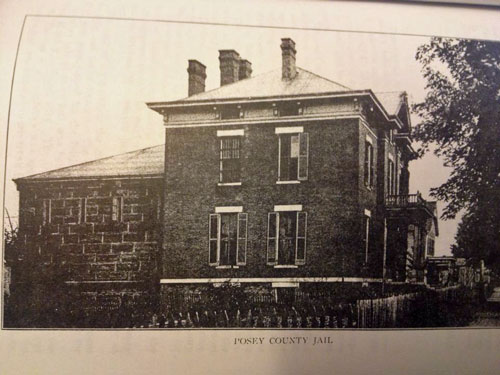
"And now we have a new court house, what about the old jail? Some prisoners recently cut their way out of it and made their escape, others may do likewise. When will it be condemned? Where will the new jail be built? And shall we have a residence for the sheriff? We shall see.".....Mt. Vernon Democrat. As fate would have it the new jail on Mill Street did not happen until after the mob lynching of 1878.
Evansville Poet, Newspaperman, Philosopher Dies of Morphine Drug.....1875
Tom McAvoy at first glance had everything going for him. Born in Liverpool England around 1830, he had a great education and as a resident of Evansville he at one time held many jobs of great respect. He was county assessor and was gifted with the pen. He possessed a fine analytical mind and his style was one of politeness. He was editor of the Evansville Enquirer for many years and did good work. After a time in politics he developed a strong appetite for alcohol and for years he fell farther and farther into decline. It became so bad that the man who once wrote of the inconsistencies of the human disposition fell victim to his own philosophies. His wife left him and soon his travel to ruin had nothing to restrain him. All self-respect was dead and all his fine attributes were wasted. People avoided him and he gathered little sympathy for his weak human nature. At the end, on a Saturday night he went to the Bridwell drug store looking for morphine. It was refused of him and he went off. Later in the evening, he returned and was intoxicated, as usual, and staggered to a seat in the store. Here after groaning awhile, he fell to the floor insensible. Taken to the station house it was discovered that he had taken a large portion of morphine. The physicians worked all night with the hope of restoring him, but without success, and he died at 4:45 A.M. The remains were sent to the shop of Robert Smith and coffined. He was interred that same day.
Main Street in 1870's
John C. Leffel, editor of the Western Star newspaper in their 50th anniversary edition said the following: "The business part of town had some brick stores two stories high, and also a good many frame ones set back from the street with steps running to the pavement. There were no street lights on Main Street or any other street, anyone going out at night carried a lantern. Still the town had merchants, namely Lowry & Nettleton, Mann & Sullivan, Thomas & John Hinch, C. Leonard, and Craig & McCallister. They not only sold dry goods and groceries in town but they shipped corn and pork south. The pavements were all brick on the principal streets. Plank walks and foot paths were seen all over the place. The streets were dirt." (In 1880 the great fire would come and new codes of brick buildings, fire walls, and a fire department would come into use. One building that survived the fire will soon go down...The old Wheaton's Pharmacy on the corner of Second and Main.)
Enforcing Morality In Oakland City.....1875
Earlier I wrote of the former Colonel William Cockrum of Oakland City and his vigilante justice enforcing moral conduct. The Baptist community (Oakland City College) is there, established rules of procedures where church members could face charges for indulging in dances, swearing, gambling, assault and public intoxication. Newspaper articles show that this family ruled with an iron fist almost in the late 19th century. Cockrum took to the Princeton Clarion again in 1875 and wrote of one offender: "he who has more voice than brains got to cutting a whiskey man's highland fling was arrested and tried for taking the name of God in vain." Fine and cost for two cases were $12 "and a ring placed in his nose to be pulled if he doesn't walk straight hereafter." No wonder my mom wouldn't allow any card playing in our home but Old Maid and Uno.
Vigilante Raid on Oakland City, Indiana Saloon.....1875
William Cockrum, a Civil War colonel with the support of his aging father, led a group of axe wielding Oakland City Baptist Church members on a legal saloon in Oakland City in February of 1875. In the Princeton Clarion of that time, Cockrum justified his violent action. He said they had tried by every means possible to get them to move the "dirty den" but they refused. He said, "what couldn't be got at by law was instead got at by axes." In a reprisal a firebomb destroyed his house and almost killed his family. He told the Clarion that I "was determined to make war with the whiskey ring, even if they burn me out every year." Thirty five years later Cockrum wrote the "History of the Underground Railroad" with the same moral anecdotes.
Historian and Novelist Edward Eggleston Makes Fun of Posey County.....1871
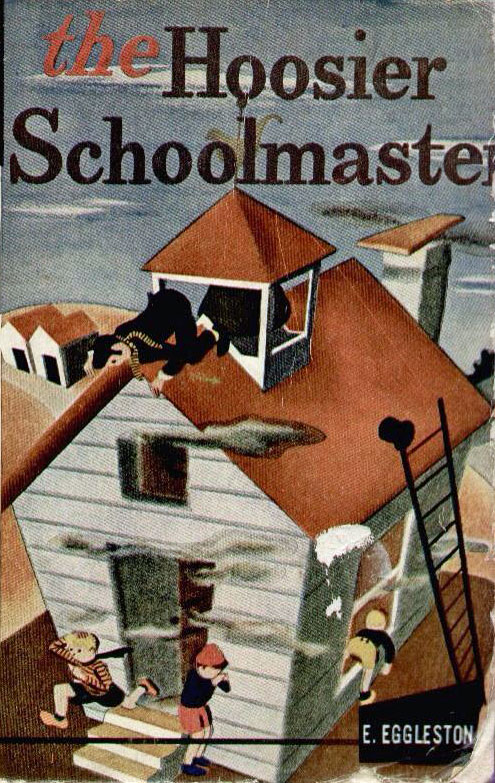
Eggleston wrote dozens of books and his first, "Hoosier Schoolmaster," published in 1871 made fun of our schools. Born in Vevay, Indiana in 1837 he is supposed to have taught school in Posey in Center Township. In his book he used the fictional name of Hoop Pole Township and called us the "epitome of educational retardation." He portrayed our schools of that time as rectangular "frame buildings, usually on stilts to accommodate the dogs and hogs of the neighborhood." He also said, it is in the southwest corner of Indiana, between the Ohio and the Wabash is Posey County. Nearly ten years since I taught a winter school in the center of Posey. I remember it used to be said just north of where I was taught, people run down their children with dogs once a month to put clean clothes on them and in the maps we used to draw lines of Posey County and divide it into "Civilized, Tribes, and X-plored." His depictions of us were not kindly and for a long time they stuck. There was a comic strip of Posey County and even at the Chicago World's Fair a caricature of a man in Posey.
Death Inquest Verdict Unusual.....Evansville 1870
The Evansville Daily Journal of January 1870 had an unusual story when Coroner Sauer was called upon to inquest a death. The paper says that a Sarah Boon, aged 65 was attending a prayer meeting and became excited and rose to her feet and said..."I have been a member of the church for nine years and I have served the Lord for that length of time. ", and added, "I am going home", whereupon she fell dead. Coroner said the sudden death was attributed to "the visitation of God."
1860's
America's Centennial Fourth Celebrated Locally.....1876
The morning of July 4, 1876 was bright and beautifully clear. Our day in Mt. Vernon started with the firing of cannon, the ringing of church bells, and the firing of Chinese fireworks. The night before the streets were filled with the republic's flag in windows, lamp posts, signs and rooms decorated with patriotism. The decorations at Chas Wasem's and Andrew Wasem's business were especially "tasty." Arches were swung across Main Street in wreathes of evergreens, flowers and bearing gold and silver letters. Our city had taken a holiday, donned its freshest dress and put its best foot forward in festive form. At Black's Grove people enjoyed the pleasures of the day, clothed in their newest garments, and came pouring in from every road, on foot, on horseback, in buggies, carts and wagons. A parade during the day was headed by the Mt. Vernon Brass Band, wagons carrying thirteen young misses representing the thirteen colonies, and a wagon containing 37 misses representing the thirty seven states. The crowd at Black's Grove was a hungry group, said to have been six or seven thousand in number. A program was strictly followed after the reading of the Declaration of Independence by William Owen. Mother Nature took a hand in the matter, and a furious, blinding rain came driving all the people away....wet, dirty, and still famished. That evening a make shift exercise began anew as General Hovey and Judge Edson spoke at the court house with balls at the Masonic and Bischoff's Halls. They said the Boston Dip was the dance of the day. Dinner was served of barbecued meats, three large beefs, 31 sheep, 15 hogs and all was eaten.
The Brick Wall Around Rappite Cemetery Story.....1869
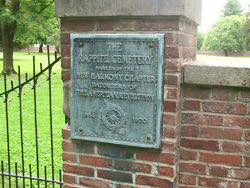
I came across an article published in the Evansville paper by Dr. Wm A. Fritsch during the state Centennial of 1916 on New Harmony. It was on the Rappite community, but it included something I was not aware of - the brick wall around the old cemetery. Fritsch says that he first laid eyes on New Harmony in 1869 and that the buildings reminded him of old Europe. He observed the neglected condition of the old Rappite church that was then being used as a packing house. He decided to write to the trustees of the Society at Economy and suggested they buy the building and donate it to the town. After several letters back and forth, a Mr. John Lenz, one of the trustees came to Evansville and then him and Fritsch visited New Harmony together. Here the old church was purchased and turned part of it into a public school. He bought the burial ground of the Rappities and with the remaining bricks from the church built a wall around the cemetery where hundreds of Harmonists are buried as well as Native Americans I am told. By the way, I have been told by one New Harmony resident that Easter egg hunts were held in the cemetery with no stones....confirmation?
Holiday Greetings ...1868
"From the hands of our enterprising merchants and now with almost breathless anxiety people wait with the coming of Santa Claus to distribute them tastefully arraigned under the tree. Can you forget the happiness experienced as years ago in the old homestead you rose early Christmas morning, to find a well filled stocking of toys and sweet meats? This year should be a happy one. Peace is in our country, great public improvements are being pushed forward. Providence blesses our city with health and bright prospects are before us. Then with thankful hearts let us welcome the holidays, let us enjoy them and while partaking of the bounties bestowed upon us by the giver of all good, let us not forget those who are less pleasantly situated. Then welcome to Merry Christmas; welcome to the holidays; welcome to 1869 and may we each renew our determination to be useful citizens, true to principle and strive manfully for the right. "....Editor Thomas Collins, Mt. Vernon Democrat
Manifest of Steamer and Goods at Mt. Vernon Wharf....April 1868
Bell Lee arrived at the local wharf and took on 4000 sacks of corn, 400 barrels of meal, 20 casts of meat, 100 dozen chickens, 60 head of sheep and 20 head of cattle then proceeded to a southern market.
38 Gun Salute in Evansville for Washington's Birthday.....Feb. 22, 1868
Not sure why Evansville fired 38 times to celebrate George's birthday, I thought it was the number of states in the Union, but there were only 37. Anyway, maybe someone else knows. Schools were out and the U.S. Grant Artillery hurried their program as a heavy snow storm was approaching. I have been trying to find out. Seen comments of course on 21-gun salute as well as 3 volleys, 13, and a 15. It seems these salutes started with the Navy and there was a certain number allotted to military rank 13, 15, 17 in honor up to Admiral. I also found a 38 salute in 1870 in another town for Washington's Birthday, so it must have some significance.
Bigotry in Paper.....1868
In 1868, they said we had a white man from Evansville teaching the formally freed slaves in our town to read and write. The newspaper made light of it with Sambo poems. Also the editor was mad about "brazen harlots" in town perambulating the streets day and night, uttering language that would blush the cheek of a heathen and no effort is made to stop them.
Wounded Civil War Returnee Improvises With Corporal Punishment.....Late 1860's
Gottfried Jourdan was born in Germany in 1830 and was married at the Zion Church in 1859. His wife Elizabeth was pregnant when Gottfried was sent off to war and she just about went crazy while he was gone. One of the family members said he paid a substitute in Mt. Vernon $400 to go to war for him, but Gottfried didn't have that kind of money so he went. He was 34 years old and 4'10" tall and was drafted in 1864 for one year, but he was only in for about seven months because he was shot in the hip. Because he was not able to run after his children to discipline them he often used his cane on them when they were helping him put on his shoes. He was also very good with the hook of the cane to bring them near. His will, dated 1895, was copied in German and is in the Posey County Clerk's office.
Golden Era Steamer Brings Body to Evansville.....March 1867
A dead man in a plain rough wooden box was brought to Evansville by way of the steamer Golden Era. Coroner Havlin was called upon for an inquest. The only witness was James Robinson who accompanied the remains to the city and said the man was Addison Green and that he had been shot by Adda Thomas acting in self-defense. It happened on a flatboat, six miles above Caledonia, Illinois. Green was put on the Golden Era and was said to have been from Dubois County and had served in the penitentiary...a desperate character as there was one. On one of his arms was traced in India ink a snake coiled around the arm with his head toward the hand and the motto "Don't tread on me." On the upper arms were traced "lascivious pictures indescribable for a newspaper." The editor resolved that there was a air of mystery surrounding the whole affair which would probably never be fully explained.
The First Central School.....1867
Where Hedges Central is today once was Central built in 1910 and destroyed by fire in1945. Before that, there was another Central erected in 1867. Before that there were three small schools in Mt. Vernon spread out through town. One was called the Foster school house, a four room, one story brick building started by Foster as a academy on the east side of College Avenue (Store Street) between Second and Third. Another was called "The Little Brick" a one story brick building of two rooms on the northeast corner of Main and Sixth Street. The third was called the seminary. It was built by money appropriated by the legislature of Indiana for the erection of school buildings. It stood on the west side of Main Street almost opposite the intersection of East Tenth Street. It was a two story building, containing two rooms, one over the other. There was once a women's seminary too, but closed down around the Civil War. My information here comes from a 1933 Western Star by James F. Davis who was seven years old when Central was built. According to Davis arrangements were made for the erection of a larger school on a tract of land purchased in the northeast part of the city. The trustees at that time were the Hon. Elijah Spencer, president; William C. Fuhrer, secretary-treasurer; and John Pfeffer Sr. Edward Brown was the contractor, like he was for so many buildings in Mt. Vernon. Work started in the spring of1867. He sublet the brick work to Thomas Allen of Mt. Vernon. The building was completed for $17,000 and was in the form of a Greek cross, the center section extending north and south with an ell on both the east and west sides. The building contained eight large rooms, four on the first floor, and four on the second. It had four large hallways with two on each floor. When they laid the cornerstone all business interests in the city closed down, the New Harmony Brass Band attended, a parade was formed, the Masons laid the stone in front of a large assembled crowd. A large platform was erected, large enough to hold a chorus choir, speakers, attorneys, and pastors. The ceremony was very elaborate with songs and speeches galore. The main address was by the Hon. Milton Pearce. The bar had lots of speakers including our big hitters like the Hon. James Laird, Hon. John Brownlee, Hon. Wm P. Edson, Hon. H.E. Pitcher, Hon. G.V. Menzies, General Alvin P. Hovey, and Judge John Pitcher. Three women sang solos....Mrs. S.H. Pearce, Miss Olive Sullivan and Miss Hattie Spencer. Near the conclusion came a drenching shower putting an end to the program. The people made a rush to the nearly completed janitor's building, but it would not hold all so the men let the women go in and the men stood in the rain. The building was ready for use in late 1868. Prof. Mitchell was the head teacher, but in 1869 a new superintendent, Prof. A.J. Snoke became the head master. Davis who published this information said that he started school in the "Little Brick" and from there went to the seminary. When at seven years of age he attended Central he studied McGuffey's third reader. His teacher was Miss Victoria Larkin.
Hanging in Posey.....1867
It was the week of Christmas 1867 when a well-dressed man rode into Mt. Vernon and tried to sell two fine horses within a livery store. Suspicion arose and no sale was forthcoming. Shortly afterwards two men, who owned the horses they said, convened in town and inquired about the fancy dude thief. Gathering information as to the direction he went, they took off in hot pursuit. The two men were later found hanging from a limb six miles from Mt. Vernon. The story does not say which direction they went, but I have heard rumors of a "dead man's tree" in Point Township.
Tie Up at the Stand Pipe.....1860's
Outside north of town was a stand pipe in the same place as it is now, between Sherman and Grant streets. One or two regiments were stationed there at times they say and it was known as First and Second Groves. Not sure if this is the same place referred to as Camp Link. Camp Link always seems to elude me. I have heard of it there, around Grant Street and also north of the railroad tracks around Brown Street.
Home Guard Cannon....1860's
The brass cannon at the America Legion was used by the Home Guard during the rebellion. Made in 1844 by N.P. Ames, a cannon founder at Springfield, Illinois, it was one of five that once stood at Haws Hill, which would have been behind the old Mt. Vernon Lumber Company. It was acquired by Alvin Peterson Hovey, who was in Mt. Vernon awaiting further orders from the War Department. At the end of the war the cannons were returned, but this one was hidden away in a barn. It was used in parades, paraded around by Captain Henry Baldwin who claimed ownership of it. In 1900 the Harrow Post stole it back. Sylvester Kirk became the next caretaker and he decorated it and himself and showed up at every patriotic gathering. He died in 1927. In 1928 the cannon was put in the new armory watched over by the American Legion. In 1935 it was presented to Bellefontaine Cemetery on Memorial Day. Our last survivor of the Home Guard, Major G.W. Kimball made the presentation. The cannon was vandalized at the cemetery which stood near soldier's row so it was moved back to town....to stand guard at Owen Dunn Post #5. The cannon we have may or may not be the cannon, Charles Hovey (the uncle of Charles J. Hovey, the son of the Governor) was killed as he rammed down the powder and with the ramrod still in the cannon was killed at an Andrew Jackson celebration at the riverfront.
Knights of The Golden Circle Identities Once Were Known Locally.....1860's
I have written about the "Copperheads" in earlier volumes, even about a school house where books were left. I have found another reference for this story. During the Civil War and maybe a decade later the Knights operated rather openly in Posey County. Many were southern sympathizers and some opposed the war altogether. Smith school was said to be a location where an assembly was held to buy your way out of the draft into the Union army. It was legal then to buy a substitute to go in your place. Many Negro men joined the military as replacements for a fee, usually in the hundreds of dollars. A man named "Uncle Clark Frence was in charge of collecting the money for the substitutes locally. All that day he sat at the teacher's desk and placed the money collected under the lid of the desk. One of the early Posey soldiers killed was Captain John Highman, in a battle in Missouri. The procession was four miles long to Maple Hill Cemetery in New Harmony. He left a widow and several children, the youngest just an infant. The G.A.R. post there was named after him. It was one of the largest funerals ever in New Harmony and was covered by The Evansville Journal newspaper. Locally, the anti-north sentiment was fairly strong, much to the concern of the loyal Unionists. Remember, neither Lincoln nor Grant ever won Posey in an election. One night some Unionists got word ahead of time that the Knights were going to have a meeting at a local county school house. The loyalists dug under the school house and listened to the discussions in the meetings. They identified the voices and their identities were soon made known in the communities they lived. Soon afterwards, "the effectiveness of the Knights was broken up."
Dr. John Harper.....1860's
In the 1850's, Dr. John Harper came to Mt. Vernon to stay. He had a one-story brick office and residence on the southeast corner of Main and Tenth streets, east to Walnut. This progressive was an abolitionist I have read as well as a socialist. He would have been here during the cholera epidemic that spread through our town in 1873, killing around 80 people. He would have been here for the lynching of 1878, the Great Fire of 1880, the mob killing of Hume Redman in 1882, and the legal hanging of 1884. He was also the administering doctor for Charles Hovey, brother of General Alvin P. Hovey killed at the Mt. Vernon levee from the accidental firing of the home guard cannon. This was January 8, 1862 as the cannon was hauled out to celebrate General Andrew Jackson's victory over the British in the War of 1812. He died in 1908. Please no cannon firing for ~Wavy's cremation.
Cavalry Drills at the Commons.....1860's
During the Civil war a cavalry company would often drill on the commons. This was a place down where Farm Bureau Co-op is today. It was used later for bicycle races and athletic events. Anyway, this group of cavalry men and their horses did not learn readily it seems. The Captain's command would be, "gentleman will you please oblique?" I guess in those days they were nicer. At least they were until all the horses got all jumbled, heads where their tails should be and tails where their heads should be. And then the officer would storm and yell, more like what I was used to..."God damn you, gentleman won't you please oblique."
Captain Emery Dies Outside Vicksburg.....1863
One of my relatives died of consumption and chronic diarrhea in a little farm house in Warrenton, Mississippi during the siege of Vicksburg. More soldiers died of disease than wounds during that conflict. I got to thinking about how low their immune systems must have been, living in the elements, marching long distances, eating foods that were far from tasty or nutritious. A hard cracker called hardtack was a stable. It was given many nicknames like: tooth duller, worm castle, or Lincoln pie. They had to steal vegetables and meat and milk from farms. When they did have meat the company "bean boiler," or cook would serve game or "slow deer," the slang then for pig. The little pup tents were not real good shelter when they had them and uncomfortable. Latrine pits and the woods provided toilet facilities. Sanitation was poor as was medical knowledge. Whiskey dulled the pains. When not fighting they wrote letters home to their families or kept diaries or journals. When it was safe, they played musical instruments and sang songs of many types. Political songs were funny, songs of battle supplied courage and pride to their cause, and songs of home and family made them sad. I can't imagine what went through their minds in camp, always thinking ahead of the coming battle and the threat of death or injury over the next hill. My relative died in that farm house, writing his resignation of his commission to the company surgeon. No more muster calls, no more war. His body was eventually sent back to Illinois on a train.
Civil War Should be Called..."Uncivilized."
The word comes from Latin..."civilis," I mean all them Romans fighting back in that time, but nobody ever described their wars as civil...not Caesar, nor Anthony, nor Pompey, nor Augustus. We get so much of our democracy from the Greeks too, but I never heard of them using the term, but I could be wrong. It seems the first usage of the term of the War Between the States as Civil was in 1862 when the Supreme Court used the terms, "the present civil war between the United States and the so called Confederate States," in a judgement; thus it has become enduring through time meaning within a country. Sort of like Orwellian doublespeak calling something as bad as war an expression used for politeness.
Kentucky Merchants Flee to Evansville for Security and Profit.....1860's
Cliff Brooks, a native of Kentucky joined the Evansville Press editorial staff in 1921 and became the first editor of the Sunday Courier and Press 1939-1940. In the 1930's he wrote: "The Raiders are coming!" That manuscript found at Willard Library was of the terror to the hearts of the border state during the Civil War. Caught in the middle they were harassed by guerilla bands of both North and South. What were supposed to be legitimate soldiers became little more than looters. When chaos reigns, norms suffer and people act like animals. The Kentuckians were driven to despair. "First it would be Morgan's cavalry, demanding this and that in the name of the confederacy then would come our Alvin P. Hovey and his northerners. They would ride up to a store and take what they wanted. They would strip a livery stable of its horses, a saddlery shop of its saddles, and a feed store of its feed." This pushed many a Kentucky merchant across the Ohio River which became important merchants in Evansville. A few of the surnames were Ragon, Morgan, Semonins, Torians, and the Dixons. Dixon was a wholesale boot and shoe salesman. On First Avenue his business became a $ million a year store. He remembered a guerilla raid on his home in Henderson where they sacked it of everything movable and cleaned out his cellar which included bacon and hams and made Mrs. Dixon cook it for the raiders. He moved to Evansville in 1864.
Robert Dale Owen Evolved like Lincoln on Slavery.....1862
Robert Dale Owen, was the son of social reformer Robert Owen. Robert was a man in search of equality....at least for whites. In October of 1825, the New Harmony Gazette stated, "Persons of all ages and descriptions, exclusive of persons of color, may become members of the Preliminary Society, furthermore, persons of color, may be received as helpers to the Society, if necessary, or if it be found useful to prepare and enable them to become associates in communities in Africa, or in some other country, or in some other part of this country." Now that sounds sort of harsh for an abolitionist. It was however, pretty progressive in its day. Francis Wright visited New Harmony and discussed slavery with Robert Dale and in 1825 wrote "A Plan for the Gradual Abolition of Slavery in the United States Without Danger of Loss to the Citizens of the South." Inspired by New Harmony she established her own colony, at Nashoba in Tennessee where she hoped to prepare slaves for freedom abroad. When her colony failed, she emancipated all her former slaves to Haiti where they would have full rights as citizens. Robert Dale and Lincoln both seen the evil of slavery and wanted it ended, but it was complex. Dale wanted something like "separate but equal" in my opinion. Suffrage for black citizens was being discussed in the north in the 1850's and Robert was serving in the Indiana Constitutional Convention in 1851-1852 and voted against a resolution that would have denied suffrage to African Americans, but he voted for an act to force them from Indiana itself. He did continue to evolve on the issue and after serving as a minister to the Kingdom of Two Sicily�s in Naples ending in 1858 he came home with the opinion of ending slavery and allowing freedom. In 1862 he wrote President Lincoln and asked Abe if he could imagine in the future any state with slavery still existing? He felt until the matter was closed no permanent peace could be assured. "Shall the North have sacrificed a hundred thousand lives and two thousand millions of treasure to come to that at last? Not even a guaranty of peace purchased at so enormous a cost? ....the world furnishes no parallel, is the old root of bitterness still to remain in the ground, to sprout and bear fruit in the future as it has borne fruit in the past?" Robert Dale urged an emancipation of the slaves to weaken the Confederate forces and help the Union win the moral support of the country. In 1863 Robert continued his stance to Lincoln. "Emancipation is Peace," he exclaimed "We are tired of war. We want Peace! We must adopt emancipation boldly, resolutely, effectually. It must be general, not partial; extending not to the slaves of rebels only, but to every slave on this continent." Lincoln commissioned Robert Dale to "investigate the conditions of colored people emancipated by acts of Congress and the President." Robert responded that the Union should temporarily offer aid and counsel to all freedman, and give them rights and guard them against returning to slavery. In 1864 he wrote, "The Wrong of Slavery, the Right of Emancipation and the Future of the African Race," based on his commissions report. Owen was a man who evolved on the issue eventually serving as commissioner of the Freedman's Bureau. Posey County should be proud of this heritage that moved closer to a more morally correct answer to an end to involuntary servitude.
General Sits On New Harmony Man's Drum...Orders the Officer to Get Off!.....1861
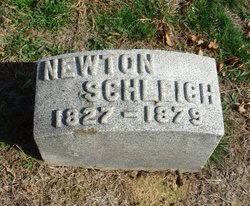
On July 21, 1861 the Josiah or George Warren Band of New Harmony was resting. (I am not sure whether this was the father or the son's band) I don't know the location. In a bundle of letters by William Baldwin of the Civil War, stored away at the Workingman's Institute he mentions that Brigadier General Newton Schleich sat on Baldwin's large drum. The Ohio, two-term state senator turned General was drunk. Baldwin told him to get off of his drum. Later Baldwin was ordered to apologize to the General, but refused. The band leader Warren later made the apology. Five days later the General was relieved of his command by General Reynolds after being a General only three months. Schleich was described by John Betty of "The Citizen Soldier," as "a rampant demagogue. He is what we call a tremendous little man, swears terribly and imagines that he therefore should show some snap. Snap in his opinion, is indispensable to a military man. It is the only thing he needs along with profanity. Schleich is a second Napoleon in his eyes." The little General was a lawyer and state senator from Ohio for two terms. He started out as a newspaper editor of the Ohio Eagle in the 1850's. After relieved of his command he went back to Ohio for a while and became a recruiter and commander of the 61st Ohio Regiment and soon after being sent into battle poor health required his resignation. He is buried in Fairfield County, Ohio. Josiah Warren was not only a musician but an inventor. In Boston he invented a lamp for burning lard and it was the only artificial light then used beside the tallow candle. The patent was signed by the President himself, John Quincy Adams. He also invented some things for the printing press in the 1830's signed by Andrew Jackson. Warren was interested in the Robert Owen Harmonie movement and he sold out his lamp factory and moved there. He found refined people but the lack of individual ownership of property and personal individual liberty soon discouraged him. The Warren Band was an important band of long tradition of New Harmony. In 1843 the band loaded up in two wagons to play in Evansville at a hotel run by a man named George L. White who lived in New Harmony. The Warren band was made up of all Democrats and earlier was hired to play during the presidential campaign of Democrat Martin Van Buren vs. Whig William H. Harrison.
Story behind Evansville Museum Cannon.....1861-1865

Out there by the Pagoda in Evansville is a four-pound cannon mounted on a limestone block. During the Civil War, Captain Henry Dexter of Evansville a strong Unionist would haul supplies and troops down the Mississippi in support of the Federal Army. Early in the war he had a contract to deliver mail to Ohio River ports. He got word that a mob planned to attack his boat, the "Charles Bowen," at Paducah, so he installed this cannon on his deck and scattered off most of his attackers. When the war ended, the former West Virginia native placed the cannon in his front yard to use as a hitching post. When he died in 1872, it was dug up and mounted on the limestone block. In 1910 it was placed at the intersection of Main and Water Streets. It was used to record flood levels. A 1884 flood mark is still visible on the block. Placed in storage in the 1930's it became property of the Board of Parks and during 1942 it was brought out with a sign reading, "Bring On the Japs!" The museum acquired it in 1969 and was moved several more times on the waterfront before it found a home it is at today.
1850's
Poseyville Speaker Rants at "Know-Nothing Conservative Party"....April 1855
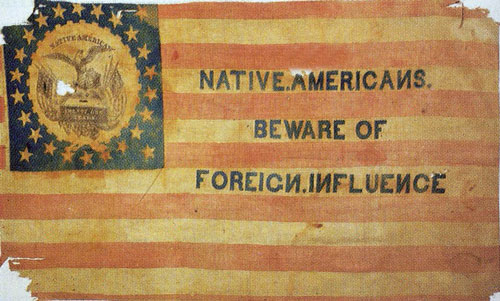
Col. Drew made a speech in front of maybe 30 men assembled, berating the "Know Nothing Party" for a number of reasons including a Temperance Act, that the people of Indiana had not wanted or asked for. This party of the early 1850's wanted to "purify American politics limiting the vote especially to the Irish, German and Catholics. They wanted only Protestants to vote and an immigrant must have 21 years of residency. The name came from their need of secrecy. When asked who forms your party or the members they were coaxed to say: "We know nothing." Their high point was around 1854 when they had 43 representatives in Congress. The next election they had 12. Their real name was the American Party. These conservatives soon fell out of favor with both the left and the right. In Poseyville that day, Drew with passion and finger pointing called out those of their persuasion who were trying to destroy the liberties of the country and those who had died for them. At the end of his speech he was said to have trembled with passion as he lashed out against them. He said, "Let's recess for a spell," then he passed around his own private jug of whiskey and the drinking carousal began without further speakers.
Famed Daguerreotype Photographer Back In Evansville.....December 1854
Edward Z. Webster was from the east coast originally having a studio in Connecticut, later in Evansville for a couple of years and Louisville. He started in photography around 1845. He is known for having taken early photos of General Taylor, General Johnston and the home of Benedict Arnold. In 1851-1852 when he lived in Evansville, he and his brother Israel had a studio above a confectionery store on Main Street. When a permanent store was put in Louisville, Edward would travel about, extending the business and showing the marvels of the new age. His photos on glass were sometimes put to paper and colored by the artist. He eventually went back to Connecticut to live out his life.
Evansville Journal Holiday Greetings......1854
Thanksgiving..."God will be worshiped in hundreds of churches in this happy republic for the multitude of blessings bestowed upon us."
Christmas...."For the rest of mankind a Merry Christmas. Have this day with joy, let not our seats be vacant in our sanctuaries."
Young Poet Buried at North-McFaddin Cemetery....His Fallen Stone Hidden Forever from his Fellow-Man....1853
"How cold to us this world appears, when no sweet voice is heard. To claim our triumphs and to speak a kind approving word. But Oh! When all we have below, Stern Death in ruin lays, We'll hear once more, as soft as yore, the voice of other days.".....That is just a part of a poem of the author born in Mt. Vernon on April 29, 1827, the son of Jesse Y. and Elizabeth Welborn. He was born in the Welborn home on the south side of West Second Street remembered as the "Farmer's Hotel." The home was shadowed by ancient trees of a long ago forest with spacious grounds. Here George York Welborn studied for a future he would never see. At age 19, he was a law student in the office of future Governor Alvin P. Hovey. In 1849 he was in the freshman class of Ashbury University and died January 25, 1853. It was said in college that he was a favorite, a man of high ideals, cheerful, with winning manners. Greencastle loved him. A professor there said he was all that was manly and good, a good prose writer and learning poet. He wrote many manuscripts dated in 1852. That was the year his mother passed and it was said a year that a love affair went by the wayside. He was said to have had premonitions of an early death.....A man of promise that we can't bring him back; but a part of him, "a voice of other days" ....we can.
1840's
Another Plank Road was Once Envisioned.....November 5, 1849
Besides the Old Plank Road between New Harmony and Mt. Vernon completed in the early 1850's another was envisioned. At a called meeting of the Evansville Common Council, they resolved that if the citizens of St. Louis and of Illinois and the town of New Harmony raised sufficient stock for the construction of a Plank Road from the bank of the Wabash opposite New Harmony to the bank of the Mississippi opposite St. Louis, the city of Evansville guaranteed the completion of the line from New Harmony to Evansville. A letter was given to the Evansville Mayor to take with him to the St. Louis mayor concerning the proposal.
Elisha Ellis Gets Gold Fever.....1849
Elisha, son of John Ellis was born in 1805 and when a youth of thirteen he went with his uncle Elisha Phillips to Posey County from Niles, New York. They came down the Ohio to this wild country and settled. When he reached manhood in 1828 he married Hannah Bradley and purchased a farm in Farmerville, north of Mt. Vernon. He said that when he first saw Mt. Vernon in 1818 it had but a few log huts. In his youth he was a carpenter and a cooper. He went back to Niles when he was 21 for the last time to visit his parents. In 1849 he headed for California, by way of the Mississippi River, Isthmus of Panama, which he latter crossed by foot, and sailed on a vessel to San Francisco. The vessel 90 days from port was reduced to exceedingly low rations and water. He stayed about a year before returning home and lived a long life into his 80's.
Deadly Accident in Posey.....March 1846
"It is our melancholy duty to chronicle" read an Evansville Journal story of 1846 of the loss of three Evansville residents, George Schlamp, John Schnell, and Fred Sauter who drowned within a mile of Mt. Vernon. The three men with two others, were subpoenaed to attend the Circuit Court in our town as witnesses for a civil case. They were in a two-horse wagon and they had to cross a creek or bayou (McFaddin's Creek) which was full and being outsiders they were ignorant of the depth. Schnell, who was driving thought it fordable and drove the horses in and it plunges off a bluff into twenty feet of water and all men were immersed. Jaob Kehrt reached shore and by the aid of a stick he held onto for fifteen minutes finally got out. He tried to aid Sauter, but the stick broke and Sauter never came back up. Schnell was found still holding to the horses and dead. Mt. Vernon soon learned of the accident and the lawyers headed to the spot and found all three of the bodies and released them to Evansville where they were buried in one grave. A long line procession followed them to the cemetery including the German Washington Guards, the Society of Odd Fellows, the Draymen and two Fire Companies. Sauer had recently married and the other two were single men.
After "Honest Abe" Spoke, Future Mt. Vernon Judge Takes the Podium.....November 1844
Mr. Lincoln, of Springfield, Illinois addressed a large audience in Rockport, Indiana at the court house and spoke on Whig policy. His main argument was in support of the advantages of a protective tariff. Few details in the paper were outlined, except that he addressed all subjects "in plain argumentative Whig style that brought honor upon him and his party." When he closed, Mr. John Pitcher arose and delivered a speech in his forcible and powerful manner. "He exhibited the democratic policies in an unenviable light at least we thought so." From here the campaign would be coming to a close and on the following Monday the question of who would be President would be decided, either Henry Clay or James Polk. Indiana voted for the Democrat Polk by a 50.07% to 48.42%. In Posey the margin was far larger.
Local Judge Loses Race for Legislature because Voters Didn't believe he was a Democrat.....1842
Eban D. Edson lost once for the legislature (he would win eventually) because people accused him of being a Whig. Eban even wrote a rebuttal after the election to the Indiana Statesmen newspaper saying, "I would never turn Whig!" Local paper editor said, "I was stumped when my friends asked me if he is a Democrat, for I never yet heard him advocate Democratic principles either from the stump or with his pen." Edson lost by 140 votes although he took Vanderburgh County. Funny his son, William P. Edson, also a judge and a legislator from Mt. Vernon was a Democrat until the Civil War then became a Republican. Not taking it too hard...in 1861 ~Wavy would be a Republican.
John Pitcher Must Have Been One Great Lawyer and Judge.....1830's or 1840's
John Pitcher friend of Abe Lincoln and many other prominent men knew his law books. Hesitant to loan them, he yet did so to Lincoln and to Alvin Hovey. In Hovey's case he tried to push him aside giving him a worn legal book of the most difficult material to understand. Hovey cherished it and became knowledgeable in it so much that he showed Pitcher he was sincere. When Pitcher came from Spencer County to Posey in 1835 our pioneer courts weren't much to look at, but were filled with many good men. A story of Pitcher was told by Robert Dale Owen in 1877 of a case of Pitcher's. The local Circuit Judge was aided by two Associate Judges, who judicial services were paid at the rate of three dollars for each day of session, no mileage or other expenses being allowed. The judge for some reason temporarily vacated his seat this one day and the elder of the two associates presided. The temporary judge sort of lean in stature and fat in temper. In such occasions it was a good bet a collision might occur. Pitcher who would later be Judge of the Court of Common Pleas was then council in a case. Somewhere along the line, these two men had met before and Pitcher had offended the judge presiding who bore him a grudge. It was a case for damages and Mr. Pitcher, returned for the defense, turned to the jury and made part of his remarks in Latin. "There is a legend maxim, applicable to this case to which I invite your attention...de minims non curat lex." Here he paused, intending to add the translation, but the judge broke in. "Come Pitcher, none of your Pottowattamie! Give us plain English!!" Pitcher, without turning his eyes from the jury, or using a gesture that he had heard the remark proceeded quietly in his speech for more than thirty minutes when the judge broke in again. "Come Pitcher, hurry up, none of your Pottowattamie gibberish!" Pitcher summed up saying, "gentleman of the jury, this case, at last rests on the well known legal axiom of some, which I on a earlier occasion brought to your notice....de minims non curat lex, which I will minimize and reduce for the head of this court to recognize in his limited capacity means law does not care for trifling things and turning sharply towards the diminutive figure of the judge, showing no manner of judicial dignity towards him....said, "neither do I...this case is ridiculous!" I can just hear the gavel coming down hard, the jury laughing and the judge red in the face. "ORDER. ORDER....WE WILL HAVE ORDER!"
1830's
Yankee Girl Heads to New Harmony and School.....1830's
After a long tiresome journey from New England to Princeton, Indiana, a young lady, still in her teens arrived at Princeton at nightfall. She went to her hotel and found to her dismay that she would have to stay two nights and a day as the stage coach only made the trip to New Harmony every other day. Asking the driver how much it cost from the depot to the hotel the driver told her, "two bits." She didn't know what that was. "The driver smiled and said, "Reckon you are a stranger here." Trying to find something to do, the young Miss went for a walk, but was frightened at the hogs that were on the street and hearing residents laughing at her, she returned to the hotel and spent the rest of her wait indoors. A couple of mornings later the stage finally headed for New Harmony. She was the only passenger, but the driver was talkative and named several interesting tidbits about the town and its people. The log cabins came into view with cattle and hogs roaming at will across the road and she was amused and thought what she had got into. She had been hired as a teacher, a private one with a school room on the second floor of the old Rappite church. Desks were built against the wall and benches were used for seats. The pupils faced the windows with their backs to the teacher. A b c's were the first things taught. One little boy was bad and had to be punished. As the day ended one little boy went to her and said, "You better not go by that boy's house or his mom will whip you for punishing her boy." (The Owenities did not believe in corporal punishment.) This was a surprise to the young teacher, but she took the boy's advice and went around another way home. It all worked out and years later, some of her first pupils became teachers themselves.
19th Century Token...Maybe David Breece
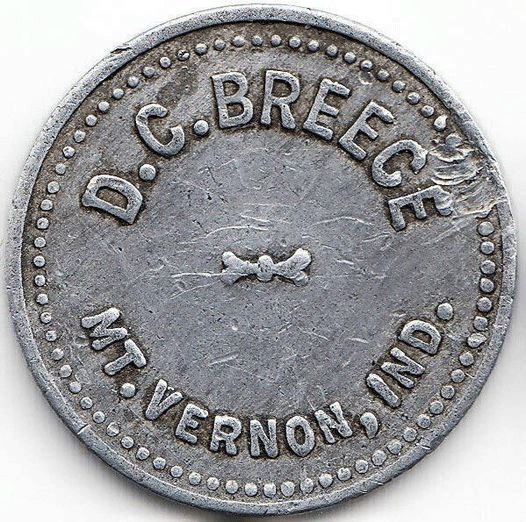
Saw this item on E Bay recently. This past year we had a man come and give a talk on early coinage and currency to the Posey County Historical Society. He passed around some tokens like this that were used as coins...bartering really with certain merchants. Hard money was hard to come by early in the ninteenth century. John C. Leffel, the publisher of the Western Star did some biographies of people in his 1913 "History of Posey County." He mentions a David Breech, a prominent farmer, raised in the woods of Posey County. He was born in 1812 and by the time he was 22 years of age he began working for himself, receiving $10 per month for his services. He became very prosperous and owned over 500 acres of excellent land. I don't know for sure if this is the right Breece but it's a good chance. Regardless, it is a nice piece of forgotten lore. It's difficult to find accurate merchants as few references are found readily. Mt. Vernon newspapers have not survived prior to 1867. Sometimes a book, the internet, maybe a New Harmony paper prior to this date reveals something. I am always looking for tidbits that give us a better knowledge.
James Evison - Old Time Local Merchant.....1830's
Where the old Rosenbaum building stands west of the court square, there was once another Rosenbaum building that burned in 1893. Way before that in the 1830's and 1840's was a home on Main Street owned by a tailor named James Evison. Our town's business district wasn't as large as it would become so many homes were along Main prior to the Civil War. Everson was born in England in 1809 and traveled up from New Orleans to Mt. Vernon when he was 25 years of age. He met a girl named Mary Ann Broadhead, married in 1855 and had 7 children, all of which died in infancy but one. His daughter Mary graduated from MVHS and became a teacher. James was too old for the Civil War but he was a member of the Home Guard.
The Militia of the United States.....1831
I was reading in the New Harmony Disseminator of March 1831 and it had a notice that the militia of the United States....you know that, "well regulated one necessary for the security of a free state?" It said the militia had 1,228,502 men. So, the free population of that time was 12,866,020 and another 2,009,043 slaves. So lets say half the amount would be 6 million men. America was not yet much of professional standing army. Citizen-soldiers they were called. Most were controlled by the states not the federal government. Washington did send out training manuals to the states. They were not all that well trained up until thirty years past the War of 1812. Eventually, higher standards of training, discipline and doctrine took shape with U.S. military schools providing officers to fight the Indians and soon the Mexicans. Yet today, we argue, at least I do, about the intentions of the founding fathers of the 2nd Amendment.
What Led Up to the Hoop Pole Fight in the 1830"s .....
We longtime residents have grown up with the story of the Hoop Pole Fight of the Coopers and the Rivermen. A found something that says that when river traffic started to increase at our riverfront, cooperage shops sprung up to make the hoops for the barrels that were shipped all along the river to distant points. During the busy season we stacked up the barrels all along the shore to be ready for shipment. Some were stacked several high. It was said our village itself was nothing but barrels, at least that is the way it looked from the boats. When the boats would come in the long boat poles would sometimes swing their poles wildly knocking over mountains of barrels and they would fall into the river and drift away. Below town there was a subculture of people who would make a livelihood just retrieving the barrels for a fee. They say the drunken riverboat people sometimes would burn our barrels in large bonfires so there may have been even more than one bloody hoop pole fight in this here "Hoop Pole" township.
"Another Cup of Coffee for the Road".....Southern Indiana....1830
Population is growing, McFaddin's Bluff is now Mt. Vernon and "Hoosiers" are making money. Boats daily descend our great Ohio and Wabash rivers heading south. Newspaper editor said in Evansville, "this is indeed a land of plenty and abundance." The old editor would get down the coffee mill and place it between his knees and fill the hopper with a pint and start his brew. At home the coffee was parched in a heavy skillet, stirred over a hot stove until the black color showed it was done. Usually, a small boy would use a long spoon to keep the coffee from burning and give to his dad when done. The editor had a kid too and found that to be one of his duties in the print shop. Later on, commercial brands came like Thorton's and Arbuckles, but it was many years before ground coffee could be bought already to put into a pot. Human advancement is fast now, but seemed slow then to us, but maybe it was fast for them in their time. I am sure the 1%'ers did well as capitalists. I mean let us look again at the river...In March of 1830 it was said, over 1000 boats were loaded and passed down the Ohio River. They had lard, cattle, horses, oats, corn meal, chickens, corn and all sorts of things farm related. Eventually, wood and wood products went downstream, including furniture, constructed boats from New Albany, whiskey, and Posey pumpkins and barrels I imagine. Must have been a sight to sit on a bench or a rock at the riverfront, light your corncob or clay pipe settle in with a cup of java and watch the steamboats.
1820's
New Harmony Gabriel.....1829
A story found at the Workingman's Institute in New Harmony speaks of a Mr. Hornbrook who in 1829 was having trouble with wolves coming around his cabin during the night. He would get up and blow a horn frightening them away. Aw yes, a nonviolent resister making personal choices with his political vision.....well, that's how I hoped it was....Utopians are a special breed.
Francis Wright Gives Address in New Harmony....July 4, 1828
The main speaker of the New Harmony Independence Day festivities was a woman...think of that. That didn't happen much way back then, but this Scottish educated lady who came to America with General Lafayette was no ordinary lady. She had met Thomas Jefferson and James Madison and she was going to be heard, bold or illegal she would not be silenced. She was known as "Fanny" and was great admirer of the Rappities and the Owen utopian experiments. She too had a place near Memphis, Tennessee called, "Nashoba" where she had slaves educated and prepared to send them back to Africa if they were willing to do so. Wright was so controversial for her time as most visionaries are....she was for free public education, labor unions, the emancipation of slaves, equal rights for women, sexual freedom and agnosticism. She pointed in her speech to the Negro slavery and degradation of their citizens as one evil not touched by the founding father's constitution. She feared that because of it we were bound to one day have a violent revolution. She condemned blind nationalism disguised as patriotism. "Be loyal only to the principles that lead to human happiness," she said. "Favor human improvement."
Two Killed by Indians Near Mt. Vernon.....1828
It is said Julia Fairchild Monro or Monroe was killed by Indians close to the Ohio River along with the wife of Andrew "Tweedle Dum" McFadden. The McFadden's were parents of Miranda, a future wife of Edwin Monroe. She had been with the two women and was half scalped and bore the scars until she died and was buried at Bellefontaine in July of 1884.
"No Intelligence Between Louisville and New Harmony".....1828
Last week I was visiting with former teacher, Nonnie Dewart and she mentioned my title which I thought was interesting and I questioned her about it. She had come across it in her readings long ago. She gave me one of those looks - kind of hard to describe, but she freezes, with her head turned just so, and smiles beautifully. What a wonderful person she is! Nonne is 90 years old and you would never believe it. We sit and chat and she told me "we have only scratched the surface." I will have to get back for another visit. She said that long ago the newspaper in Louisville made the comment about intelligence referring to the lack of school knowledge and culture west of Louisville. The Owenities brought in the "Boatload of Knowledge" after the Rappites left, and the more you think about it, the more it was correct. Nonnie said she was sitting and thinking about what she could do for Mt. Vernon. She told me about the Story telling lady she had seen long ago. She thought that would be a good project for me to try and direct attention to. I told her ~Wavy is the nervous type...how Miss Lucille Redman would laugh at me and my nervous ways on the stage and how my stomach would get caught up in knots anticipating a speech in her class or Mr. Hedges. She thought I was kidding. No its true. People are always trying to get me to do more - meetings, organizations and even talks. ~Wavy don't like that! I have to take a Xanax to see her or former classmates who want to chat with me. Ain't right, but that is who I am. Once I settle in, I become more talkative, long as I'm sitting, but get me on my feet.....noooo....I hate that~
County Militia Musters 1820's and 1830's
After the Rappities left, the Owenities did not seem to be so against forming into military order. In 1826 we find a Zachariah Wade holding regular regimental musters. They had several officers like General William Twig, General James Drake, Col. Zachariah Wade, Col. Jesse Nash, Col. Clement Whiting, Captain W.J. Lowry, Lieut. John Allison, and Adjt. Allen. They liked to dress up these officers. Reports say that had pretty uniforms - a blue coat, cut swallow-tail with red tape sewn on the breast and adorned with a double row of huge brass buttons and tinsel epaulets. They carried a sword at their side of their buckskin trousers and walked in moccasins. On their head was a huge three-cornered hat with a large waving plume. Quite dandies. Now the militia guys, the grunts, they didn't look all that well. Come right out of the fields looking like a frontiersman, not so proper to make a minuteman statue, but typical of the day. They lined up, got squared away carrying them muskets, rifles, clubs and corn stalks and marched and drilled. Many sections of the county were said to have had drills. I guess they were worried about Indians...maybe vigilantes. Mt. Vernon was said to have had a drill field east of Milton Black's. They may have been referring to what I remember being told of Camp Link. Sort of hard for me to place. I have heard of it being north of the depot and some saying even near the water tank. Not sure. There was another said to be near Blairsville and several in the vicinity of Springfield at a farm owned by Lewis Wilson. In 1834, a law passed allowing persons to pay a dollar as a way to get out of performing military duty and by 1837, the law requiring militia musters was repealed totally.
Edward Murphy of New Harmony, Looking for a Home.....1826
Edward Murphy was a "friendless and barefooted Irish boy who came to New Harmony in 1826 to find shelter." Born in Cork, Ireland, he ran away when not yet 13 years of age from Washington to New Harmony. Here he remained the rest of his life except for seven years in Evansville. He tried many occupations like painter, tailor, merchant and many times a laborer. He went off to study medicine in Louisville then returned back to New Harmony where he found wealth and love. He married Sophia Johnston from Vincennes and they had six children, but all died young. Sophia's father was a general at one time and a member of the territorial legislature. For a while Edward chaired the chemistry department at the Evansville Medical College. He didn't have much faith in God it seems, but "worshiped God by serving men." He spent 75 years in New Harmony and helped build a library and filled it with great copies of paintings he commissioned from Europe. They are now on the second floor of the Workingmen's Institute on Tavern Street. He gave many books to the community and Murphy Park was made with a beautiful iron fence and where able lecturers gave their speeches on a stone base. He left large sums of money to New Harmony including funds that became Murphy Auditorium. He died December 3, 1910 and his wife a few days later...always to be remembered in the town that he loved.
Barnabas Annable of Mt. Vernon writes to Eastern Relatives of Impression of Owen Community.....October 1825
Barnabas wrote that a big topic of conversation was Robert Owen in New Harmony and his "Social System." He asked his relatives if they had heard of the man and his speeches to Congress the previous March. "There is a flocking to his standard of rich and poor from all parts of the United States and many from Europe. I have been to see them, went through their schools, of about 150 scholars, and looked at the laboriousness of teachers who are not allowed to chastise them. I have made a rather favorable estimate of their community to which is enlightened part of the western world or States." ......"Should you or anyone else be converted, please direct them to Posey County, As for religion, his worship house doors are open for all denominations, Brahamms, Mohammedians and even Deists not excepted. He urges the necessity of charity and thus shames the Christian world. His love of mankind is apparently great. There is much more to present." The next year he wrote: "Mr. Owen professes love for the poor of mankind, but is prudent with his own money or fortune. With me it is a paradox as I read the scriptures. Owen says as much of Jesus Christ as Mohomed (sic) had, but applies those which the prophets wrote of Christ to himself. His papers are quite entertaining, and there is something appertaining to his system to be found in almost all his newspapers. I think his system will revolutionize Europe before it will America, therefore, it will be a long time before I may expect to see you here on a pilgrimage to him as to Mecca or Medina."
The Ghost of Blackford.....1820's
In October of 1816, the first session of court was held in the town of Blackford, in Posey County. It wasn't long before people became dissatisfied with the location of the county seat there and pushed for a more centrally located place. In May of 1817 a new town and new county seat were approved....a town called Springfield and lots were sold by Frederick Rapp. Soon a tavern went up and on the day of sale whiskey was furnished. Blackford became a ghost town and its few inhabitants left leaving the grounds with few buildings falling into ruin. Honeysuckle took over in the summer covering the desolation and in the winter...snow. One of the buildings was a small jail, the first county jail of Posey, constructed of double logs which survived almost to the 20th century. Over time legends and stories came pertaining to a spirit there. It was said on Halloween night the spirit would form among the logs in the still of the night when all you would hear would be the cry of a whippoorwill or the rustling of leaves. It was usually midnight or slightly after when the lonely vigil would come...a strange phenomenon of another time. The story goes that living in nearby Blackford was a pretty miss who had two suitors for her hand who were sworn enemies of each other. One October a new family came and the covered wagon they had proved to be too uncomfortable as living quarters. As was the tradition of the times, a house raising was held with neighbors, the pretty miss and the two rivals in attendance. The men went to the woods to cut down trees; and doing so, one of the men was killed when a tree fell upon him. Never proven, but it was generally thought that the one rival handling a guy-rope purposely swung the tree so that it would land on his competition for the young lady. The girl who was close by ran to the spot where the boy lay dead, lifted him in her arms and fell into tears and sorrow with great emotion. Here too her heart was broken and she left it there. This sweet cute country miss never recovered from the shock she received that day and became senseless and she would go to the little abandoned jail and cry bringing on an early death. So on Halloween night, in the ruins, her ghostly spirit can be heard crying and sometimes her form would go floating through the woods to the very spot she was separated by her true love.
The "Cry" of the Rappite Night Watchman.....1823
"Come unto me, all ye people. Midnight sounds from the steeple. Ten gates hath the city of gold, so gather we now to the fold. It's one step nearer the end, another day passed. The sands of time are running low....It's one step nearer to the end." ......The Rappites believed that Christ was coming back immediately within their lifetime and they mostly practiced celibacy.
Hanging Out His Shingle.....1822
Mt. Vernon is in need of the law and in the Evansville Gazette newspaper we find this: "Daniel S. Bell has opened his office of Attorney and Counsellor at Law in Mt. Vernon, Indiana and will practice law in all the courts of the fourth Judicial Circuit of this state; also, in the Supreme Court and the district federal court of the United States, for the district of Indiana."
The Harris House.....1830-1921 Razed
In March of 1921 an old frame building at the extreme end of East Second Street, one of the oldest in our town and last occupied by Richard Bolin was torn down. On the night of October 8, 1878, this house was occupied by the negro Dan Harris and shortly after midnight Sheriff Ed Hayes and his deputy Oscar Thomas went to the home to arrest a son of Harris, and as Thomas passed the southwest window of the house, a shotgun was fired out the window by the old man and entered the left breast of Thomas and he died a short time later. The killing of Thomas resulted in three days later the hanging of three men at the Public Square by a mob who started their march from Black's Grove. Harris was burned in the furnace of an L&N locomotive on the tracks near the depot. No one was ever charged. Oscar Thomas lived in a brick house on the corner of the first alley and College Avenue. The bodies of the black men were not removed from the Locust trees until the Thomas funeral procession passed the court square.
Excerpts of the Ellis Family Letters in Posey County to New York Relatives.....1820
One of the pleasant surprises with my interview with 90 year old Mrs. Robison was a book she had on the Ellis and Annable families who traveled down the Ohio River to Black Township. Elisha Ellis and Enos and Bromley Annable came first to Indiana going down the Allegany and Ohio rivers on boats and rafts. Samual Annable followed soon afterwards from New York and became an early Posey school teacher. Families started and the Annables married into the Phillips family, for one living in the Farmersville area. It gets confusing to me so lets get to some of the letters that survived. Ruth Annable, wife of Barnabus wrote to Dr. Annable in New York that traveling to Indiana with 19 people was very dramatic. Once they hit a root and landed with a thud on a sandbar. They were very frightened, especially the children. "We thought we were gone for it." Her stomach became weak and could not eat for a 24 hour period from all the shocks of the journey. Her children were sick too and fatigue was suffered by all. "I held my children on my lap till I could hardly stand on my own feet." They traveled the Ohio day and night and they were always afraid they would run onto fallen trees. They stopped in Cincinnati where they met old friends. About a hundred miles south of that they dropped off a "disagreeable" family of which they were extremely glad. Ruth said they had been robbed on the trip of stocking, yarn, pillows and a gown. They landed in Mt. Vernon on the 22nd of April 1820 in good health, except for herself who was weakly for a month afterwards. At first they had to do without meat. They bought two cows, but never got more than three quarts of milk from them. She said the people of Posey care for nothing but corn and hogs. "They use a few beans, which they call snaps." She knew men who had lived in the area for twelve years and there was a meadow that she saw that had a tremendous about of hay on it.....more than she had ever seen. Potatoes could be raised by the acre, sweet potatoes in abundance...."the best I have ever ate." They raised some cabbage, small turnips, 300 pumpkins and 350 bushels of corn. They sowed 13 acres of wheat and had two cows and four calves, a one year old mare, seven yearling hogs and eight shoats. All this after one year...."We fared hard this year, but have no reason to complain, for my family was never so healthy as they have been here." As far as neighbors were concerned she wrote: "I am not discouraged about getting a living, but the people do not seem natural. We have not received a visit from any woman since we have been here, excepting two of our own country people." Her farm must have been a nice one as she said it was handsome, well watered with two springs on it and plenty of fencing timber. They built a house with a cellar under it, with a corn house 17 feet square on blocks. She said she had not seen a stove yet in the county. "The people are very ignorant of house wifery and a different way of cooking. We have a brick oven and hearth. I make the best pies." She went on to say, "The wheat here grows better than New York state and the bread is excellent. The fruit is better too.....blackberries are plenty, and the peaches are great. We have muskmelons and watermelons in abundance, and we have a nursery of 2000 apple trees growing. It has been very healthy in this place and have had no need for a doctor all summer." She mentioned that salt was scarce as was sugar...corn whiskey was 75 cents a gallon, and wheat whiskey a dollar.
1810's
Posey Representative Dann Lynn Writes Frederick Rapp about Militia.....1818
Little is known of the first Representative of Posey in Indiana. He came here from Kentucky in 1798, was a farmer, a ferry boat operator, owned land and took corn down to New Orleans by flatboat. He held slaves in Kentucky but freed them when he entered Indiana. He lived for a while in what became Lynn township, and was a friend of the Rappities. It was in fact the relationship of the Harmonists that moved the county capital from Blackford to Springfield. Alvin P. Hovey, once answered a query to Indianapolis on Lynn saying little much was known, except he was "quiet, cautious and very politic man with a fair English education and a leader of men." Lynn wrote an essay to Frederick Rapp in January of 1818 about his illness (hadn't taken nourishment in 9 days), his doctor bills, and local bills being discussed at the state capital, then in Corydon, Indiana. One issue I found interesting was a bill on the militia. Remember the Rappities followed a form of pacifism. Lynn wrote: "The militia bill is now before the house and from its length I think it will take a week to pass it. We are trying to remedy some defects in the bill, all those conscientiously scruples. (moral objections) We want to place them on an equal footing with other militiamen and give them every chance to make their Excuse if there be any from home or business or sick give them a chance to make their Excuse is what we are trying at, I am rather of opinion the Bill will pass in that way....informed that a letter was forwarded from the speaker setting forth that you are Germans and will not give a fair list of your Militia men. If I mistake not on hearing the letter, Mr. Jones applied to you for a list of names and you refused to give the list, &c. &c. by which no fines have been collected......I am with sentiments of yours." Dann Lynn.
John Pitcher became Rockport's first city attorney in 1818
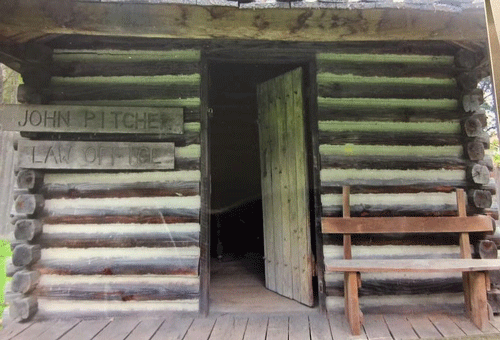
This was what his first law office was said to look like in Spencer County. Abe Lincoln lived 17 miles north of Rockport and would often walk the distance to borrow and return books. His desk was said to have been moved to their courthouse. When he moved to Mt. Vernon, he lived on what is now College Avenue and mentored Alvin P. Hovey and William Harrow as lawyers, both became Civil War Generals and Hovey the Governor of Indiana. Pitcher lived into his 90's and was a great orator, speaking all through the county and even at the dedication of the Vanderburgh County courthouse. I have been told that Lincoln wanted to nominate him as a Supreme Court Justice but he refused. Pitcher is buried here in Mt. Vernon at North Cemetery. A son became Superintendent of West Point.
"Muster Day" - McFadden's Bluff.....1816
Recently. a pioneer family, the Duckworth's gave us an old copy of the "Naming of Mt. Vernon." Probably put the entire document in the Bicentennial book. Without giving it all away for free, let me point out that it was on "Muster Day." This was holiday in early times, one of the few we had then. In came in late summer or early fall when the men folk would bring their fire arms to a central place and someone would look over their weapons, amount of powder and balls. It was a holiday of readiness in case of war. After all, our young country had been fighting Indians and two wars with the British. There would also be lots of drinking and eating after inspection. Samuel Rowe seems to have been given credit for suggesting the name Mt. Vernon after the home place of George Washington. Other suggestions were mentioned, but they have been lost to history. Remember we only had around fifteen families in our village then. What is significant about this document is that every one of the men present are listed. Looks like about 26 names or so, and many have the same last name. Many are familiar to me from studying our local history. You will have to get the book to see its entirety, but one name at this moment stands out.....Dann Lynn. He was our first representative at our capital then in Corydon, Indiana. We hope to have a monument to him this summer as the state of Indiana wants to lay a wreath to him. Stay tuned....Oh, if you would like to contribute to cost of the monument, contact Becky Higgins.
44 Pioneers Come to Cynthiana in September of 1815
Forty-four persons came from Cynthiana, Kentucky to Cynthiana, Indiana in 1815. All were linked together by marriage or kinship. The migration came after the War of 1812 and settling of the Indiana territory after the campaign of Tippecanoe. Some say many left because of cholera back home which hastened their departure. Over 115 people had died there within a decade and conditions were terrible. It was time for a new start in a fresh land. Some of the surnames of the 44 were Casey, Endicott, Eaton, Jacquess, Rankin, Hirons, and Ferguson. Of this group came the first recorded divorce recorded in Posey County. A tragedy of this group also included a Joel Ferguson murdering his cousin Henry Casey. Joel had been the town outlaw and was thought to have been mentally disturbed. He broke out of the jail and escaped they say to Oregon.
1800's
River Pirates on Ohio at Cave-In-Rock, Illinois....circa 1800
Early in the 19th century or late 18th century a man named Wilson brought his family to the cave and made it a dwelling and a tavern. He placed a sign at the water's edge that said: "Wilson's Liquor Vault and House of Entertainment." River traffic coming from as far north as Pittsburgh on their way to New Orleans stopped, drank, visited with the women and were robbed. Many times their boats were taken with a new crew and their cargo sold in New Orleans for the outlaws. Wilson was said to have had over 45 men at his disposal and when he was killed, 60 skeletal remains of victims were found at the site. Later Samuel Mason took over the cave, who had been a captain in Washington's army. He ran into trouble after the war trying to make a fast buck and was thought to have committed three murders at Red Banks (Henderson, KY). He moved on to Diamond Island and then to Cave-In-Rock. Again women and whiskey were the draws. He also placed people on different islands that acted like they were stranded or shipwrecked and they wanted to be taken to Cave-In-Rock. When done so, the crews fell in the jaws of the trap. These were just a few of the known robbers and bad men who preyed on travelers. There were many others like counterfeiters, Billy Potts, and the Harpe brothers one of which had his head stuck on a stake as a warning to new outlaws.

